





REBREATHERS PART 2






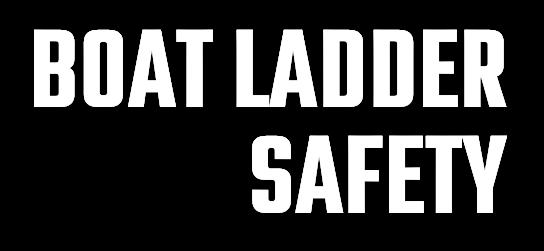



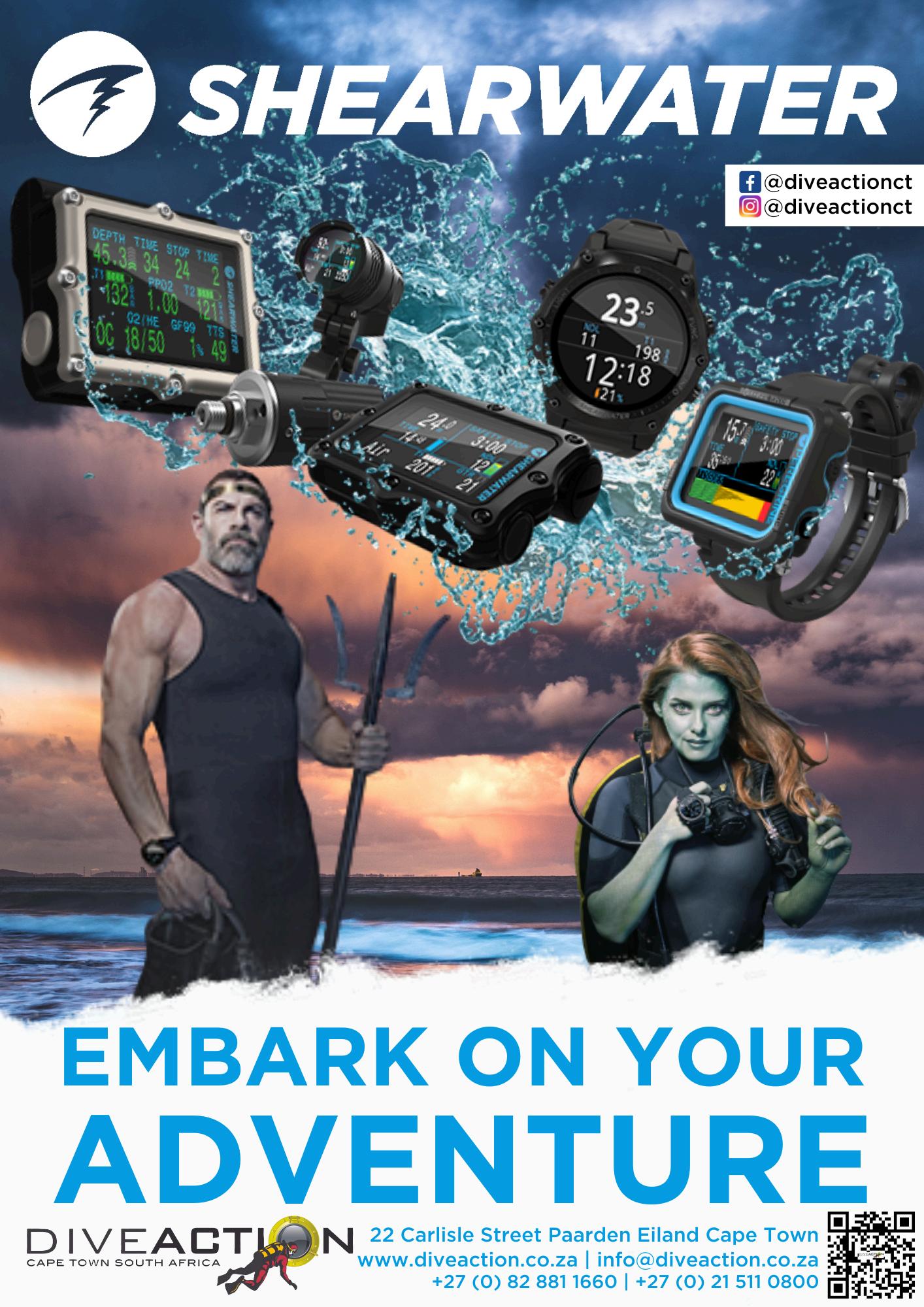
Editor
DAN Southern Africa
Publisher
DAN Southern Africa
Contributors
Nicolene Olckers, Dennis Guichard, Francois Burman, JoAnn Haack, Claudio Di Manao, Kyle Kray, Dive Action Team, Mark Powell, Adam Sokolski, Ivan van Heerden, Gustavo Mauvecin, Madeline Coombs, Frauke Tillmans, Jessica B Adams, Stephen Frink, Guy Thomas, Raoul Coscia
Team
Morné Christou, Nicolene Olckers, Dr Frans Cronje
Cover Photograph
By Raoul Coscia Porcelain Crab (Porcellanella triloba?) on carnation soft coral (Dendronephthya sp) | Dive Site: The Galaxy, Raja Ampat Central
On this night dive I was hoping to spot a Pygmy seahorse among the soft corals, and instead I caught the glint in the eye of this tiny crustacean reflecting my focus light It was probably a juvenile and quite transparent and I love how it blends in with the orange soft coral They are quite camera-shy and I only managed to snap a few frames – this was the only one in focus - before it scooted away to hide behind the polyps These strange creatures are not true crabs, but closer relatives of Squat lobsters
Equipment: Nikon D810 + Nikkor 60mm lens in Isotta Housing
Settings: 1/200 sec f/14 ISO 100
Lighting: 2x Inon Z-330 with diffusers
Contact
Website www dansa org
Advertising mail@dansorg
General mail@dansaorg
Phone +27-11-266-4900
Diving Emergencies +27-82-810-6010
@dansouthernafrica @divesafety /DANSAorg
@dan sa org
Alert Diver Philosophy
TheviewsexpressedbycontributorsarenotnecessarilythoseadvocatedbythepublisherorDANSouthern Africa Whileeveryeffortismadetoensuretheaccuracyofinformationandreports,thepublisherandDAN SouthernAfricadonotacceptanyresponsibilitywhatsoeverforanyerrors,omissions,oranyeffectsresulting therefrom TothebestofthepublisherandDANSouthernAfrica’sknowledge,contributorshavenotindulged inplagiarism Althoughtheutmostisdonetoavoidsuchoccurrences,thepublisherandDANSouthernAfrica willnotbeheldresponsibleforthecontributors’orwriters’indulgenceinplagiarism Nopartofthispublication maybeusedorreproducedinanyformwithoutthewrittenpermissionofDANSouthernAfrica E&OE


6 11 15 17 22 Perspectives Faith Ortins: Dive Educator Deep Water Blackout Otoscope Workshops for Dive Pros Ultimate Fish Identification Guide App 25 26 28 37 41 Saturation Emergency Decompression Be Prepared With a Go Bag Rebreathers Part 2 Equaleasy Tips for Underwater Photography 50 56 60 63 68 Bridging The Devide Understanding M-Values Optimal Nutrition Bending Bühlmann With Gradient Factors Suspension Training 79 82 88 93 96 From The Medical Line Research Profile: Melissa Iiardo Learning From The Conception Boat Ladder Safety South Australia’s Great White Shark 106 114 123 136 138 Special Interest: Linda Ness Special Interest: HOLDFAST Mastering Underwater Photography Review: From a DAN Member Calling the DAN Hotline 140 Parting Shot PPHOTOBYRAOULCOSCIA HOTOBYRAOULCOSCIA CONTENTS


THE IMPORTANCE OF TIME
DIVE SLATE | PERSPECTIVES
TEXT BY MORNÉ CHRISTOU
DISCOVER SOME OF SOUTHERN AFRICA'S TOP DIVE OPERATORS IN EVERY ISSUE OF ALERT DIVER This publication offers the perfect opportunity to preview remote dive destinations and plan extended dive trips Immerse yourself in unique underwater experiences through our featured articles
The current edition features an article by the DAN team discussing liveaboards and the Conception tragedy They offer valuable safety insights for operators to keep in mind Remember, whether you're diving from a liveaboard, day boat, or shore, your safety ultimately falls on you Don't let the thrill of vacation or capable crew members lull you into relying on others for self-preservation. Unfortunate incidents can occur unexpectedly to anyone.
While we may understand this concept logically and witness it in both diving and daily life, some choose to ignore it and hold onto the belief that unfortunate incidents will only happen to others Yet, being a responsible diver requires preparing for potential accidents by having the necessary skills and knowledge to reduce avoidable dangers and handle unforeseen situations In critical moments, your response is crucial, and time is of the essence
WHAT IS YOUR RESPONSIBILITY?
While it's crucial to have confidence in your dive operator, it's also wise to prioritise your own safety Inquire about the availability of emergency oxygen onboard, the current first aid training of the crew and dive staff, and the existence of an emergency action plan with your liveaboard or charter operator However, responsible divers take additional steps such as keeping up-to-date with first aid training, understanding the
significance of emergency oxygen and how to use it, developing their own emergency action plan, and being prepared to act if necessary
Hesitation or failure to respond in a dive emergency can stem from a lack of experience, inadequate skills, or insufficient training Dealing with such a situation could involve either prolonged effort, like performing CPR for over 40 minutes, or recognising and promptly addressing symptoms of decompression sickness (DCS) by contacting DAN
If you or someone else suspects a case of DCS, refrain from taking a post-dive nap Contacting DAN immediately will allow us to promptly initiate treatment and arrange for emergency evacuation if necessary Delaying this critical step will only prolong the process It is important to prioritise your well-being in this situation, so please take it seriously. Other matters can be addressed later.

WHAT IS DAN’S RESPONSIBILITY?
For over 25 years, DAN has been managing dive emergencies and arranging evacuations Our success rate includes thousands of missions We are committed to constantly improving our infrastructure and updating our standard operating procedures based on our extensive experience Rest assured, we take preventative measures to streamline our evacuation and medical services At DAN, our dive medical officers are available for consultation with treating physicians In cases where the treating physician may not have the necessary expertise in diagnosing a dive injury, we strongly recommend an immediate consultation with one of DAN's dive medical officers for the best course of action for the injured diver As always, DAN remains the primary point of contact for case management and our assigned medic will be involved in all communication with both our emergency evacuation partners
and the injured party Our goal is to reinforce the urgency of action and ensure that members receive all benefits and services included in their DAN membership and personal insurance If any payments are required before or at the time of service, our medic will work closely with other DAN staff to approve charges and issue guarantees of payment as needed
DAN strives to help members avoid making any direct out-of-pocket payments Our ongoing efforts involve improving our systems and database, which enable us to gather data on major airports and local air transportation providers - a capability similar to that which we have for hyperbaric chambers
We are continuously improving our emergency action plans for important dive destinations while also creating a local database of medevac providers to ensure comprehensive preparation for any potential situations at specific locations.

With over 25 years of experience, DAN has been a reliable source for divers in need. In the case of a dive emergency, you can trust that DAN will provide the necessary assistance.


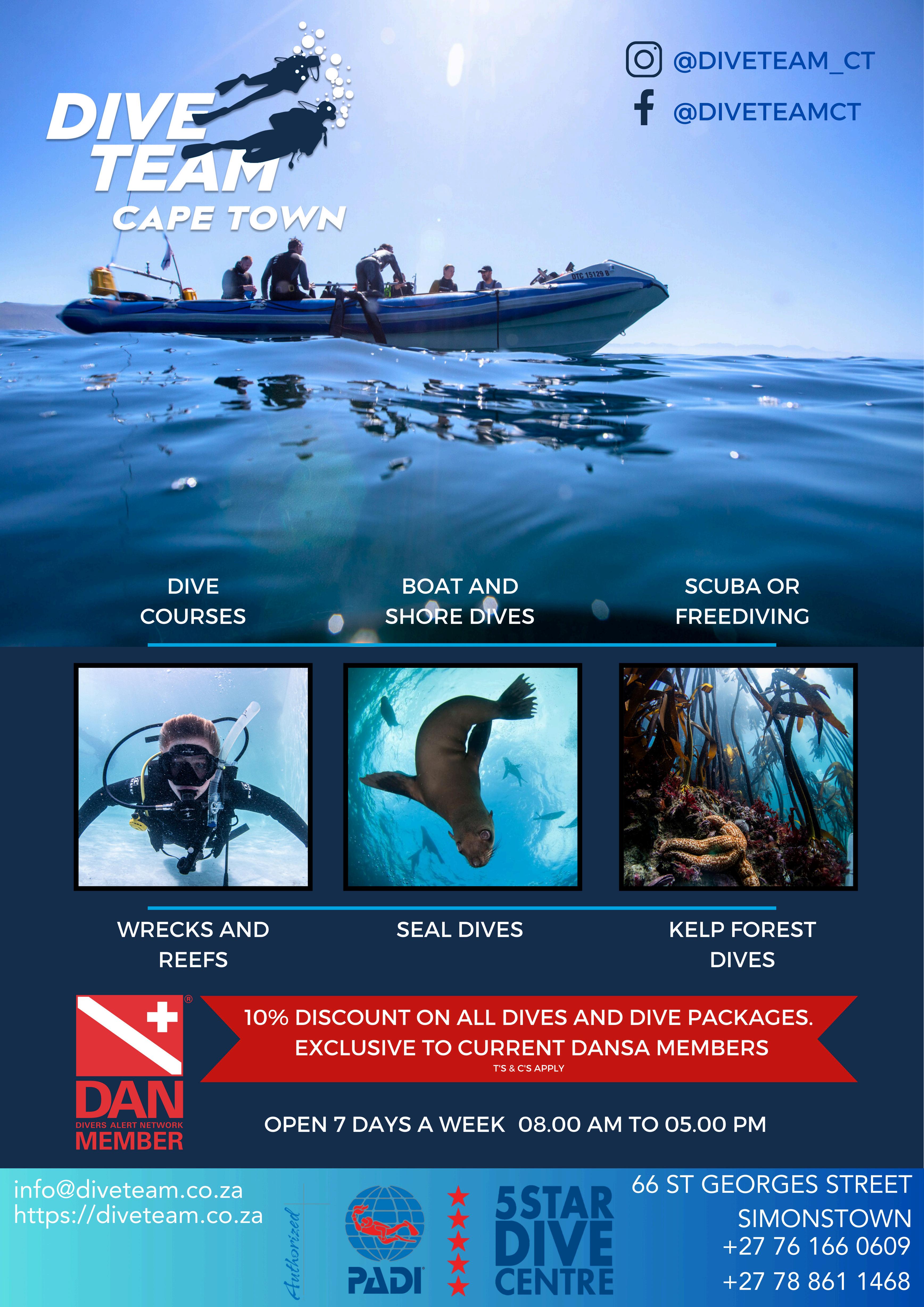

FAITH ORTINS HAS DEVELOPED A LOYAL FOLLOWING BY LEADING TOURS TO REMOTE AREAS OF THE GLOBE.
FAITH ORTINS HAS DEVELOPED A LOYAL FOLLOWING BY LEADING TOURS TO REMOTE AREAS OF THE GLOBE. SHE IS A SKILLED COLDWATER DIVER, SO ANTARCTICA IS A VIABLE DESTINATION. | SHE IS A SKILLED COLDWATER DIVER, SO ANTARCTICA IS A VIABLE DESTINATION. | ©
FAITH ORTINS IS A LIFELONG DIVER, and her love for the ocean and devotion to educating people about safe diving practices drive her dive career
From being a high school science teacher and dive shop owner to playing a vital role in developing the first women’s drysuits in the 1990s, Ortins is considered a subject matter expert on coldwater diving and the complexities of thermal protection.
Inducted into the Women Divers Hall of Fame in 2010, she now runs dive expeditions to the most remote locations on Earth, and it is not uncommon for her to visit all seven continents within a year.
FAITH ORTINS
DIVE EDUCATOR & DRYSUIT INNOVATOR
TEXT BY KYLE KRAY
Hometown: Beverly, Massachusetts
Age: 60 Years Diving: 45
Why I’m a DAN Member: DAN is the only option for dive insurance that uses the funds raised from insurance and membership to benefit the dive community Why would I work with anyone else?
DIVE SLATE
BECKY KAGAN SCHOTT © BECKY KAGAN SCHOTT
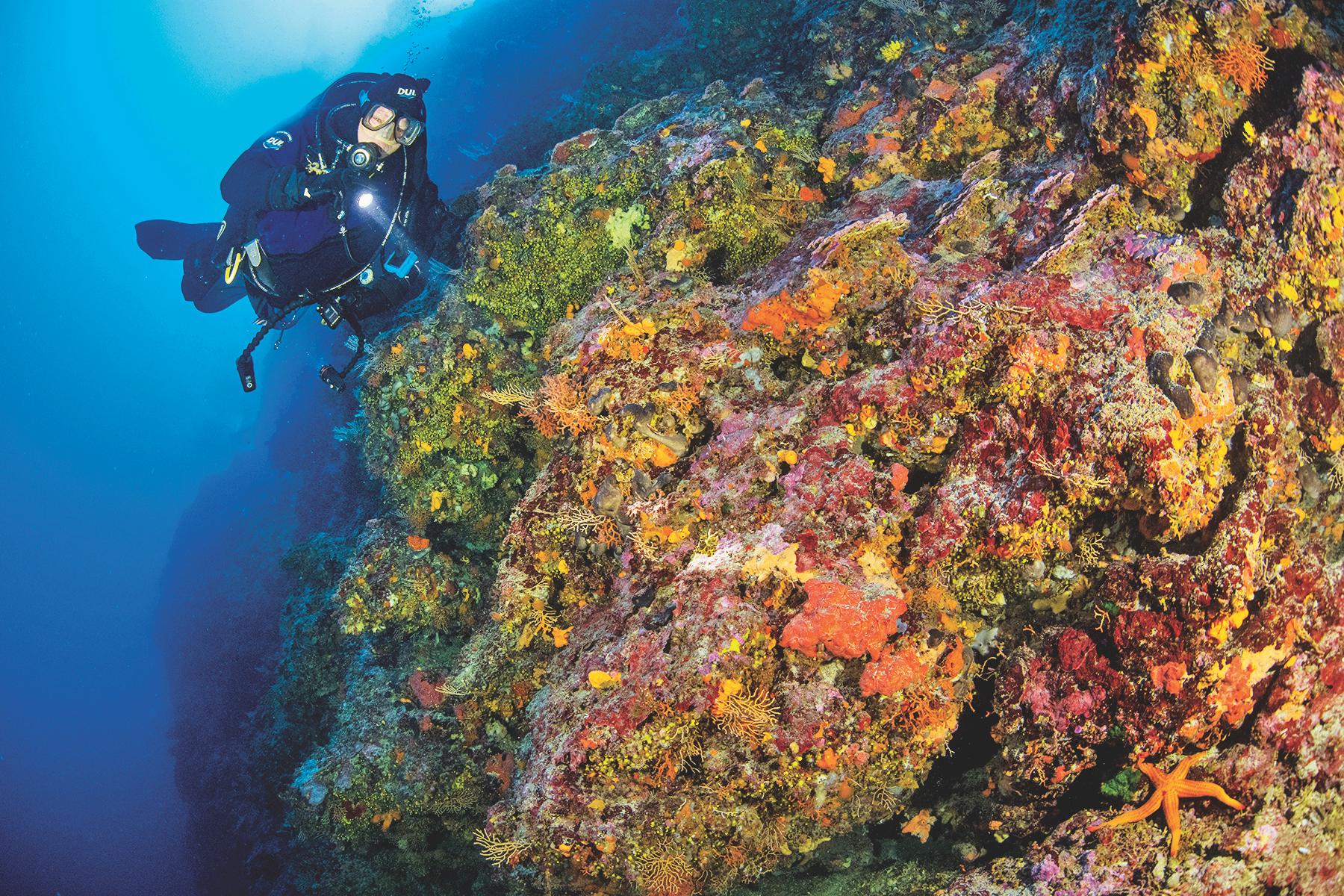
 ORTINS’ LIGHT POINTS TO THE 76 MM CALIBRE BOW GUN OF THE TUGBOAT URSUS, A HIGHLIGHT OF THE
ORTINS’ LIGHT POINTS TO THE 76 MM CALIBRE BOW GUN OF THE TUGBOAT URSUS, A HIGHLIGHT OF THE WRECK OFF VIS, CROATIA | WRECK OFF VIS, CROATIA. | © BECKY KAGAN SCHOTT © BECKY KAGAN SCHOTT
ORTINS DIVES A STEEPLY SLOPING WALL IN CROATIA.
ORTINS DIVES A STEEPLY SLOPING WALL IN CROATIA. || © BECKY KAGAN SCHOTT © BECKY KAGAN SCHOTT
ORTINS’ LIGHT POINTS TO THE 76 MM CALIBRE BOW GUN OF THE TUGBOAT URSUS, A HIGHLIGHT OF THE
ORTINS’ LIGHT POINTS TO THE 76 MM CALIBRE BOW GUN OF THE TUGBOAT URSUS, A HIGHLIGHT OF THE WRECK OFF VIS, CROATIA | WRECK OFF VIS, CROATIA. | © BECKY KAGAN SCHOTT © BECKY KAGAN SCHOTT
ORTINS DIVES A STEEPLY SLOPING WALL IN CROATIA.
ORTINS DIVES A STEEPLY SLOPING WALL IN CROATIA. || © BECKY KAGAN SCHOTT © BECKY KAGAN SCHOTT
DETERMINED TO DIVE
Ortins’ resolve to become a diver started at a young age, despite her parents’ concerns hardly anyone in her family swam After getting certified at a dive centre in northern Massachusetts in 1979 at age 15, she would use the ruse of “just practising at the pool” to quell her parents’ fears but instead would ride her bicycle 4 miles to the dive centre and sit by the air-fill station with her gear, asking anyone who showed up to take her diving
Her persistence paid off, and she earned the respect of experienced dive mentors who kept her diving throughout high school and college, taking her out on shipwrecks and encouraging her to volunteer as a public safety diver
When she became a high school science teacher in Salem, Massachusetts, she paid forward the benevolence of mentorship, leading dive programs in her local community that taught hundreds of students and underprivileged kids how to dive. The impact of these programs marked a pivotal point in her life when she decided not to teach high school anymore but instead to devote herself to becoming a fulltime dive and ocean educator. She started working at a dive shop and then purchased the store with her partner, David Caldwell, committing herself to fulfilling that goal
“Don’t be afraid of turning your passions into a career or your life’s work,” Ortins said “I discovered my passions were getting people into diving and educating people about the ocean People protect what they love, and through diving, I felt I could bring people closer to the ocean with the hope that they would love it like I do”
DRYSUIT DEVELOPMENT
As a dive store owner in the Northeast in the 1990s, Ortins was privy to perspectives and
practical applications of gear for women divers that didn’t quite register on the radars of dive equipment manufacturers located in warmer climates
“When it came to women’s dive gear at the time, the dive industry would take a product, make it smaller, make it pink, and declare it to be for women, never mind the fit or functionality,” Ortins explained “We were selling a large quantity of Diving Unlimited International (DUI) drysuits due to our location, but I couldn’t get women into them, and I couldn’t keep them warm enough to be diving locally So, I would call DUI often, asking them to consider certain fitment concepts I would also send drysuits back to them with custom fitting requests for the motivated women divers who pursued the issue, as they wanted to keep diving but wanted the drysuits to fit correctly and be comfortable as well”
Ortins was determined to make it possible for women to dive safely and comfortably. The available technology limited women’s abilities to explore, but her persistence once again yielded results. A DUI production manager brought her relentless pursuit to the attention of founder Dick Long, who flew to Massachusetts to meet with Ortins and a panel of women divers at her shop. The group told Long what they were looking for, and he left the meeting with plans to create a new line of drysuits designed for women as well as overhaul and revamp the existing line of male drysuits by incorporating new ideas from the details the women had provided him DUI released the redesigned drysuits for sale to the public 18 months later
Two years after their collaboration, Ortins began a 21-year career with DUI, moving from sales representative to sales manager to vice president of sales She continued expanding divers’ abilities and safety by
creating the DUI DemoTour More than 150,000 divers tried drysuits with professional guides in real dive situations Her work also involved educational programs that provided free training to more than 1,800 public safety divers about awareness of the risks of diving in contaminated water
BLUE GREEN EXPEDITIONS
After leaving DUI, Ortins and Paul Holbrook cofounded Blue Green Expeditions, whose mission is to foster an appreciation for the natural wonders of the planet She leads expeditions year-round, taking divers on expeditionary trips to unique destinations worldwide, where they dive at new sites and become fully immersed in the environment Blue Green Expeditions returned to Antarctica in early 2024 to continue providing life-changing and perspective-
altering explorations of Antarctic wrecks and marine life engagements for their clients
“Ice is never boring,” Ortins said “No matter how much I’ve been diving, there’s always something new to see or discover Every dive has something special Even if I’ve already been there, it is always different “The polar lands are hard to explain until someone has gone there, but once you have, you get it It’s one of those places that defies description In Antarctica, you’re not just a diver; you’re truly a polar explorer, and you will be obligated to share your experience with others when you return home You realise how small we really are, how incredible this environment is, and how important it is for us to become advocates for this part of the world”

THE LOGISTICS OF LEADING A LARGE GROUP OF DIVERS TO ANTARCTICA ARE DAUNTING, BUT THE LOGISTICS OF LEADING A LARGE GROUP OF DIVERS TO ANTARCTICA ARE DAUNTING, BUT ORTINS IS A VETERAN OF LEADING SUCH EXPEDITIONS | © STEPHEN FRINK ORTINS IS A VETERAN OF LEADING SUCH EXPEDITIONS. | © STEPHEN FRINK

DIVE SLATE
Text By Dennis Guichard | DAN Master Dive Pro
When I first learnt to scuba dive, we were always taught about depth limits in recreational diving
We were taught those were because of the risks of nitrogen narcosis and also because of the risk of CNS Oxygen Toxicity And whilst those are partly indeed true, they’re not at all the full picture of why we should respect the deep
CNS Oxygen toxicity only becomes a concern once we get to around 66m depth on air (assuming you might be so daft to even be at that depth on air anyway) Nitrogen narcosis hits a lot shallower of course and would have you high as a kite by that depth too
But most sinister of all, an insidious risk of the deep is actually carbon dioxide (CO2) retention, which introduces a whole host of dangers to diving And what drives that is quite simple: the density of our breathing gas and the efficiency of breathing at depth
Boyle’s Law explains that the deeper we dive, the denser our gas becomes in direct proportion to absolute pressure. So, at 30m depth (4 ATA), our breathing gas is four times as dense as at the surface. And the density of this gas restricts the efficient elimination of CO2 from our lungs. Our exhaled gas flow and ventilation rate at 30m is nearly half what it is at the surface.
This high-density gas also causes added turbulence, which further increases resistance in our airways. Breathing becomes less efficient and CO2 accumulates. As CO2 builds, our blood becomes more acidic, driving a circular process of ever-increasing breathing rate.
A (poor but useful) ‘rule of thumb’ for permissible gas density is to not exceed 52 g/L (30m on air), with an absolute maximum of 62 g/L (38m on air)
An excess of CO2 build-up can exasperate nitrogen narcosis and risk of oxygen toxicity It can also rapidly lead to breathlessness, anxiety, unconsciousness, and ultimately what is known as ‘Deep Water Blackout’
The approach below doesn’t consider gas temperature change when inhaled, exercise intensity, or lung humidity, but it will get you started Calculate each of your gas mixture's constituent partial pressure densities and add them together
Respect the deep water !

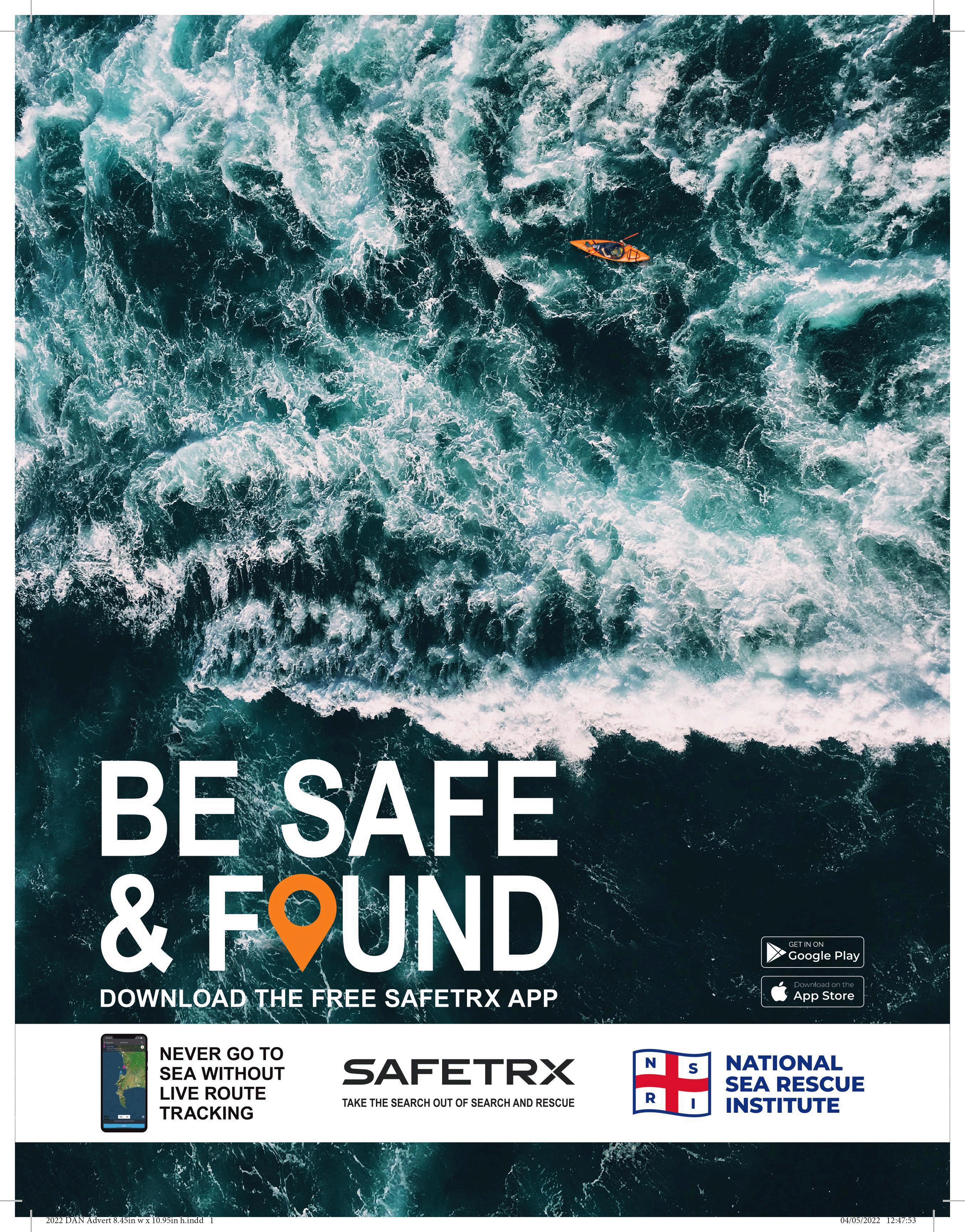
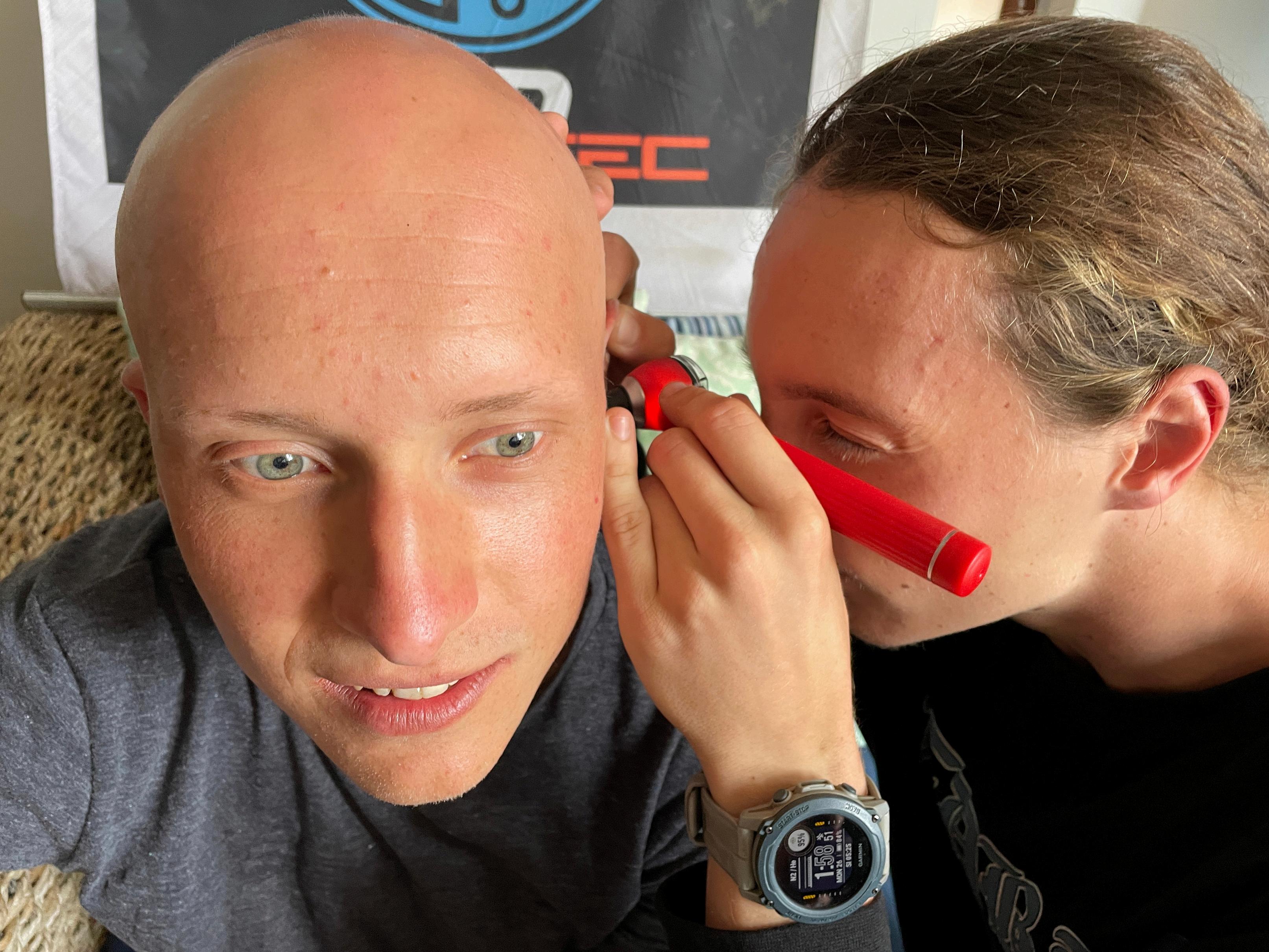
MANY SCUBA DIVER WILL HAVE AN EAR OR EQUALISING STORY TO TELL Many would provide free advice on how to get equalising problems resolved Middle ear Barotrauma is by far the most common diving injury reported
Pressure equalisation in the middle ear is the most critical skill for divers If not appropriately mastered, divers can get injured and sometimes permanently disabled. Ear barotrauma is preventable in divers with healthy ears. Divers should invest time and effort in mastering equalisation techniques.
OTOSCOPE
WORKSHOPS FOR DIVE PROS
DIVE SLATE | SPOTLIGHT
PHOTOS BY NICOLENE OLCKERS
PHOTO BY NICOLENE OLCKERS PHOTO BY NICOLENE OLCKERS


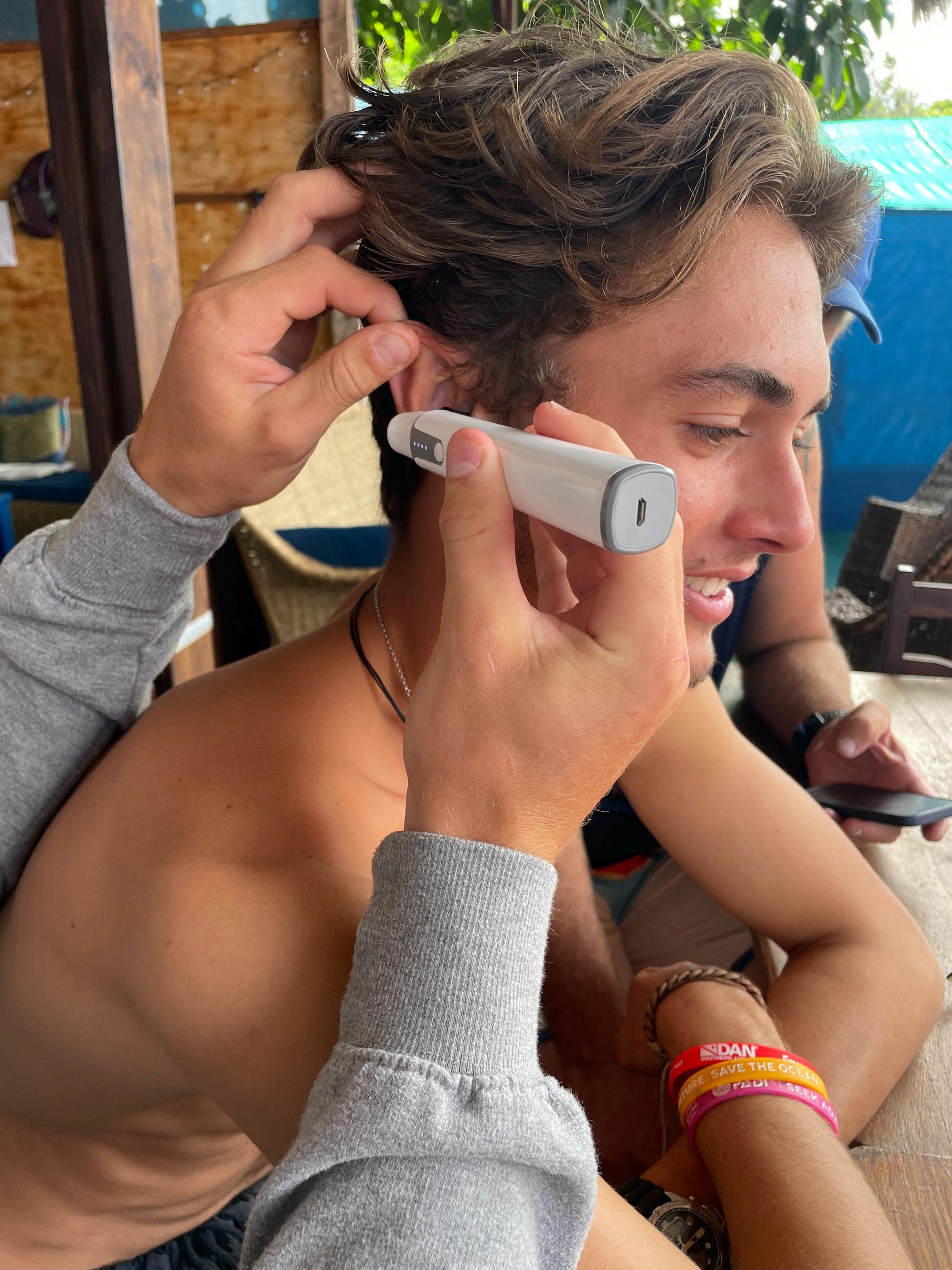
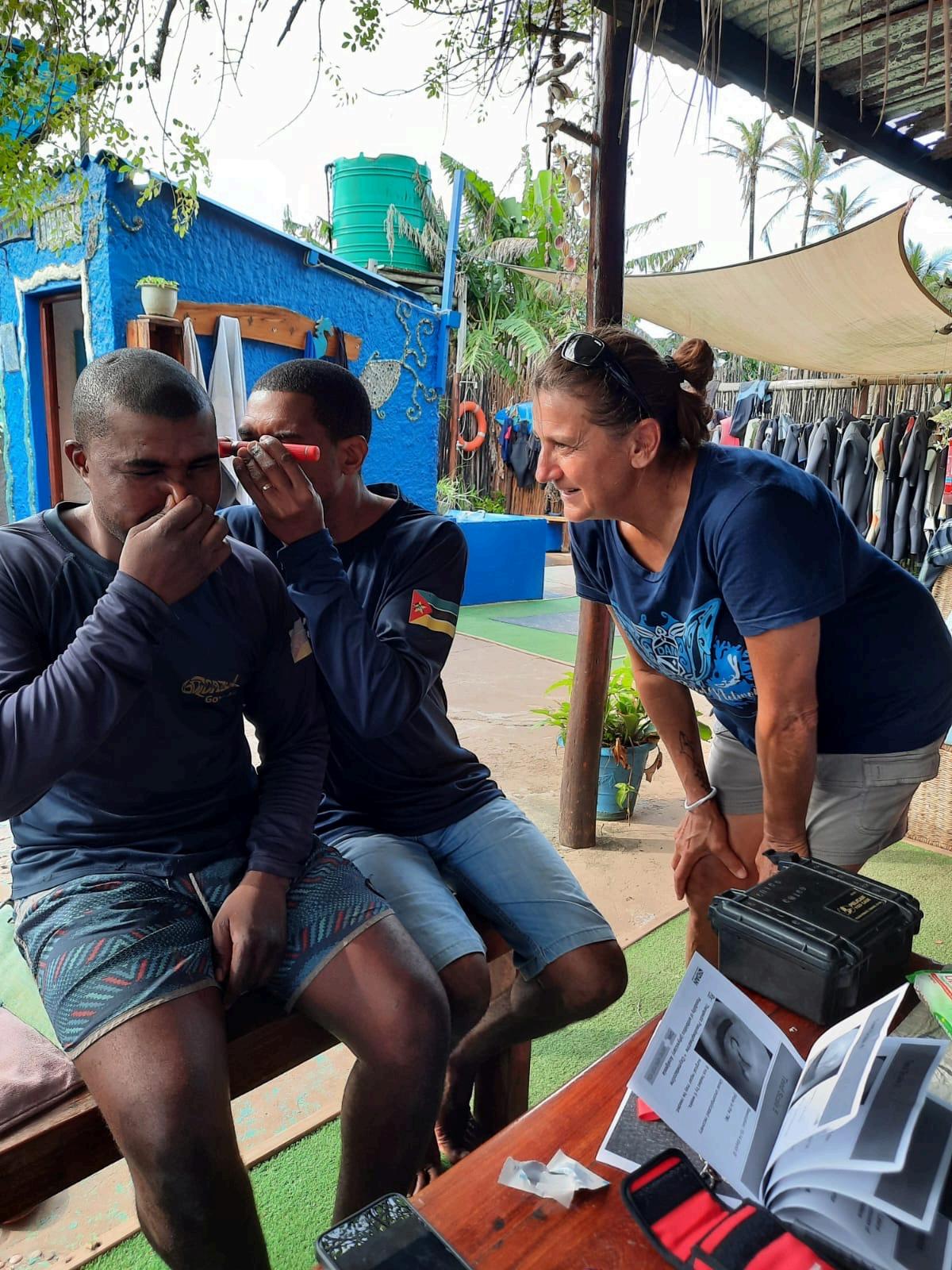

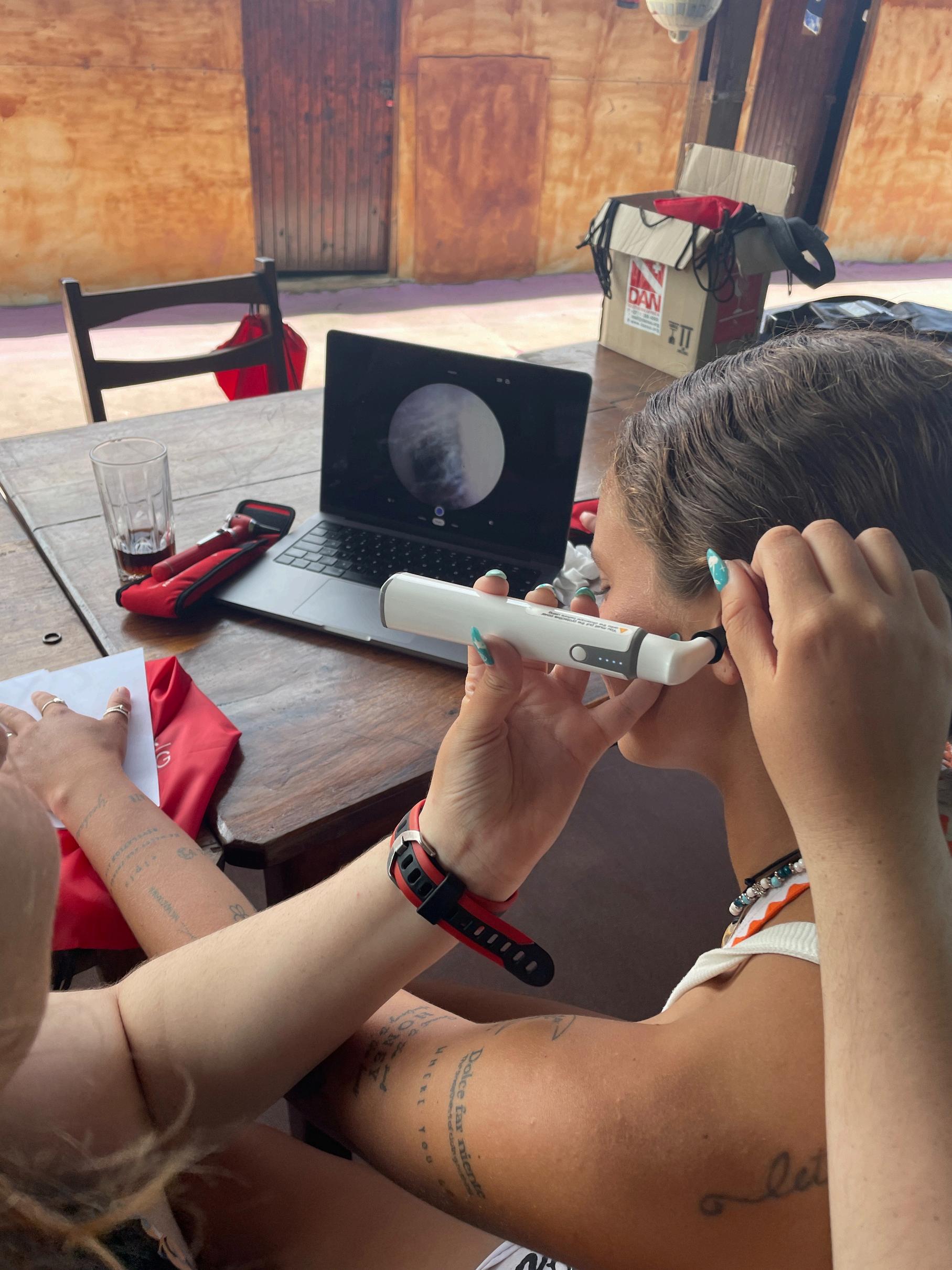
On a recent promotional excursion around the coast of South Africa, DAN instructor and marketing manager Nicolene Olckers presented several workshops to dive professionals and fellow divers The Otoscope Use workshop is based on the section in the Dive Medicine for Divers course
The main purpose of the workshop is to teach divers the basics of using an otoscope to evaluate the ear canal and the tympanic membrane or eardrum directly Knowing how to use the otoscope also enables the diver to indirectly evaluate middle ear pressure and determine whether fluids or injury are present
After working through the introductory presentation informing the divers of different ear ailments and injuries and explaining how to use the otoscope, we presented the attendees with practical experience and the proper use of the otoscope. The presentation also guided them in using the TEED scale to evaluate the severity of the injury. "I was pleasantly surprised at this workshop's enthusiasm and keen interest. Not only from the staff but also their clients at many of the dive operations I visited. I look forward to furthering the dive pros and future dive leaders' knowledge of dive safety and skills"
The groups of divers and career development candidates quickly grasped the skills needed to use the otoscope, and there were many questions related to ear hygiene and care after injuries It is important to stress the safety and responsibility of using this tool
PRECAUTION FOR OTOSCOPE USE
Use new specula for each ear & each person
Guide the speculum into the ear under vision
The skin in the ear canal is sensitive – use care
Coughing & fainting may follow irritation of the ear canal
Both you and the person examined should be seated
I look forward to doing more of these workshops in the future
GET IN TOUCH
DAN education: https://www.dansa.org/education
Sign up for various courses or diver programs.
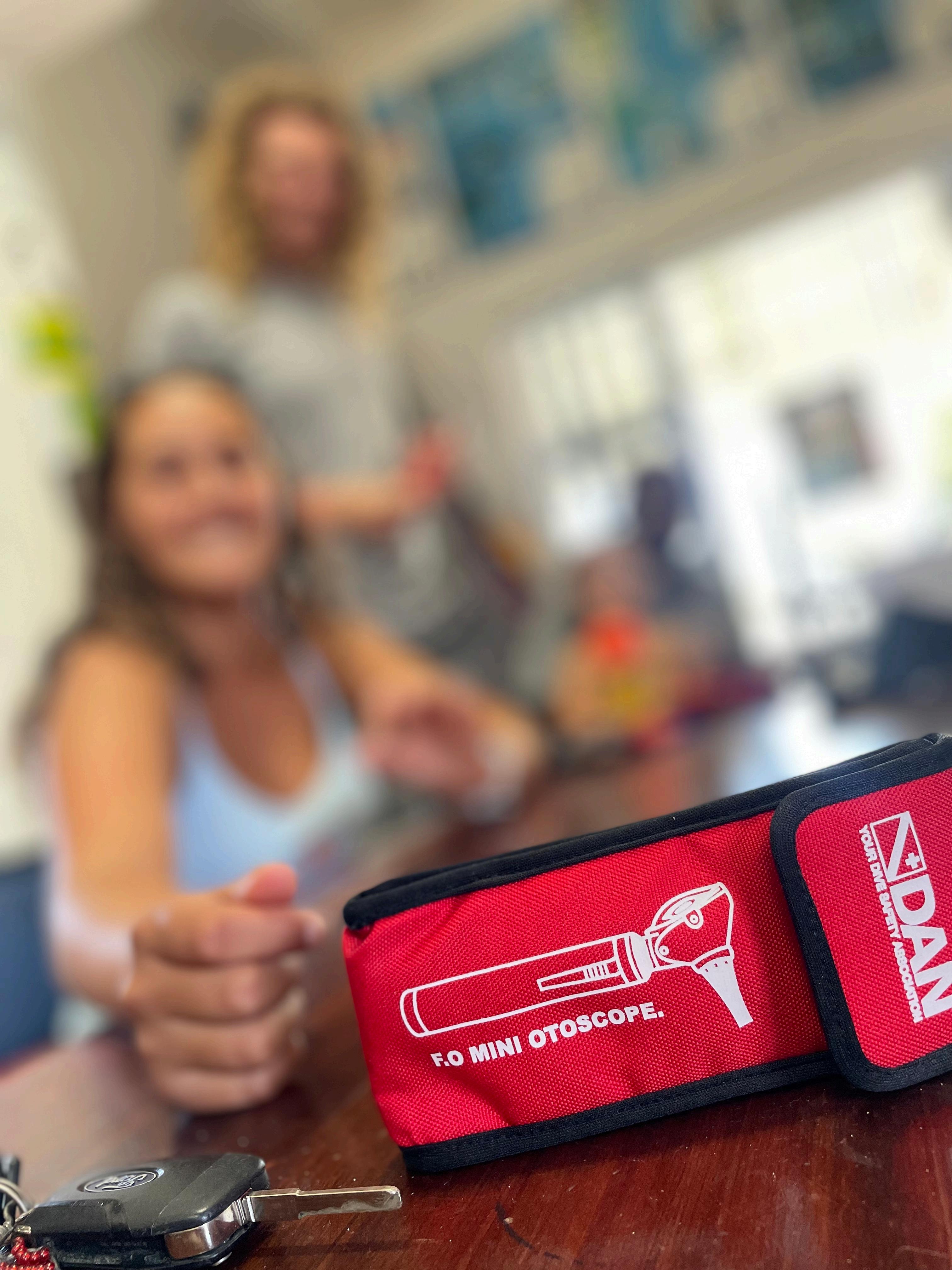

ULTIMATEFISHIDENTIFICATIONGUIDEAPP
DIVE SLATE
Text By DAN Team
Have you ever been captivated by the vibrant array of marine life beneath the waves along the East and South Coast of Southern Africa? Now, thanks to the ingenuity of Dennis King and Pamela Le Noury, exploring the fascinating diversity of reef and shore fish in this region is a breeze Their latest innovation, a user-friendly fish identification app, is set to revolutionize the way divers, snorkelers, fish enthusiasts, scientists, and students engage with the underwater world
This intuitive app is a treasure trove of features designed to enhance the underwater experience and deepen our understanding of marine fish With clear underwater photographs showcasing 756 fish species, users can witness the fascinating life cycles from juvenile to adult stages Each species is accompanied by its latest scientific name and a brief profile, ensuring accurate identification and enriching the educational value of the app
In addition to photographs, the app offers line drawings of typical family groups, facilitating a deeper understanding of the intricate relationships between species The compare feature enables users to compare similar species side by side, aiding in differentiation and identification The "My List" feature allows users to personalize their experience by recording personal fish observations
The journey to create this exceptional app has been a labour of love, driven by the unwavering passion and expertise of Dennis King and Pamela Le Noury, with the support of various contributors Dennis, a seasoned author of marine fish identification books, including the renowned "The Reef Guide," (co-authored with Valda Fraser) brings 68 years of underwater experience and a wealth of knowledge to the project His extensive collection of fish photographs taken over 40 years forms the foundation of the app, a testament to his lifelong commitment to marine exploration
Meanwhile, Pamela's background in app development, coupled with her involvement in projects like the "Antarctica Wildlife Guide" and "Dolphins and Whales World Guide," ensures a seamless user experience and a commitment to excellence in digital education Together, Dennis and Pamela have crafted a masterpiece that reflects their shared passion for marine conservation and education.
GuideToTheCoastalFishesOfTheWesternIndianOcean
Despite Dennis's recent retirement from scuba diving, his commitment to the underwater world remains unwavering. With snorkel and underwater camera gear in hand, he continues to explore and document the beauty of Southern Africa's marine ecosystems, inspiring others to join him in the quest for knowledge and conservation.
The launch of this fish identification app marks a significant milestone in the exploration and appreciation of Southern Africa's marine biodiversity. Whether you're a curious novice or a seasoned expert, dive into discovery with this invaluable tool and unlock the secrets of the sea like never before
QUOTE
Dr Judy Mann-Lang, who has worked in marine education and conservation in South Africa for over 30 years, said, " We have been waiting for an app like this for many, many years It will help divers, fish enthusiasts, educators and scientists not only identify the fish they see but it will help them to understand a little more about the secret lives of these fascinating animals Hopefully, the app will inspire more people to care for fish and their ocean homes I can only admire Dennis and Pam for their perseverance in creating the content for this app I worked with my husband, Dr Bruce Mann, on the Marine Fish Guide for Southern Africa app - so I know just how much work was involved Well done, Dennis and Pam, and thank you for this wonderful tool for marine education"
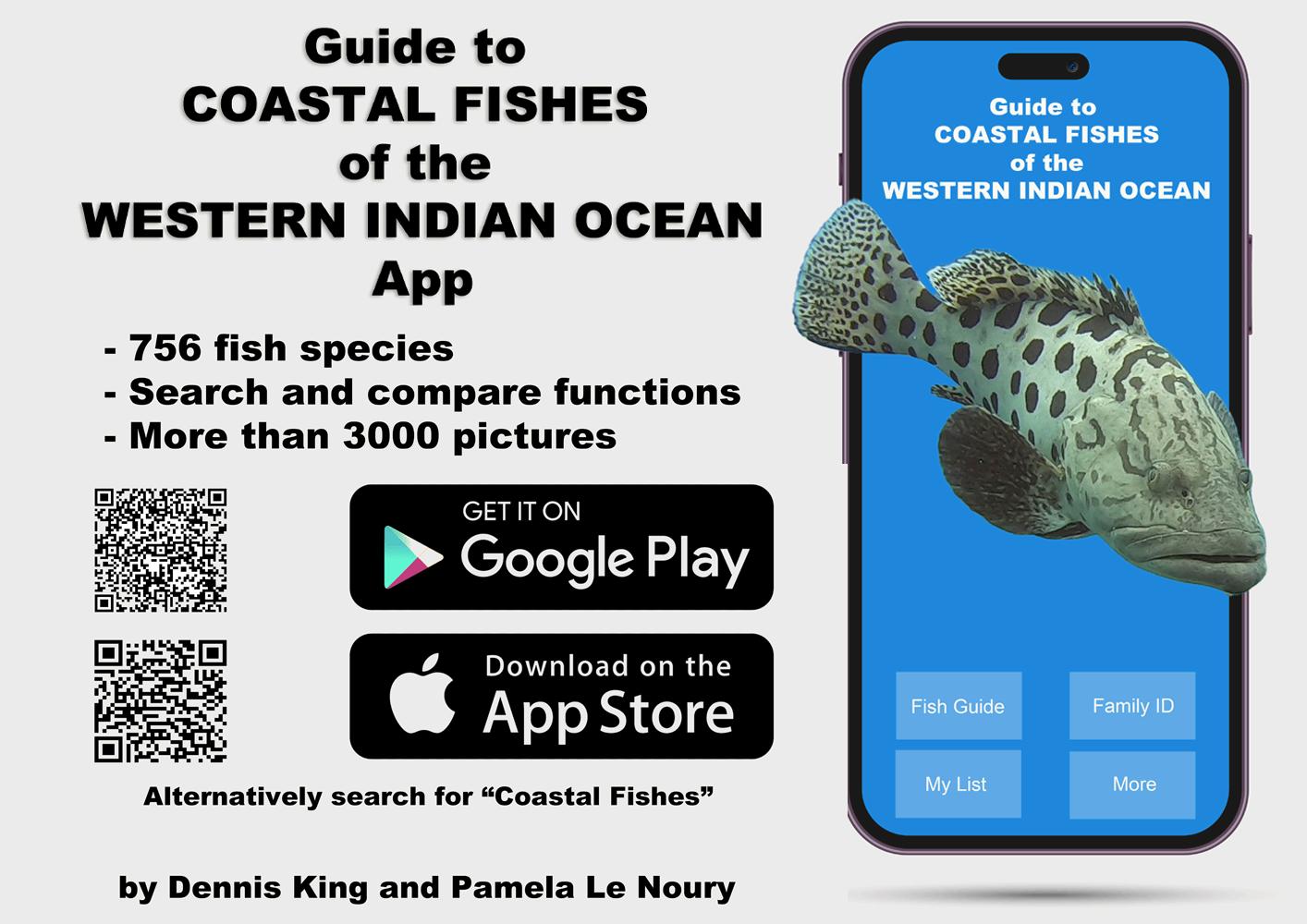
ProsChooseDAN TrustedWhenItMattersMost

Windell John Regional Watersports Manager Eastern & Southern Caribbean Region, Sandals and Beaches Resorts, PADI® IDC Staff Instructor, explains why he chooses DAN.
Dive Safety Alert Diver
ALERT NETWORK
DIVERS
W A T C H V I D E O
DIVE SLATE SATURATIONEMERGENCY DECOMPRESSION
Text By Dennis Guichard | DAN Master Dive Pro
Saturation diving is a safe but complex activity employing many specialist personnel worldwide. DCS and dive accidents are unheard of Dive teams are highly experienced and versed in deep-water diving activities Every work event includes highly qualified Saturation Supervisors, Life Support Technicians, and commercial Diver Medics ensuring safety But every once in a while, events might occur that require emergency decompression from habitat depth
Saturation decompression is an extortionately slow process occurring over many days at a rate typically as slow as just 1m per hour The diver’s tissues are all at 100% saturation, so decompressing slowly is critical to avoid the risk of severe DCS So, what should we do in an emergency where it becomes critical to surface a diver as quickly as possible?
In many locations around the world, like the British or Norwegian North Sea, it is sometimes possible to transfer divers to land-based specialist medical facilities via transfer-under-pressure chambers Divers can be transferred into these small chambers, taken ashore via helicopter or a hyperbaric rescue vessel, and connected to land-based hyperbaric medical facilities There, they can receive specialist care as required but still under pressure But these are not always available or practical to use
We can speed up decompression in various manners We can increase the rate of decompression, a dangerous dance balanced against the risk of severe DCS Or we can increase the oxygen partial pressure of the breathing mixture, a dangerous dance against the risk of Oxygen Toxicity How far you push that envelope of risk depends on the critical nature of the incident
In a recent offshore incident, a diver suffered a myocardial infarction (heart attack) whilst in saturation and needed to be evacuated as quickly as possible Increasing oxygen concentration in a heart attack patient can be hazardous as that can cause further vasoconstriction of blood vessels to exasperate the problem
Bespoke emergency decompression procedures were developed as the problem unfolded, using a modern DCS risk probability decompression algorithm with tight control of oxygen exposure limits. They are managed by specialist on-call diving doctors who are working at their best to look after the diver's well-being during very trying times with very complex medical matters.
We can be grateful they’re out there.

BE PREPARED WITH A GO BAG
DIVE SLATE | TRAVEL SMARTER
THERE HAS BEEN MUCH DISCUSSION in the dive industry about incidents and accidents that require emergency exits from liveaboards. While we understand emergencies are possible, we will continue to travel on liveaboards, so we should be prepared for the unexpected
If an alarm sounds in the middle of the night, the traveller should exit as quickly as possible Doing so requires knowing your exit path, even if there are no lights, and not slowing down for anything
During the boat briefing, the dive operator should discuss the various exits, especially those in the sleeping spaces It isn’t enough to listen to the briefing you should find the exits They are often hidden in a closet or bathroom, so you need to know what they look like and how to operate the latches or knobs
If an alarm is going off, but you don’t see or smell smoke, you may be tempted to grab your daily medicine, glasses, or passport instead of exiting immediately But in a liveaboard fire or other incident, every second matters Even if you don’t smell smoke, something may be happening that will block your exit.
It’s a good idea to keep a small go bag by your bed so you waste no time looking for essential items. You can keep your necessary medications, glasses, contacts, passport and travel documents, credit cards, and phone in it, along with a waterproof flashlight and a whistle
A few specific features will make your go bag the most effective It must be small (no larger than 2 litres) so it doesn’t impede your exit A solid clip lets you attach it to your belt loop or lifejacket, so your hands remain free
A drybag will float and keep medications and documents dry A brightly coloured bag will be easier to find if you lose it
Every night at bedtime, put any items you have used back in the bag and keep it closed and sealed If there is an emergency, you quickly grab the bag and go, thus saving time by avoiding the temptation to stay and look for critical items
An emergency evacuation is never expected but is always a possibility Knowing the exits and having a go bag with important necessities are crucial to being prepared to exit a liveaboard
PHOTO BY KYLE HABECKER PHOTO BY KYLE HABECKER

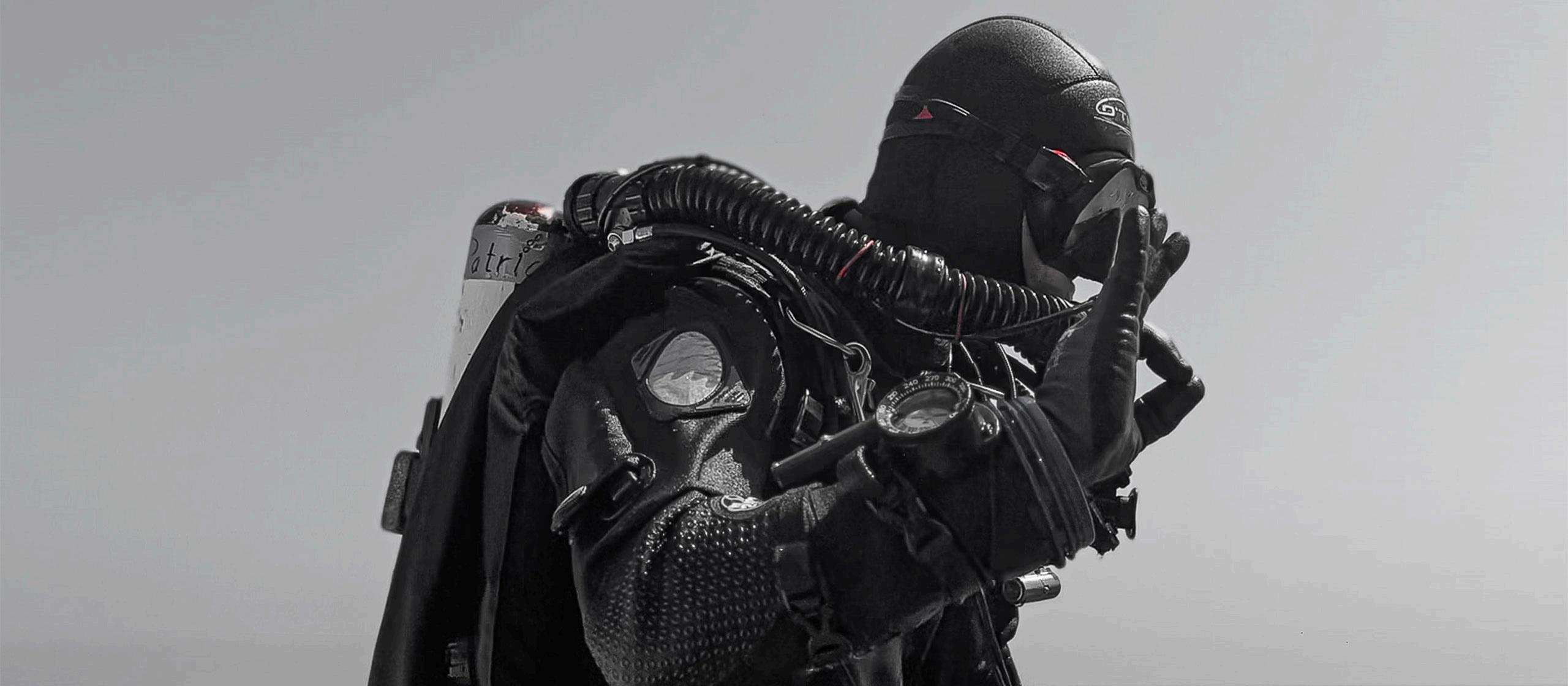
In part one of this story, we reviewed the advantages of rebreathers for technical divers. In this second part, we examine the efficacy of rebreather technology for recreational divers.
The first advantage we looked at for the technical diver is gas duration. This is also a benefit for recreational divers. They may not be doing such long dives, but for many divers, their air consumption and the fact that they are using a single cylinder means that the limiting factor for most dives is gas duration A rebreather can significantly increase the amount of time they can spend underwater
While gas duration is still a benefit for the recreational rebreather diver, gas costs are not an advantage and are a disadvantage On an open circuit, you may only need to pay for an airfill in a single cylinder However,
REBREATHERS PART 2 GEAR
TEXT BY MARK POWELL
BY OLGA MARTINELLI
Are rebreathers suitable for recreational divers?
PHOTO
on even the shallowest rebreather dive, you will still need to use pure oxygen in one of the cylinders and carbon dioxide absorbent in the rebreather The annual replacement of the three oxygen sensors and handset batteries must also be considered
This means the gas cost for a shallow recreational dive may only cost €5 for an open circuit diver but €10-€15 for a rebreather diver Unless you do significant deep trimix dives a year with little or no recreational diving, the gas savings from using a rebreather will not outweigh the initial start-up costs However, several other reasons remain why a rebreather is an attractive option
LOGISTICS AND DECOMPRESSION BENEFITS?
Gas logistics is another area where recreational divers do not have as much of an advantage when switching to a rebreather. Getting air fills in a single cylinder is a relatively straightforward process, and just about every dive centre in the world can provide this service. Nitrox is not as common but is still widely available. However, high-pressure oxygen may not be as readily available and may mean that a recreational dive centre cannot support recreational rebreather diving
On the other hand, a reduced decompression obligation is still very much an advantage for recreational divers Breathing the optimum gas mix at every point in the dive significantly reduces the amount of inert gas we take and can dramatically increase our no-stop dive Even though recreational divers are not doing mandatory decompression stops, the decompression implications are ironically one of the most significant advantages for recreational divers
While some of the advantages enjoyed by technical divers are not as relevant for recreational divers, there are some
additional advantages for the recreational diver switching to a rebreather There are no bubbles, so that we can get closer to marine life As most of the marine life lives in the shallows, this is more relevant to recreational divers It’s not until you swim along a reef on a rebreather that you realise how much the open circuit bubbles scare off marine life
ADDITIONAL COSTS, RISKS AND COMPLICATIONS
However, a rebreather introduces significant costs, risks and complications to any dive It should not be seen as a magic wand to solve all of the potential problems of deep technical diving and introduces significant additional considerations to recreational diving
In the first place, buying a rebreather is an expensive proposition Prices vary from €3500 to over €8,000 for the unit alone When combined with training and the inevitable extra bits of kit, it is a false economy to buy a rebreather to save money on gas fills for technical divers, let alone recreational divers. There have been several attempts to introduce a “cost-effective” recreational rebreather, but these have only been partially successful.
In addition to the cost, a number of risks are introduced by using a rebreather
AVOIDING PROBLEMS WITH CARBON DIOXIDE
The body adds carbon dioxide if our breath is recycled without removing the carbon dioxide In this case, levels will build up, and eventually, the diver will succumb to carbon dioxide poisoning, one of the most significant risks of rebreather diving To avoid this, a chemical process must remove the carbon dioxide
This occurs when the exhaled gas passes through a scrubber packed with a suitable

chemical designed to remove the carbon dioxide Correctly packing the scrubber is one of the most critical steps in preparing a rebreather, as incorrect packing can allow carbon dioxide to be ‘channelled’ through the scrubber, causing a build-up in the breathing loop and leading to carbon dioxide poisoning
This can cause headaches, lack of concentration, unconsciousness, and death Unfortunately, the diver suffering from this condition may be unaware of the condition or maybe so incapacitated as to be unable to respond to the problem
Overusing the scrubber material is another potential cause of carbon dioxide poisoning For this reason, it is vital to monitor the time the material has been used and to replace it at the appropriate time If there is any doubt in the diver’s mind that they may be suffering from carbon dioxide poisoning, they are taught to bail out to a known gas source.
THE IMPORTANCE OF OPEN CIRCUIT BAILOUT
For this reason, rebreather divers carry opencircuit bailout gas. In addition, many rebreathers are supplied with a Bail Out Valve (BOV), which allows the diver to switch from the rebreather loop to an open circuit regulator with the turn of a valve Of course, once the diver has bailed out to open circuit, they are limited by all the same gas consumption issues that the open circuit diver has to face
This is one of the reasons why a rebreather is not necessarily the full solution for deep technical diving The diver will need to carry enough gas to ascend safely in the case of a problem with their rebreather, and so will have to carry the same amount of decompression gas as an open circuit diver
Equally, this is also one of the disadvantages of using rebreathers in the recreational area
The diver still needs to carry some form of open circuit bailout to get them to the surface should the rebreather have a problem In some cases, the open circuit bailout is precisely the same cylinder they would use if they were diving on an open circuit So, they carry significantly more equipment to do a relatively simple dive
OXYGEN MANAGEMENT
In addition to excess carbon dioxide, the other significant danger that rebreather divers face is an incorrect partial pressure of oxygen In an eCCR, the rebreather maintains the partial pressure of oxygen within the breathing loop; in an mCCR, it is the divers' responsibility to maintain the partial pressure Either way, it is always the diver’s responsibility to know their partial pressure at all times, and this is one of the golden rules of rebreather diving
All rebreathers will have a display which shows the partial pressure of oxygen. This can be an electronic gauge, often wrist- or console-mounted, or a visual display using coloured LEDs.
These Head-Up Displays (HUDs) can immediately warn of incorrect partial pressure levels. During the dive, a diver usually aims to maintain a partial pressure between 10 and 14 bar of oxygen This is known as a ‘set point’ Allowing the partial pressure to rise too high can lead to oxygen toxicity problems, whilst allowing it to fall too low can lead to hypoxia and a blackout
IT IS MORE COMPLEX THAN OPEN-CIRCUIT SCUBA
The equipment used in a rebreather is more complicated than open circuit, and the procedures required are more detailed and intensive Preparing a rebreather to dive will inevitably take longer than preparing open circuit equipment
The added complication of the kit also
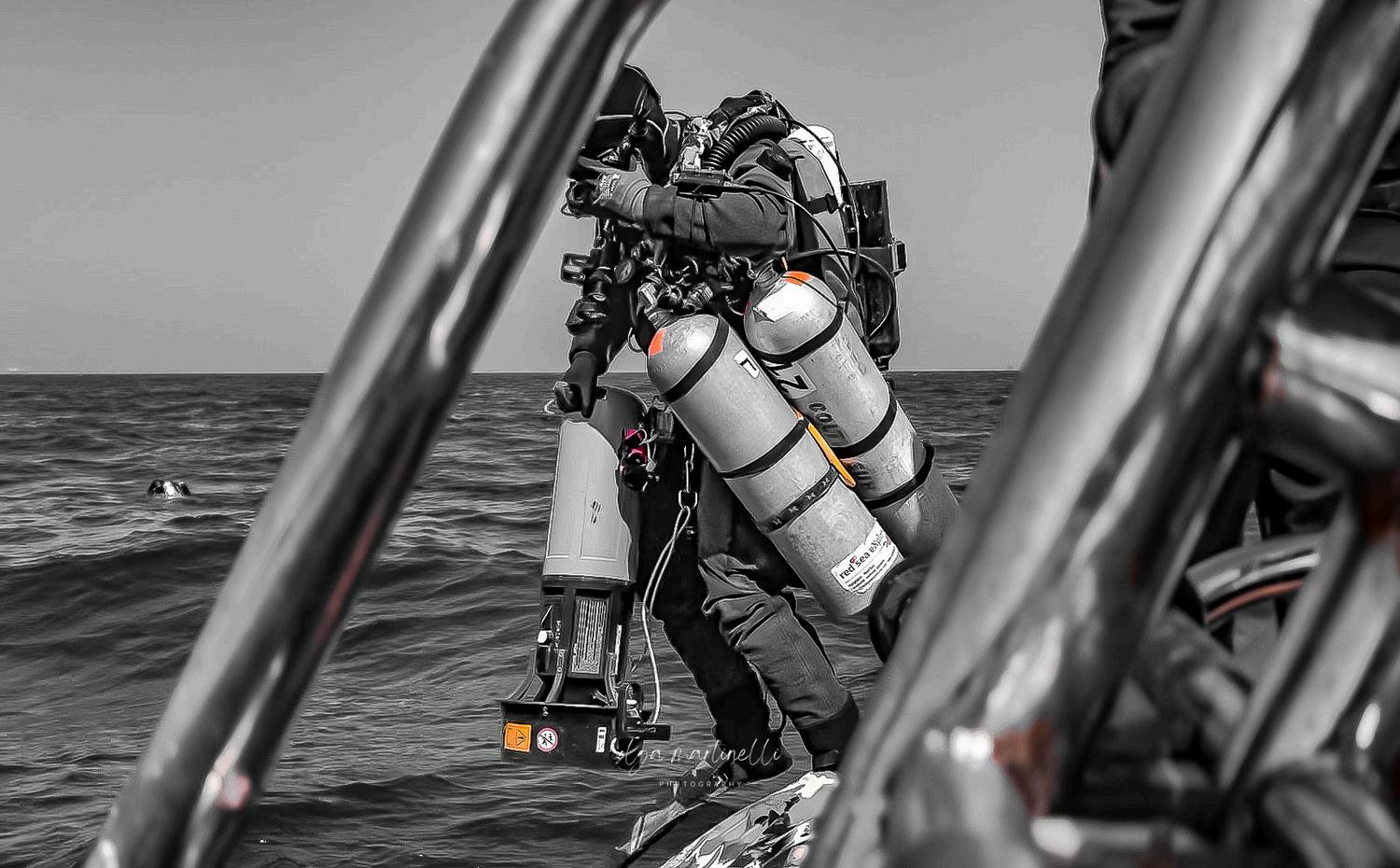
increases the chances of a problem occurring, either before the dive, causing it to be aborted, or during the dive, causing potentially more severe problems.
These considerations are covered in extensive detail during any rebreather training course, but complacency is one of the biggest dangers for rebreather divers As they build their experience, they start to take shortcuts or start to neglect basic checks Typically, divers with around 50 hours of experience tend to fall into this complacency trap
BUT I WANT ONE
Even if you won’t save money and don’t need a rebreather for logistic reasons, there are other reasons to switch Diving is a hobby, so it does not always have to be justified for cost reasons
The cheapest option is not to dive, but most do not consider this a possibility In the same way that some people spend their money on motorbikes, horses, home cinemas, model helicopters or any other hobby, there is no reason someone shouldn’t spend their money on a rebreather just because they want one Other people may switch to a rebreather to challenge themselves to learn something new
SHOULD YOU SWITCH?
As we have seen, there are several reasons why many divers want to switch to a rebreather. However, the risks of rebreather diving mean that some people are better suited to rebreather diving than others. Rebreathers are significantly more complicated equipment than an opencircuit scuba set
While rebreathers do not require tremendous effort, they need more care and maintenance than open circuits For divers who throw their kit into the back of the car or into the garage and then don’t look at it
until the next dive, this can cause a problem. This type of person is not suited to rebreather diving unless they can discipline themselves to maintain the rebreather.
On the other hand, many divers enjoy cleaning and maintaining their equipment almost as much as the dive itself. They get pleasure from adjusting the kit until it is just right and viewed as part of the hobby rather than an added chore they must do This type of person is ideally suited to rebreather diving
THE NEED FOR DIVING DISCIPLINE
In addition to cleaning and maintenance, rebreathers require discipline whilst diving them A certain mindset is necessary to ensure that the unit is assembled correctly each time and that all pre-dive checks are rigorously followed Most rebreather accidents are caused by the divers not following the correct procedure This includes not diving the unit if there is any problem with it
Many divers become complacent and will dive with known problems with their rebreather They are confident that they can overcome the problem, and in most cases, they manage to deal with the known problem However, if there is any problem during the dive, the impact of the initial problem can be significantly increased by subsequent problems.
It requires a significant level of discipline to call off a dive for what might appear to be a minor problem, but becoming complacent about these failures is one of the most common causes of rebreather accidents. The diver must constantly monitor the unit during the dive to ensure it operates correctly The golden rule of rebreather diving sums this up: “Always know your partial pressure”
It doesn’t matter if the diver is at 10m or 100m; the level of monitoring is the same, so

a 10m dive must be approached with the same mindset as a 100m dive As such, there is no such thing as a casual rebreather dive Not all divers have the mindset to adjust to rebreather diving, but without this mindset, they should not consider rebreather diving
ADDITIONAL SKILLS REQUIRED
To be a safe rebreather diver, several skills need to be mastered over and above the basic open circuit skills Some of these are related to the normal operation of the rebreather, and some are related to emergencies Like any skill, it takes practice to master these skills and practice to maintain them
Skills like buoyancy control must be relearned when moving from an open circuit to a rebreather This takes time and effort For an experienced diver, this means the frustrating process of returning to basics and building up their experience.
Unless you are prepared to put in the time to master the basic skills, you will always be diving on a base of weak rebreather skills, even if you were previously a very experienced open circuit diver. These skills also need to be practised regularly to ensure they are maintained. This means diving a rebreather regularly to carry the appropriate skill levels is essential
rebreather It is clear that for some people, a rebreather is a desirable or a personal interest and, in some cases, an essential way to progress their technical diving For others, the advantages do not necessarily outweigh the disadvantages
For this reason, it is a very personal decision that should not be taken lightly First, you must decide whether there is a good reason to dive a rebreather and whether you have the right mindset to dive it safely Like many things, the correct decision will vary from one person to another
ABOUT THE AUTHOR
Mark had his first diving experience at age 10 when he did a try-dive in a local pool He was hooked from that point onwards He learnt to dive in 1987 and has been diving ever since Mark became an instructor in 1994 and has been actively instructing since then In 2002, Mark set up Dive-Tech, a dedicated technical diving facility, with the intention of providing the highest quality technical diving training. Dive-Tech provides technical training at all levels up to and including CCR Advanced Mixed Gas Instructor Trainer. Mark is a TDI/SDI Instructor Trainer and a member of TDI/SDI’s Global Training Advisor Panel. He also represents TDI/SDI on a number of international standards groups He regularly contributes to several diving magazines, is the author of “Deco for Divers” and



EQUALEASY GEAR
NEOPRENE HOODS AND EQUALISATION
TEXT BY CLAUDIO DI MANAO | PHOTOS BY MARIONA YEPES DAVIU
WE LOSE HEAT MAINLY FROM OUR HEAD. This applies to all of us, including those who don't seem to use their heads much. Energy doesn’t dissipate due to brain activity but because of blood circulation. We often wear a hood when diving to reduce this heat loss from the head. Besides its intended purpose, however, a hood also has the unfortunate distinction of being the only piece of diving equipment that can interfere directly with equalisation
Divers do not particularly love Hoods, as evidenced by the abuse we inflict on them We perforate them with holes and ‘decorate’ them with accoutrements of questionable taste, such as ears (Mickey Mouse, cat, bunny) or horns (devil, Viking) I freely admit having taken a perverse delight in perforating the integrated hood of my semidry with a power drill We would never do this to a BCD!
Our dislike for diving hoods may be the product of strange behaviours the hoods,
not ours. All diving hoods made on earth seek to trap air and sneak underneath mask skirts. Wearing gloves (which often go together with a hood) makes it hard to prevent random migration of the mask strap over the hood’s outer surface and harder to remove that damnable little bit of neoprene that has crept under the mask skirt and is causing a leak.
While we are acutely aware of these annoyances (we don’t want to look like Marge Simpson, and we don’t want to readjust our mask strap every five minutes), divers often ignore the most worrying characteristic of hoods: their tendency to mess with our ears
KNOW YOUR "FRENEMY"
Hoods can be one of the most insidious causes of barotrauma When we dive, our ear canal is flooded by water, which exerts direct pressure on the outer ear A hood that is too tight can block off or significantly
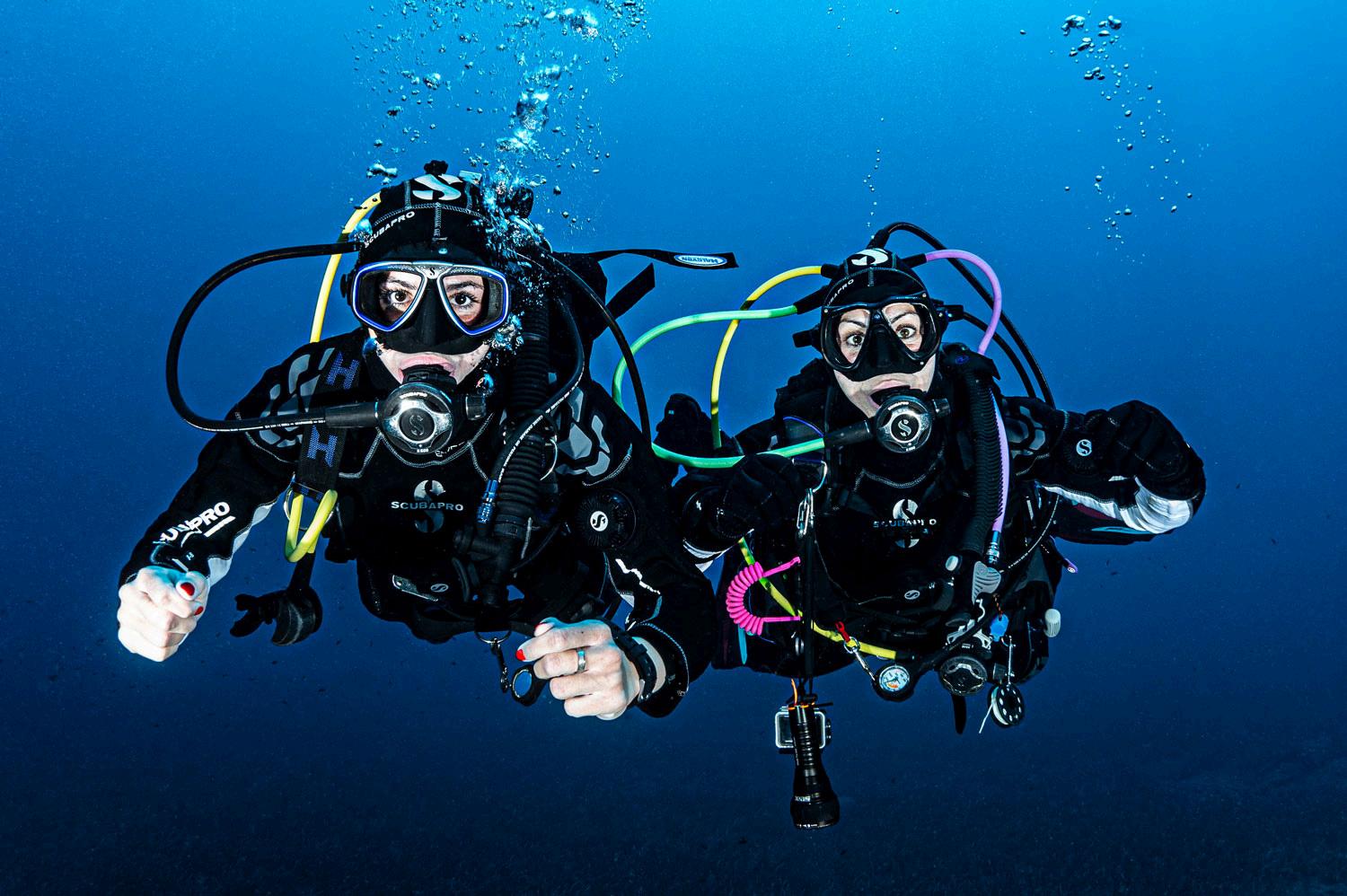

reduce water flow into the ear canal. In the worst case, the hood fits itself perfectly to the auricle and behaves like a suction cup during descent. The diver may not notice the incoming problem at the beginning of the descent. Both ears seem to equalise just fine. However, there is a vacuum forming in one ear canal, which causes the eardrum to stretch outward This event (very similar to a mask squeeze), if not promptly detected, could damage the ear canal tissues and the eardrum
COUNTERMEASURES
A diving hood must fit smoothly, like a glove Water must reach the ear canal, air must escape A tried and trusted trick is to insert a finger in the hood, pointing at the ear This will help the air to escape and allow water in Another trick: If you love to brutalise diving hoods, you can punch a few holes in the hood where it meets the ears, then cover the area with a layer of permeable fabric This will help water circulation into the ear canal while preventing it from sloshing around and making your entire head feel cold Strangely enough, most divers pierce only the top of the hood – the least strategic area Of course, there are much worse mistakes you could make On a forum, I once read a question by a diver asking if his ‘usual’ equalisation problems when diving with a hood could be prevented by using earplugs I felt shivers running up and down my spine. The replies reflected the same horror and alarm that I felt and came in all capital letters: Ear plugs, at depth, turn into bullets aimed straight at the eardrums. Yes, I know,
you know that. I’ll say it anyway, just in case. Someone else might need the reminder.
Sadly for cold-water divers, dry hoods with a valve and low-pressure inflator are unlikely ever to become a reality. Nor will full-face masks solve our problem. Let us accept that cold water will be entering our hood for the foreseeable future It has to The good news? Electrically heated hoods are already on the market
ADDITIONAL RESOURCES
Are you looking to increase your awareness and skill level in equalisation? DAN Europe has got your back Italian “No Limits” freediving champion Andrea Zuccari has teamed up with DAN Europe to create the Equaleasy-Equalisation Awareness Course designed to put you in control of your equalisation It provides three levels of certification depending on your interest and qualifications: Equaleasy student, Instructor or Instructor Trainer Learn more about the course here: Equaleasy course
ABOUT THE AUTHOR
DAN Member since 1997, Claudio Di Manao is a PADI and IANTD diving instructor He's the author of a series of books and novels about diving, including Shamandura Generation, an exhilarating portrait of Sharm el Sheikh's diving community. He collaborates with magazines, radios and newspapers, talking and writing about diving safety, marine life and travel.




COVER THROUGH DAN WWW.DANSA.ORG LIFESAVINGBENEFITS-24/7EMERGENCYHOTLINE-ACCESSTODIVE MEDICALEXPERTS-DIVINGRESOURCESTOKEEPYOUSAFE Yourgatewaytodivesafetyservices&worldwidedive coverageatlowannualrates!

GEAR
Text & Photos By Adam
Sokolski | @adam_sokolski_bluepix
Planning and executing your scheduled dive trip involves a considerable amount of equipment First is to pack all your dive gear This will include soft gear and hard gear. Being a keen underwater photographer will add extensively to your packing list Ensuring you have all the right gear to capture the underwater world and critters to perfection can be daunting. Here are some essential tips from Adam Sokolski, an underwater photographer based in Zanzibar, Tanzania.
These tips are based on his personal experience. Although they may sound quite simple, even very experienced photographers make some mistakes.
Adam’s tips, born from his personal experience, are invaluable. They cover everything from preparing your underwater photography equipment to how to behave underwater and what to do after the dives. These insights, while seemingly simple, can be the difference between a successful dive and a disappointing one. They are designed to help you avoid common mistakes and enhance your underwater photography experience

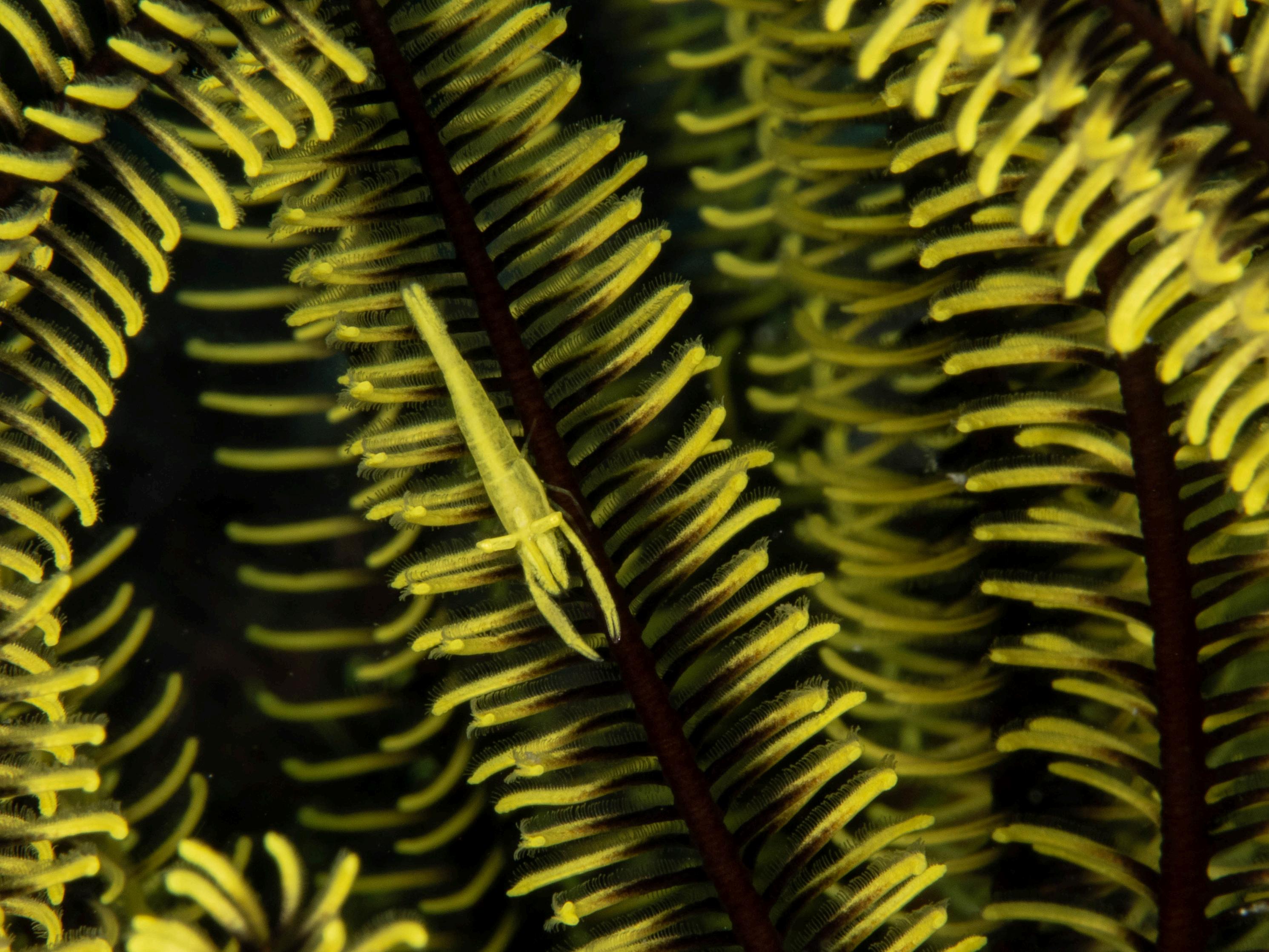

Do Not Forget Anything
Pack for the dive trip very carefully, and make sure you pack everything you need. Compile a packing list, and be sure to check the packed items on the list. Apart from the camera, lenses, housing and ports, there are loads of small things that are important for your camera system: o-rings, clamps, cables, extension rings, batteries, chargers, vacuum pumps, and tools, to name but a few Missing a piece can ruin your trip A friend of mine flew to Tonga in the South Pacific to photograph the whales After a 40-hour trip to the other side of the world, he realised he had forgotten a small extension ring for the port while assembling his camera His story had a happy ending, but he was super lucky
Check Your Equipment Carefully
Assembling your camera should be a calm and focused process, ideally done the night before the dive Rushing this task is not advisable Take your time to ensure your gear is in perfect condition and the camera will not be flooded Remember to grease the o-rings and inspect them carefully It's a simple process that, when done right, can prevent major issues Just make sure there is no sand or hair clinging to the lightly greased o-ring before closing the housing
Make a Test Shot
Remember to take a test shot after assembling the photo equipment and before going on the boat. It is essential. It will show you if everything is OK: both strobes are firing, the autofocus is working, and the photo is saved on the memory card. Many photographers only realised underwater that they forgot to remove the lens cap, insert the battery or neglected to insert the memory card Or worse, they have a full memory card and haven’t downloaded the images
ON THE DIVE
Stay With Your Buddy
Do not lose the guide and your buddy. Underwater photography can be very distracting as you focus on taking photos, looking for subjects, and changing the settings on your camera At the same time, you should be aware of your surroundings and regularly check where your guide or buddy is It will help to avoid separation, which may lead to the dive ending too soon
Buoyancy Is Everything
Focus on buoyancy control Good buoyancy skills will keep you off the reef, and you will not damage any corals while taking photos For macro photography, you need to come close to critters, so staying away from fragile organisms is especially important You can use a pointer stick as a support, but always look where you put it Buoyancy control will also help not to stir up a soft or silty environment Stirring up sediment can reduce visibility and make other photographers very unhappy
Check Your Air & Check Your No-Deco Time
Watch your air consumption and nodecompression limits When you are trying very hard to get that dream shot, you might forget about it. Also, remember that your air consumption may be higher than usual while taking photos because of so many distractions. Many photographers attach their dive computers to the camera housings or the strobe arms. This way, they can easily see the display in front of them. A convenient gadget is a wireless tank pressure transmitter. It displays the tank/air detail on the computer The information about your air consumption and dive limits are all in one place, so there is no need to reach for the pressure gauge
BEFORE THE DIVE
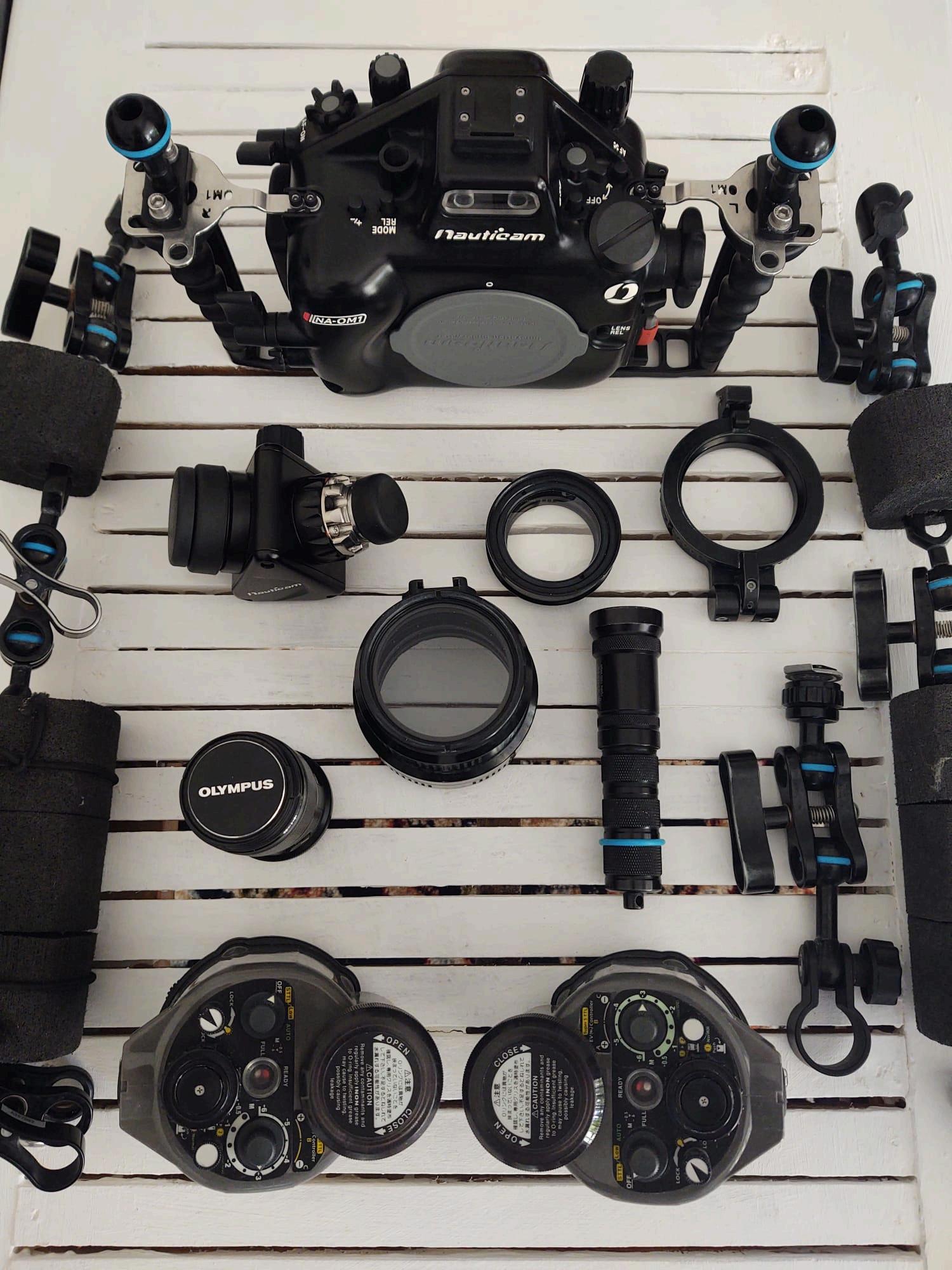
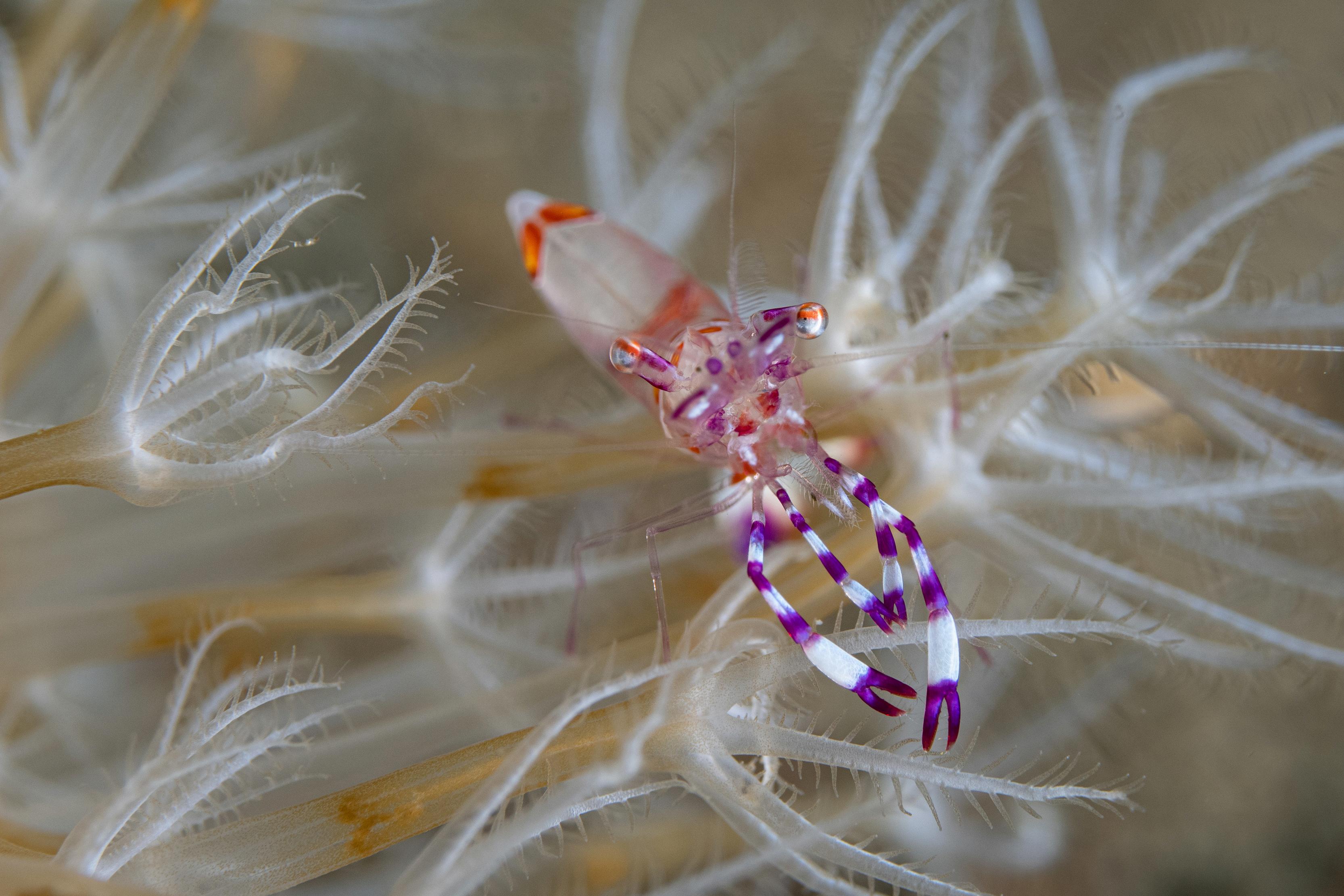
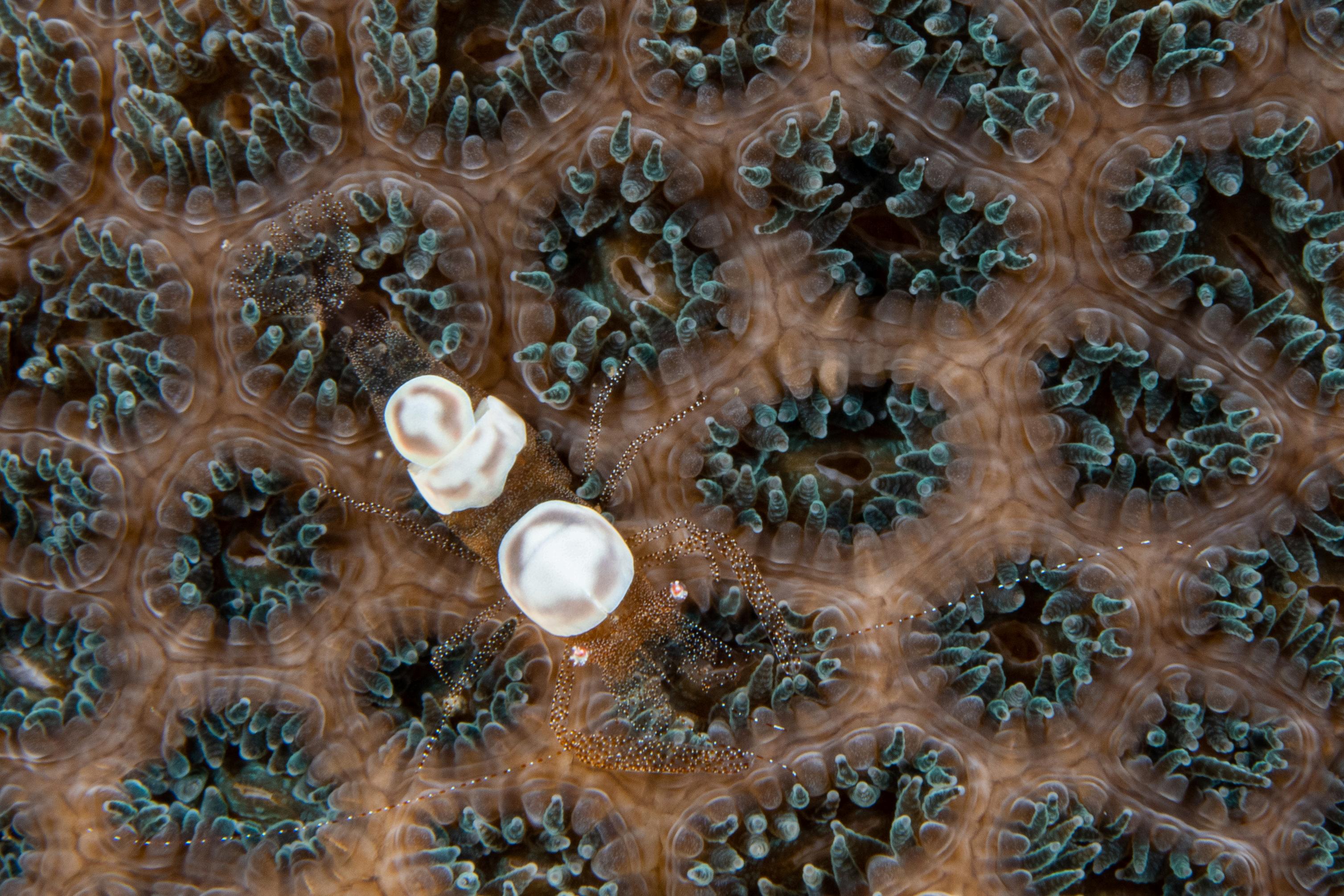


AFTER THE DIVE
Protect Your Camera
After the dive, replace the neoprene dome port cover before removing the camera from the water There are usually many people, dive gear, and cameras on the boat, and the hazard of getting the port scratched is more likely Having a padded crate or a padded cool bag is advised After climbing on board, remember to check if your camera is stored safely and securely
Wash & Dry
Wash your camera thoroughly with fresh water Remember to press all the buttons and turn all the dials while rinsing it Afterwards, dry the equipment with a towel and compressed air if possible Some dive centres, which specialise in underwater photography, provide such driers You can also buy a blow gun fitting for the LP hose, which makes it convenient to use the remaining air from your tank Compressed air removes the water hidden in the places which are hard to reach with a towel
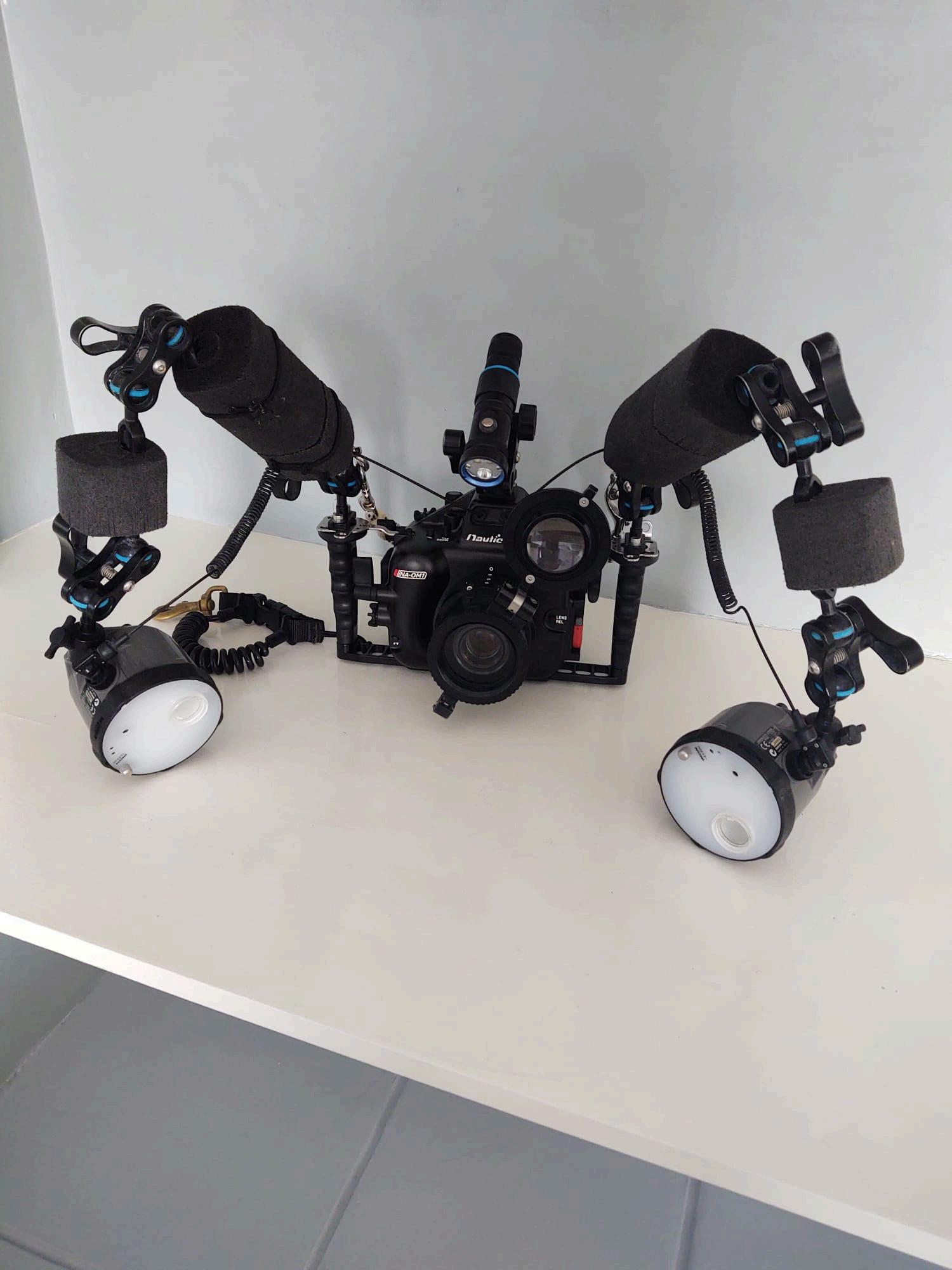
Be Careful
Do not leave your camera in the washing basin unattended Rinse it properly and remove it from the basin. More camera equipment flooding incidents occur in the washing basin than in actual dives. The basins are usually relatively small and can become crowded with cameras, GoPros and the odd dive computer. In the commotion, breaking something or scratching uncovered domes is easy.
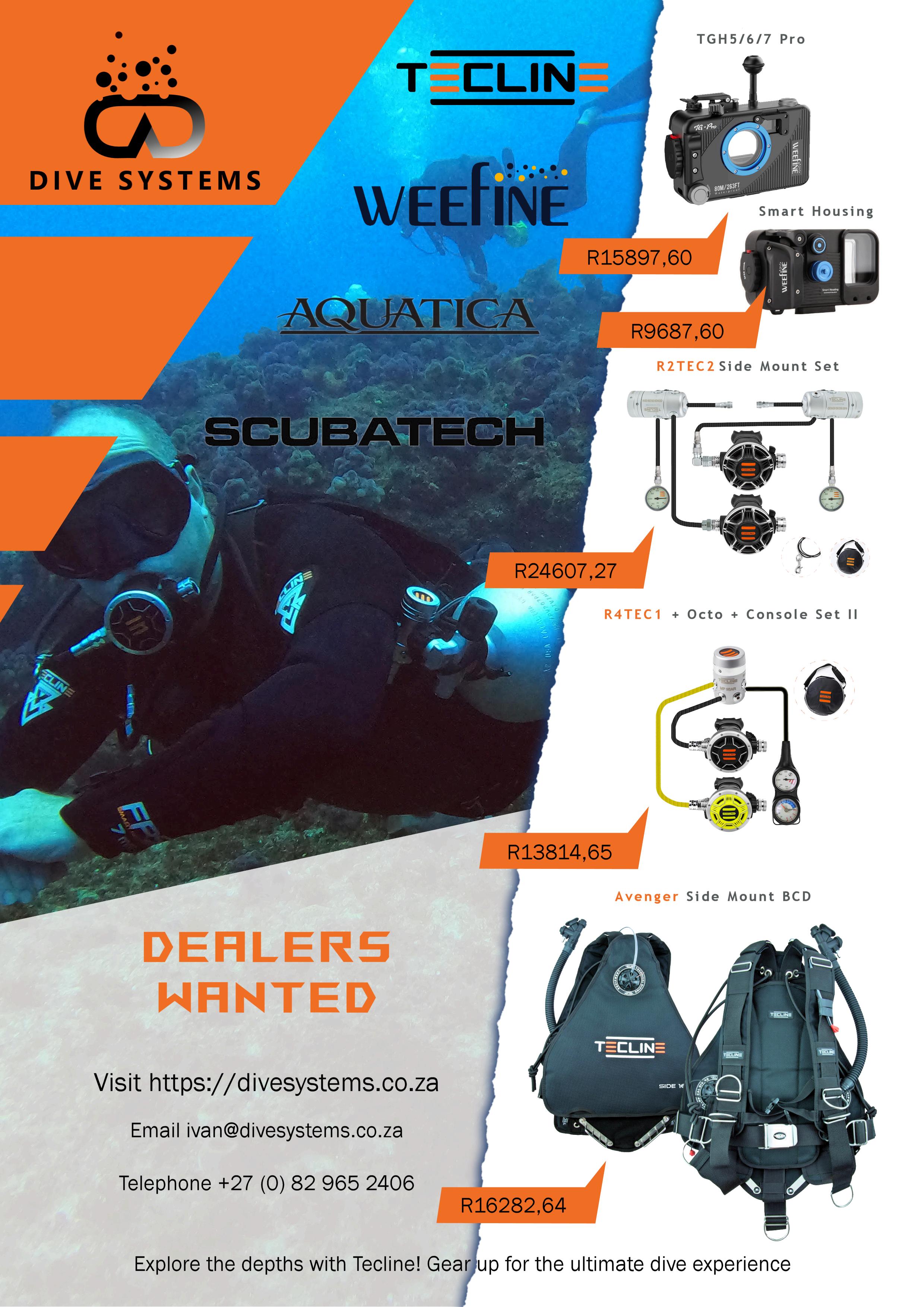

BRIDGINGTHEDIVIDE GEAR
A CASE FOR TAKING RECREATIONAL DIVING UP A LEVEL
TEXTBYIVANVANHEERDEN|PHOTOSBYSTUARTSKENE

In my last article, I made the case for using a Closed-Circuit Rebreather (CCR) in a purely recreational mode. Utilising the benefits thereof for extended times, increased photo opportunities and unique interactions with marine life that only happen when you are on closed circuit.
However, that got me thinking: is there a place for a type of recreational diving that, while not involving deco, will give enough gas and time to run dives lasting over 100 minutes, ie a standard double tank dive? And that doesn’t involve a CCR
The answer was not hard to find, and given the type of diving we do and the nature of the dive sites we visit, it makes perfect sense for the South African coastline
THE CASE FOR RECREATIONAL SIDEMOUNT
Part of the evolution of my diving journey has been to become an importer of dive gear which catered for needs I felt were not being met by gear available in South Africa
as well as the somewhat prohibitive costs of the gear that was. While talking to the owner of one of the biggest dive schools in South Africa about sidemount diving, I was told something that resonated with me.
“I like the idea of sidemount, but the training was so technical it turned me off entirely. I just want to dive for fun!”
WOW!! How do you switch off an entire market segment by making something that should be fun (as all good dive training should be) by making divers feel they are entering a cave system with a blacked-out mask at 70 metres??
Another issue raised was that of the difficulty in setting up the harness That meant that rental gear or try dive-type scenarios would be very difficult to accommodate Certain gear manufacturers have taken that message to heart One recently released a harness with simple-to-adjust straps and webbing, as well as an over-the-shoulder dump valve
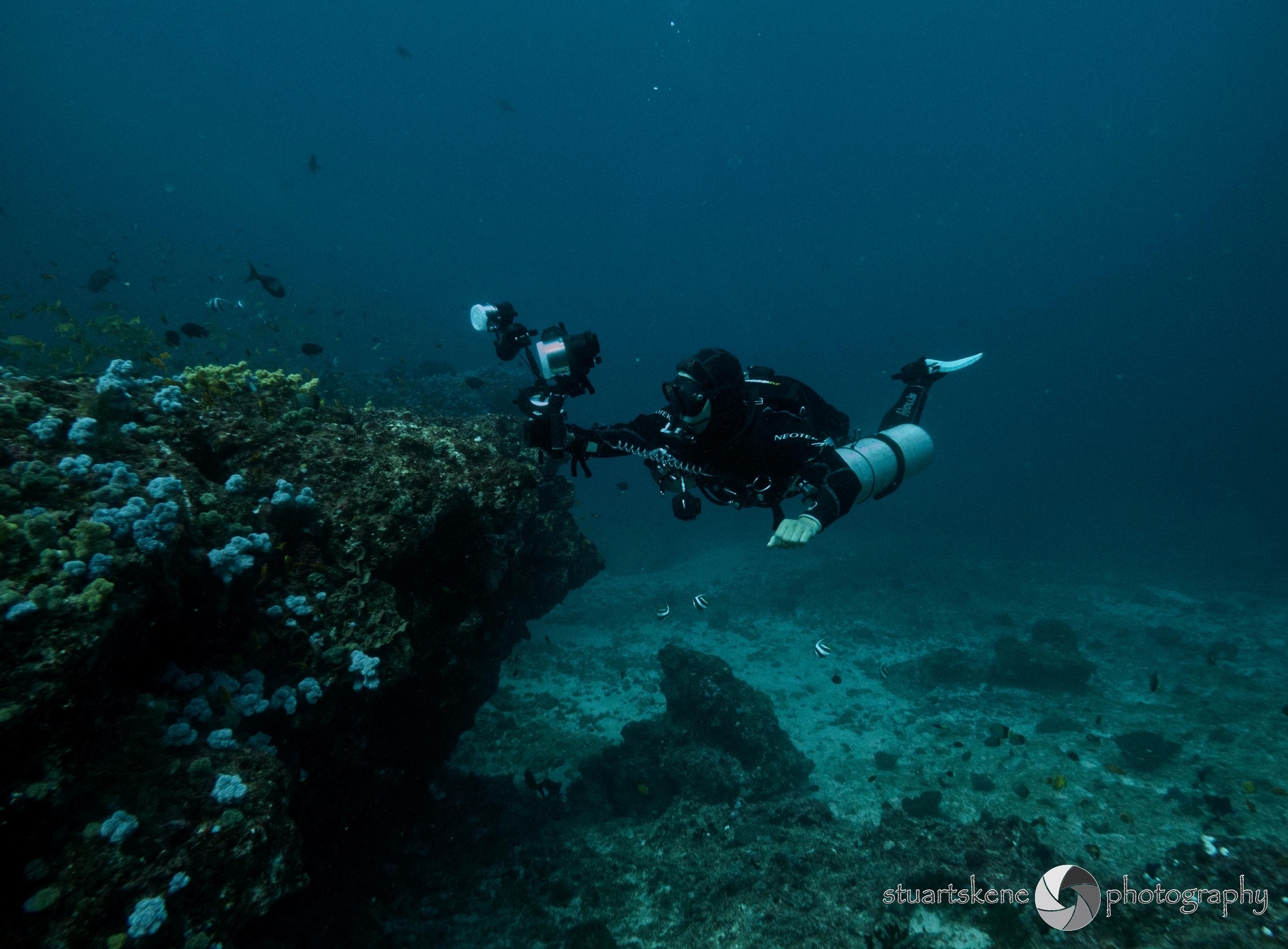
Another very good reason to think about the recreational side of sidemount is for ladies especially, as well as people with back problems, sidemount becomes a very simple solution. No more hunched over with a big steel cylinder hanging on your back by your shoulders, on a bouncing RIB (Rigid Inflatable Boat) waiting to roll backwards into the water.
You sit comfortably in your harness, which may not even have any weights in it, depending on the type of cylinder you are using, and then simply clip the cylinders on and hook the bunnies in place Comfortable while waiting to go in, all the while with no back strain Similarly, ending the dive is now simple: you unclip and hand up the empty cylinders No more wriggling around while hanging onto a bouncing boat No more weight belt to drop to the bottom of the ocean
You also have a very wide variety of cylinders to choose from If you are diving in a drysuit, then steel cylinders become attractive as
they help with the weight you need to carry. In wetsuits, some prefer steel cylinders as they don’t have to have weights in the harness, while others happily manipulate the lighter S80 cylinders.
That takes care of many of the reasons why to dive sidemount, which now leads to gasses and gas management.
ALL
GASSED UP AND SOMEPLACE TO GO!
“So much air, so much time” should be the slogan of recreational sidemount Let’s look at some simple comparisons to see the massive difference Let’s start with a setup much favoured by ladies The 10-litre steel cylinder
10l @ 220 Bar = 2200 litres of air
Let’s assume a lady’s SAC rate is 14l/min (they always beat us men!), and you have a run time of 157 minutes Great, until you work out the rate at an average of 20 metres, and you get 52 minutes only, and that is using all the air in the cylinder If you leave a 50-bar safety margin, 52 minutes drops to 40 minutes
Looking at a sidemount setup and this example, we will use two 7-litre steel cylinders pumped to similar pressure
Thus: 14L @ 220 bar = 3080L of air! Working on the same profile as the example above, the run time of 62 minutes is possible A huge difference! If the same diver now used S80’s, which have 111L, you would have a whopping 4384 Litres of air to play with
For guys who breathe heavier and often run out of air before bottom time, especially when using Nitrox, sidemount becomes the obvious choice
REDUNDANCY SHOULD NOT BE A CHOICE
While many say that sidemount is complicated, it is beautifully simple and best of all, are redundancies built into it Two first stages and two-second stages are good regulators A long hose setup on one cylinder which would be donated to a buddy in an emergency out of air scenario Since you regularly swap your regulators to keep your cylinder gas balanced, you know both are working properly at depth.
How many of you reading this article ever breathed off your octopus at depth for at least 5 minutes, ensuring that it is working? How many of the same readers have had an octo free-flow the second they started breathing on it? This does not happen very often on sidemount because both primary and secondary regulators are the same, and both are used equally, thereby ensuring that any problems are quickly picked up and can be rectified either by a quick adjustment or a service
ALIWAL SHOAL A REAL LIFE EXAMPLE
We have run through the reasons why we should be thinking about running sidemount as our preferred Open Circuit set-up Let’s look at a real-life example of a set of divers that took spending some time underwater seriouslyYou may recall from my first article that I described a 180-minute dive on Aliwal Shoal, using the CCR and not incurring any deco obligation
Certain bubble-blowing dive shop owners took my “Take that bubble blowers” chirp on Facebook to heart and planned a sidemount dive using regular configurations (although they never said what their starting pressure was)
They ran a dive of 185 minutes with an average depth of 11m to pip us CCR divers by a few minutes and claim one of the longest non-technical dives on the Shoal I am, of course, talking about Gary and the Blue Ocean guys, and it exactly showcased the potential of Sidemount on sites like Aliwal
SIDEMOUNT FROM A PHOTOGRAPHY VIEWPOINT
To me, a dive without a camera is no dive at all I really enjoyed the transition to sidemount The feeling of balance and trim you get on SM is fantastic, and there is no more of that overbalanced roll you sometimes get on a back mount If there is any kind of current or surge, the effects are much less noticeable on sidemount, and of course, you have so much more time to take pictures.
As many a photographer will tell you that elusive subject always seems to appear as your needle hits the 50-bar mark or your NDL alarm is flashing! With sidemount, you have that little extra margin of safety that allows for that last shot or 50!
NO MORE SURFACE INTERVALS
Who has been having a great dive when the dive leader calls time, or you hit the dreaded 50-bar mark just as the action was hotting up? Then you begin your ascent with the knowledge that you are now going to be sitting in the sun in choppy conditions for an hour while you struggle to change over your gear With the proper planning (which you should have been taught in your OW20 course), you can easily look at doing 100minute plus dives, thereby avoiding the sometimes extremely uncomfortable, seasick-inducing surface interval
In conclusion
Recreational sidemount is an exciting new take on our traditional diving practices in South Africa It offers redundancy, health benefits and, best of all, longer dives Contact your local dive centre for a chance to go for a try dive on side-mount. Once you try it, I guarantee you will be hooked. See you underwater soon!
About the Author: Ivan van Heerden is the owner of Divesystems. They provide a wide variety of dive equipment and dive and underwater photography accessories. He is based in Durban and regularly dives on the east coast of South Africa See their advert for contact details

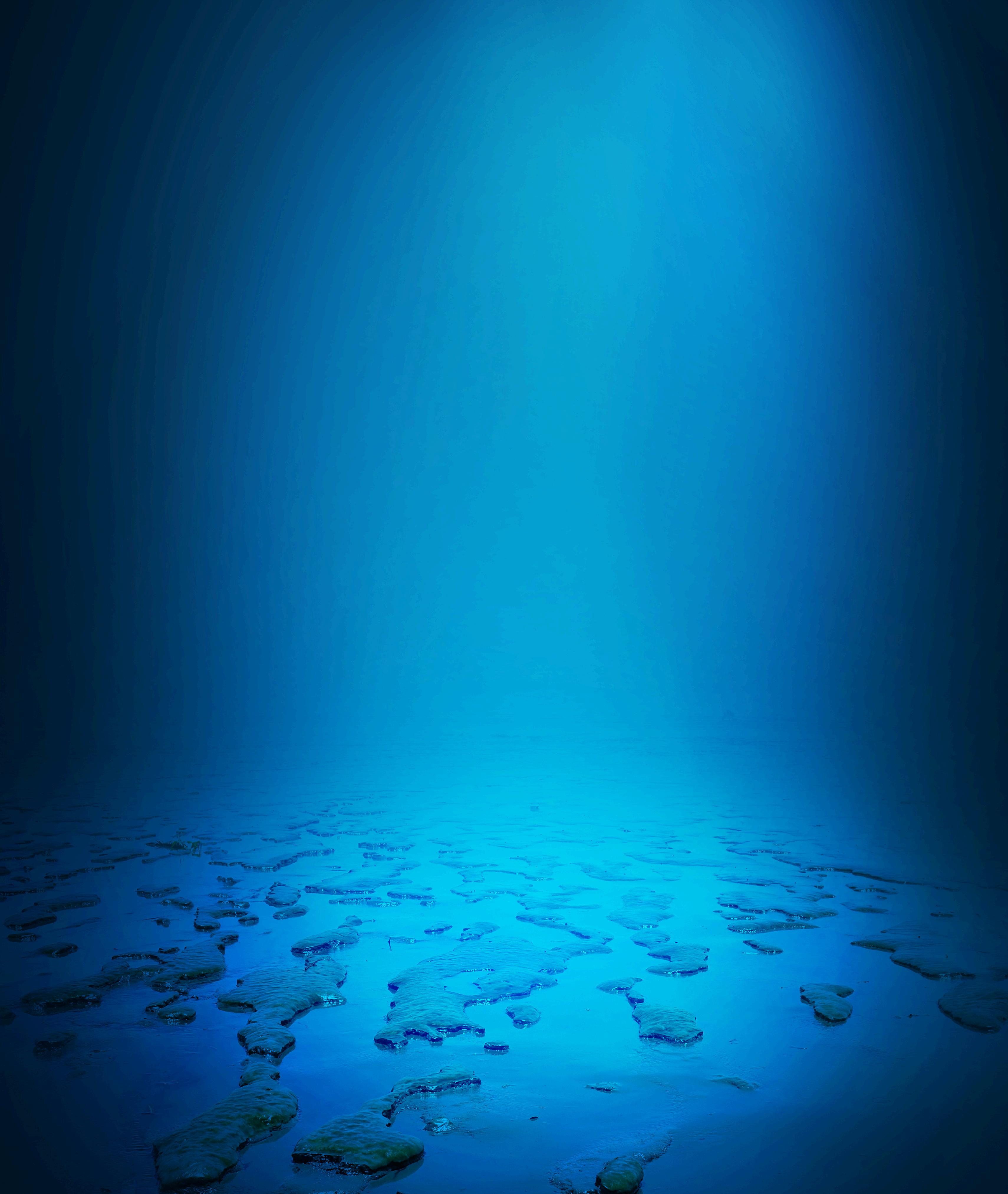



COVER THROUGH
WWW.DANSA.ORG LIFESAVINGBENEFITS-24/7EMERGENCYHOTLINE-ACCESSTODIVE MEDICALEXPERTS-DIVINGRESOURCESTOKEEPYOUSAFE Yourgatewaytodivesafetyservices&worldwidedive coverageatlowannualrates!
DAN
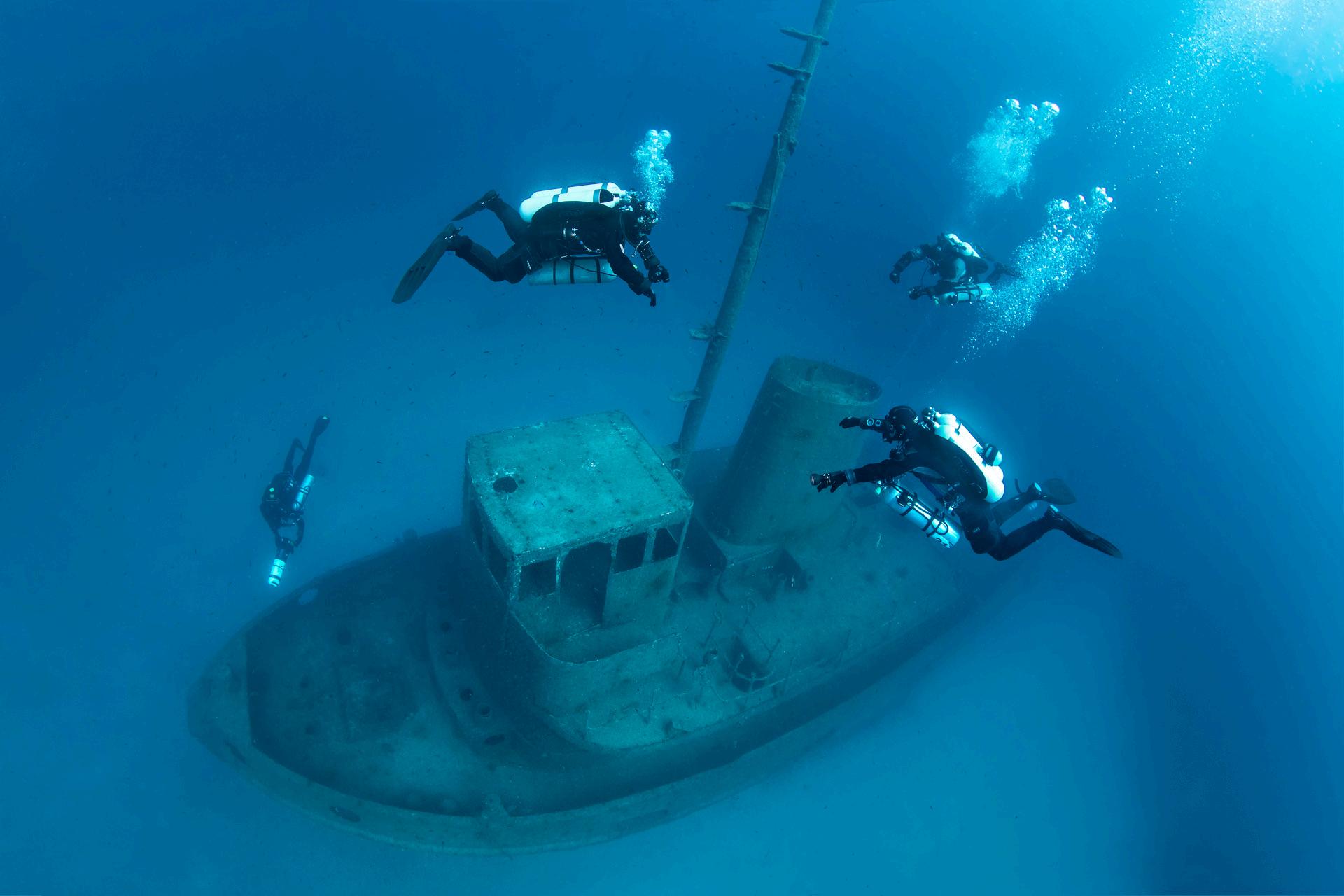
In order to understand and correctly apply gradient factors, we need to understand MValues They are explicitly intertwined
When we ascend at the end of any dive, some of our tissue compartments will contain more dissolved gas than the surrounding ambient pressure relative to depth This creates a negative gradient between dissolved gas tensions and alveolar pressure
We need to manage the extent of that dissolved gas supersaturation so as not to cause gas separation, which risks triggering decompression sickness (DCS).
“Simplifying Diving Physics Through DAN Education”
UNDERSTANDING M-VALUES
UNDERSTANDING HOW M-VALUE LIMITS RELATE TO DECOMPRESSION EDUCATION
TEXT
BY DENNIS GUICHARD | DAN MASTER PRO ACKNOWLEDGEMENT: The contents of this article were developed in consultation with Dr Lyubisa Matity, Consultant Physician, Hyperbaric and Tissue Viability Unit, Gozo General Hospital, Malta

The maximum extent of tissue compartment inert gas tension, at a given ambient pressure, is what are referred to as M-Value limits
We often relate gas absorption and elimination physics to that we understand from scuba class Thanks to the likes of John Scott Haldane who first defined the concept of tissue half-times
Haldane developed a 5-compartment model with half-times ranging from 5 -75 minutes His decompression limit was for a uniform 2:1 critical pressure ratio relating to ambient pressure (ie 2 bar absolute to 1 bar absolute - 10m to the surface)
In 1965, Robert Workman, working for the US Navy, calculated a defined range of limits for individual compartment tensions known as the Workman MValue limits He included consideration of an expanded 9-compartment model, adding extra to the Haldane model. His model considered halftimes ranging from 5-240 minutes.
He contested that the critical M-Value limit was not the critical pressure ratio, but a critical pressure difference of 0.58atm between tissue tensions and ambient pressure in respect of the Nitrogen inert gas content only.
He acknowledged that each compartment could tolerate a different level of over-pressurisation Workman’s M-Values related to depth pressure which he used to form a range of sloping M-Value lines These represented the change of maximum allowable M-Value limit related to depth for each compartment
Professor Bühlmann redefined those initial limits further in 1983 with his ZH-L12 algorithm (a 16compartment model with 12-coefficient values) considering half-times from 265-635 minutes And again in 1990 with his ZH-L16 algorithm which considered an adjusted 4-635 minute range of compartment half-times He included a set of ‘a’ and ‘b’ parameter values mathematically related to those compartment half-times The ZH-L16 algorithm permitted greater over-saturation in the faster tissues than previously considered
He thereby defined varying M-Value limits for each of his compartments in relation to ambient pressure rather than just depth This meant Buhlmann’s decompression algorithms could also be used at altitude
The Bühlmann M-Value limits are more conservative than Workman’s, specifying lower maximum compartment tension limits
Because M-Values are calculated for each compartment, there isn’t just one line to decompress against Our dive computer needs to track whichever our leading compartment might be during ascent And that changes depending on the exposure profile of any dive, and also during our ascent
We need to manage our decompression in consideration of whatever that specific limiting compartment gas tension is. Because hypothetically that is where bubbles are proposed to be at risk of forming due to gas separation (Refer to Heat Map).
An M-Value then is simply the maximum allowable total gas tension limit in any given compartment, at a given ambient pressure (Refer to Graph 1) There has been much debate and research into how we might optimise safe decompression in respect of those limits
A challenge is that M-Value limits physiologically are not fairly a hard clear binary line but rather a messy grey zone area around which ‘safe’ limits might be quite different intra-personally (for us at different times) and inter-personally (between each of us)
Professor Bühlmann himself even fairly described his own M-Value limits as only being a DCS differentiator between a ‘limited number of symptoms’ and a ‘massive number of symptoms’
They are not a ‘cure’ for DCS risk and were probably never intended to be
DAN research also shows that a vast proportion of DCS occurrence is in divers who are well within that maximum permissible M-Value limit DCS is a complex interwoven multi-factorial malady, and not simply restricted to the generation or presence of bubbles Although of course we need to have them to have DCS But they are not the full picture
That said, there have thus long been debates around how close to that hypothetical M-Value line it might be ‘safe’ to approach without triggering decompression sickness And similarly, endless debate around quite how we might optimise a strategy to control gas tensions but still drive efficient off gassing
We will look more closely at gradient factors and their application to modifying M-Values in a separate article.

ProsChooseDAN TrustedWhenItMattersMost

Michael AW, Underwater Photographer, Director, Board Member, Ocean Geographic, explains why he chooses DAN.
Dive Safety Alert Diver DIVERS ALERT NETWORK
W A T C H V I D E O

Scuba diving demands not only physical fitness but also proper nutritional preparation. Like with any activity, we expend energy while diving; surprisingly, the energy required for routine recreational diving is somewhat moderate. Under unusually strenuous recreational conditions, however, it’s possible to burn more than 500 calories.
There is no need to eat more in preparation for diving Following a regular diet of foods that provide nutritional value is sufficient
Our bodies harness the nutrients we ingest for energy, with carbohydrates, fats, and proteins being the three primary sources Carbohydrates, often referred to as sugars, are vital for endurance and are the preferred energy source for athletes and divers
OPTIMAL NUTRITION
EDUCATION
TEXT BY GUSTAVO MAUVECIN, MD
Optimal Nutrition for Diving
Carbohydrates come in two categories: simple and complex Simple sugars (such as glucose and sucrose) are found in honey, fruit juices, and junk food The digestive system rapidly absorbs these sugars, leading to a spike in blood sugar levels and subsequently triggering insulin release Excessive consumption of simple sugars can result in sudden drops in blood sugar levels, appetite stimulation, and unhealthy weight
In contrast, complex carbohydrates found in foods such as peas, beans, whole grains, and vegetables release sugars into the bloodstream more gradually, preventing sudden spikes and crashes in blood glucose levels
Carbohydrates serve various functions, including providing fuel in the form of glucose for muscles, the brain, and other organs Additionally, the liver and muscles store the carbohydrate glycogen for energy during intense exercise. Each gram of carbohydrate provides four calories.
Fats, another essential dietary component, are the body’s primary energy storage and play crucial roles in thermal insulation, organ protection, and cell structure. We generally categorise them as “good” (unsaturated) and “bad” (saturated and trans) fats. Each gram of fat supplies nine calories
Proteins are indispensable for tissue formation, energy production, injury repair, and nutrient transportation throughout the body Proteins consist of nine essential amino acids we must obtain through diet because the body does not produce them Every gram of protein provides four calories
Water is the human body’s most abundant component, constituting between 50 and 70 percent of total body weight It plays pivotal roles in digestion, waste excretion, blood circulation, and temperature regulation
Proper hydration before and after diving is important for preventing dehydration’s
adverse effects on physical performance and eliminating dissolved inert gases from body tissues Dehydration can lead to decreased blood fluid volume, further underscoring the importance of staying adequately hydrated It is advisable to gradually consume fluids during the day, and you may need more than usual if you are exercising or the weather is hot and humid Proper hydration may also prevent muscle cramps and fatigue and reduce the risk of decompression sickness Your food also provides a large percentage of your daily fluid requirements Remember that overhydration can be a factor in the development of pulmonary oedema
It is best to avoid overeating, especially when diving On the day of the dive, consider including foods rich in complex carbohydrates to maintain steady energy levels Many people avoid heavy, fatty meals before diving to mitigate gastrointestinal discomfort. Refrain from any alcohol consumption since it affects cognitive abilities and can contribute to dehydration.
You might have an increased hunger sensation after a dive, possibly due to the need for water, but avoid overeating to satisfy that feeling. Good food choices include rice, pasta, potatoes, and fruits. Avoiding evening alcohol consumption, which can exacerbate dehydration by inhibiting the antidiuretic hormone, is especially helpful if you plan to dive the next day
Following these recommendations will optimise your nutrition and help ensure a s




COVER THROUGH DAN WWW.DANSA.ORG LIFESAVINGBENEFITS-24/7EMERGENCYHOTLINE-ACCESSTODIVE MEDICALEXPERTS-DIVINGRESOURCESTOKEEPYOUSAFE Yourgatewaytodivesafetyservices&worldwidedive coverageatlowannualrates!
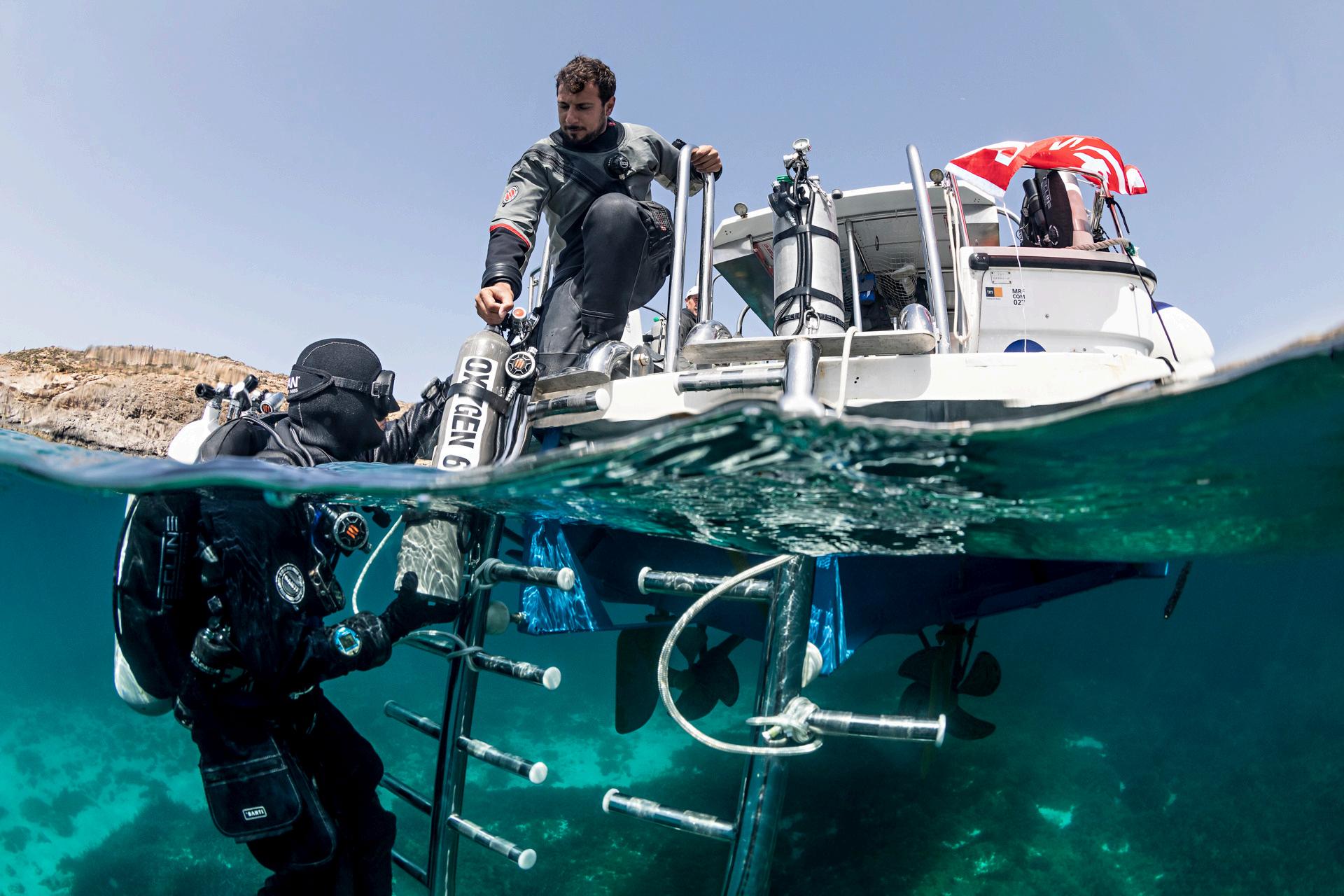
The application of gradient factors to modify the Bühlmann ZH-L16 M-Value limit has intrigued and perplexed divers endlessly The Internet is awash with propositions for strategies in seeking to optimise technical decompression diving, thereby aiming to minimise risk of acute Decompression Sickness (DCS)
Researching gradient factors and their application to M-Value modification online proved to create more confusion than clarity. Gradient factors often seem to be arguably misrepresented and miscalculated. This narrative seeks to understand gradient factors at their core and how they relate to M-Value modification.
WHAT IS AN M-VALUE
When we expose ourselves to increases in ambient pressure, ie, when we go scuba diving, our various tissues absorb inert gas in relationship to depth and time exposure
BENDING
BÜHLMANNWITH GRADIENTFACTORS
DECODING GRADIENT FACTORS
EDUCATION
TEXT BY DENNIS GUICHARD | DAN MASTER PRO
ACKNOWLEDGEMENT: The contents of this article were developed in consultation with Dr Lyubisa Matity, Consultant Physician, Hyperbaric and Tissue Viability Unit, Gozo General Hospital, Malta
When we ascend at the end of any dive, some of our tissue compartments will contain more dissolved gas than the surrounding ambient pressure relative to depth We of course need to eliminate that excess inert gas in a safe controlled, but efficient manner
During our ascent we create a negative gradient between absorbed gas tensions and alveolar gas pressure In a Bühlmann decompression algorithm model that excess gas tension is assumed to remain dissolved in tissues Unless we exceed the M-Value limits
An M-Value then is simply the maximum allowable total gas tension limit in any given hypothetical tissue compartment, at a given ambient pressure According to limits defined in this narrative by Professor Bühlmann
UNDERSTANDING GRADIENT FACTORS
Erik Baker introduced the concept of gradient factors (GF) as a way of controlling tissue supersaturation in decompression. They are a useful tool for modifying M-Value limits.
Gradient factors however are not just a simplistic percentage reduction of M-Values It is incorrect to represent them as such The percentage reduction influenced by a chosen GF fraction only applies to the part of the M-Value in excess of ambient pressure, not to the M-Value as a whole (Refer to Graph1)
So, they need to be calculated as a mathematical representation thereof, by:
First subtracting the ambient pressure from the total M-Value, 1 Applying your gradient factor, 2 And then adding back the ambient pressure value 3
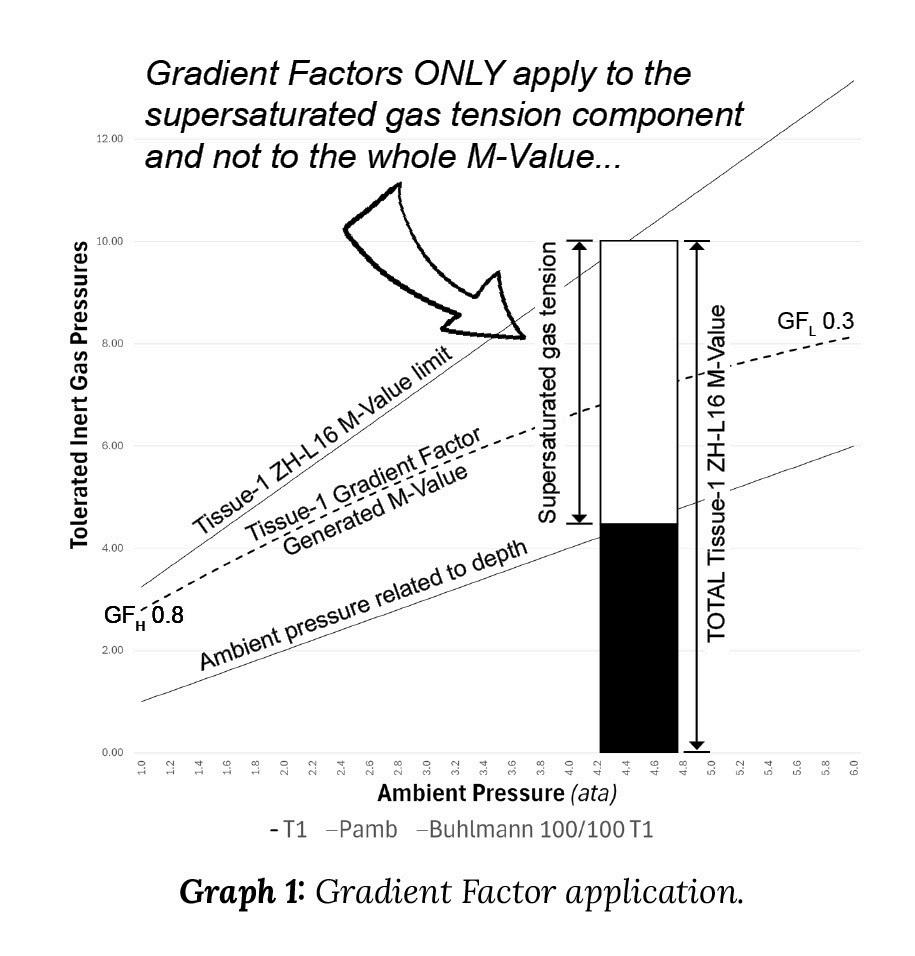
Gradient factors are proportions defined between zero and one, although they can have a value in excess of one if we exceed the M-Value limits They are as such dimensionless on their y-axis (Refer to Graph2)
If a line is drawn on a GF-related graph that has pressure indicated on the y-axis, that is not a gradient factor line, that is a Gradient Factor Generated M-Value line
That is a ‘Gradient Factor Generated M-Value’ line.
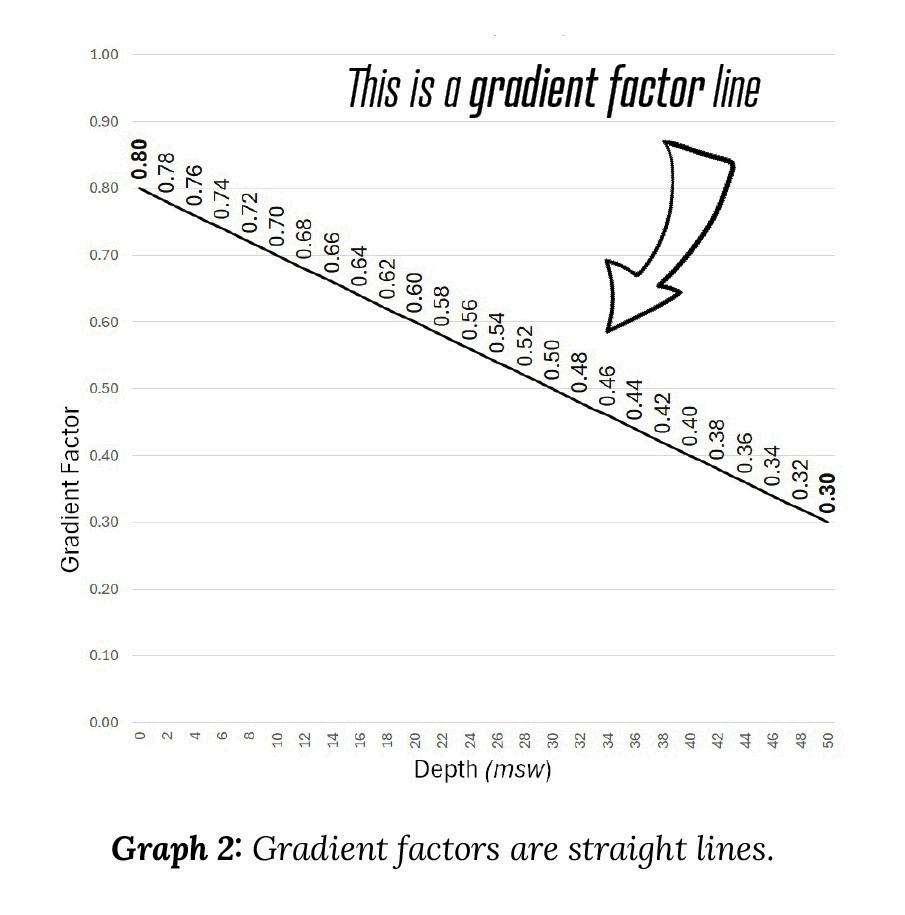
Gradient factors are not probabilities either, as diving to 80% of Bühlmann’s permitted supersaturation limit will not give you 08 of the original DCS probability DCS is a substantially more complex multicontributory malady
Gradient factors none-the-less are a helpful tool for planning decompression in diving We also use them in recreational diving as a way of adding conservatism to lower decompression stress and DCS risk
DECODING GRADIENT FACTORS
Baker defined gradient factors as a value between zero and one, ie, 0≤ GF ≤1 This represents a fraction of permissible supersaturation during decompression from any dive exposure, in relation to the Bühlmann M-Value limit
So, if we wanted to surface at say no more than 70% of the permissible supersaturation, we would need to set our GF-high parameter, which is related to surfacing, to 0.7 or 70%.
Gradient factors relate to the difference between the Bühlmann ZH-L16 M-Value
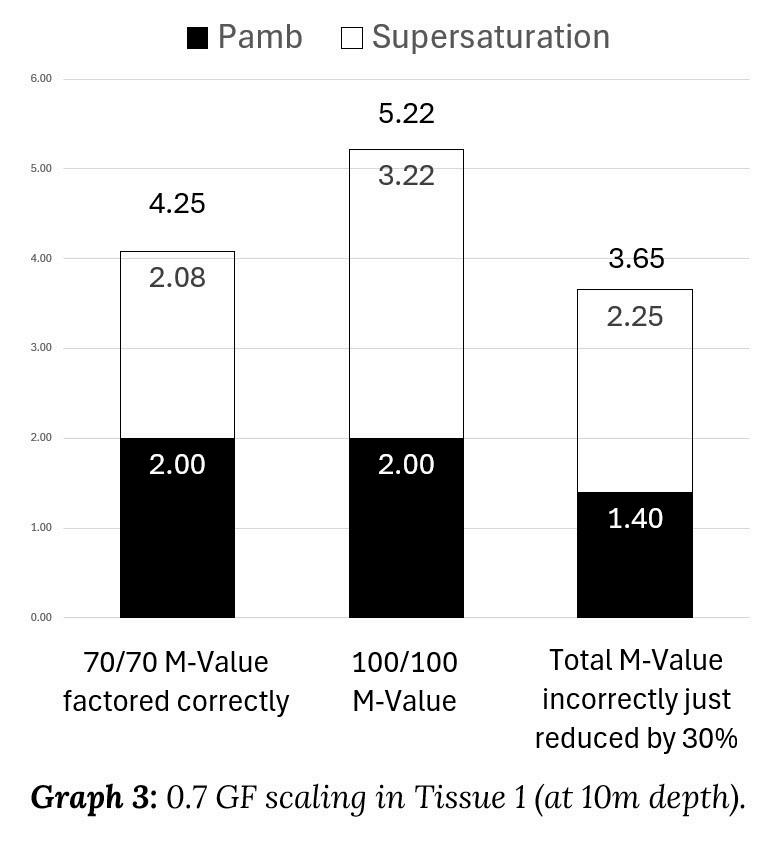
limit and ambient pressure at a given depth, ie, a compartment supersaturation pressure It is a common misconception that gradient factors are just a percentage reduction of the total permissible gas tension M-Value This can result in an error of calculation (Refer to Graph3)
We might for example set our GF-low parameter to 06, or 60% So, our gradient factor on a dive would in this instance be values between those two fractional values, ie, GF 06/07 (60%/70%)
Gradient Factors are
not MValues themselves but rather a tool for M-Value modification.
Baker’s depth formula for calculating gradient factors defines GF as a linear function with respect to actual depth In other words, he is connecting GF-high and GF-low values with a straight line on a graph that has a depth on the x-axis, and a dimensionless y-axis with values ranging from 0 to 1
Baker also included a useful formula for gradient factor modification including consideration of the ZH-L16 ‘a’ and ‘b’ parameter values, to be representative of absolute pressure instead
BENDING BÜHLMANN
If GF-high and GF-low are not the same, GF becomes a linear function with respect to depth or ambient pressure. The original MValues are also a linear function of pressure. Applying GF to the original M-Values then produces a quadratic term, so the GFgenerated M-values do not fall on a straight line, but on a parabola.
One could impose linearity on the new MValues by connecting the surfacing M-value with the one at the first ceiling But that
would require departing from the way Baker defined GFs and the corresponding GF values would then not fall on a straight line
In other words, if you make one linear the other one will naturally curve (Refer Graph4)
If, however, both gradient factors are equal (i.e., GF 70/70), then the GF transformation is reduced to scaling the permissible supersaturation via GF-high.
Because the numerator in the gradient factor slope formula is then zero (two equal gradient factors cancel each other). In this specific instance the GF-generated M-Values will indeed be linear
If we apply gradient factors to each of the ZH-L16 compartments, we are able to graph a set of Gradient Factor Generated M-Values as presented (Refer to Graph5)
‘Gradient Factor Generated MValues’ are parabolic curves, they are not straight lines between two points.
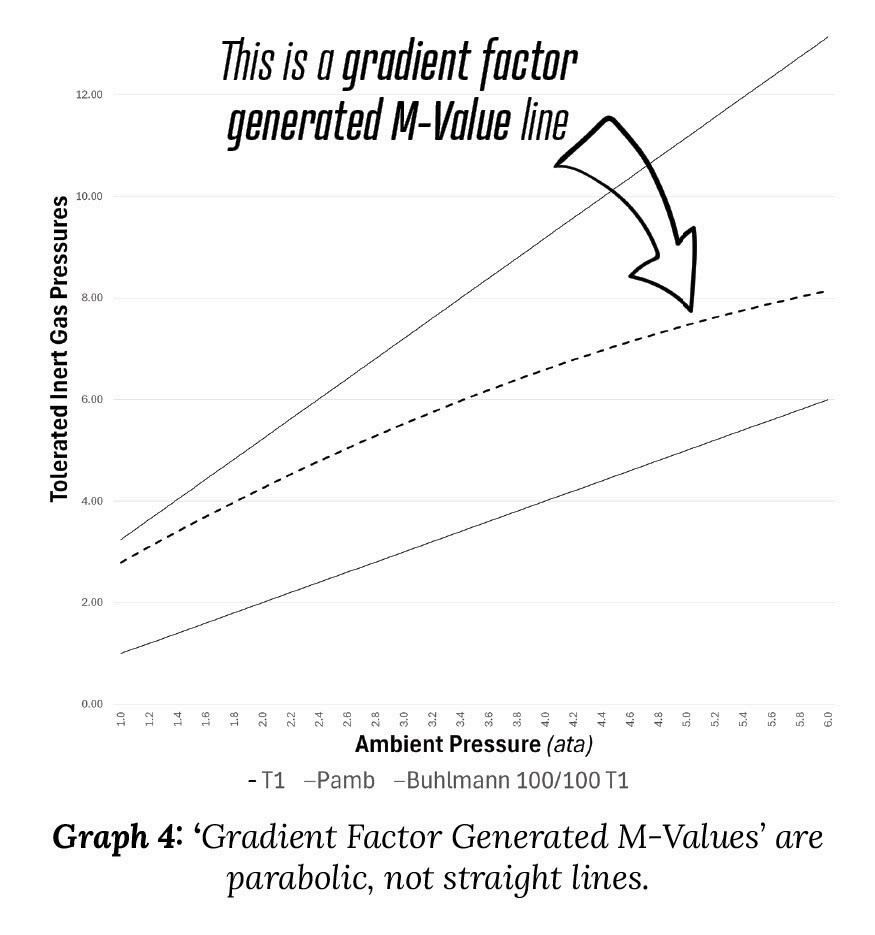

DEFINITIONS
Supersaturation - is related to the inert gas content ‘prescription’ part of the decompression model, as that is what dissolved gas models try to control Other gases participate in supersaturation and gas separation, but those are not subject to model control
Supersaturation pressure - is what determines gas separation This is the sum of all gas tensions, inert or not, in excess of ambient pressure i e , ppO2, ppN2, ppCO2, & ppH2O
M-value - is the maximum allowable gas tension in a given compartment at a given ambient pressure.
Gradient factors - are a useful tool for modifying M-Value limits. They however are not just a simplistic percentage reduction of total M-Values. The percentage reduction influenced by a chosen gradient factor fraction only applies to the supersaturated gas content part of the compartment MValue, not the M-Value as a whole.
ProsChooseDAN TrustedWhenItMattersMost

Maurtius Valente Bell, Dive Safety Officer, California Academy of Sciences, explains why he chooses DAN.
Dive Safety Alert Diver DIVERS ALERT NETWORK
W A T C H V I D E O

SUSPENSION TRAINING
DIVE FITNESS
TEXT BY JESSICA B ADAMS, PH.D
Suspension training adds instability to make every exercise a total body workout Since a stable core is essential for all in-water movements, these core-blasting exercises are perfect for scuba divers For example, when finning, the muscles that flex and extend your hips also pull on your pelvic bones. Weak pelvic stabilizers can lead to lower-back pain following extensive finning.
Safe and effective for professional athletes, Navy SEALs and weekend warriors of all ages and fitness levels, suspension training consists of bodyweight exercises using nylon straps attached to a doorjamb, tree limb or other stable overhead attachment point.
It’s easy to adjust the difficulty of the exercises by simply moving the feet forward or backward or by standing on one foot rather than two The most popular suspension system is from TRX®, but less costly alternatives are also available The lightweight nylon straps are travel-friendly, making it possible to work out just about anywhere no weights or gym required.
The world is your gym if you take up versatile, impactful suspension training. Take the lightweight nylon straps with you and enjoy a full-body workout just about anywhere.
SUSPENSION TRAINING GETTING STARTED
With each exercise, perform as many slow, controlled repetitions as possible for 30 seconds, then take a 10-second break. Repeat until you complete three sets of each. (If you’re not quite ready for three sets, start with one and work up to two or three.)
Always listen to your body: The goal is to slowly overload your muscles to achieve maximum benefits while minimizing the risk of injury Once the exercises start to feel easy, increase your angle slightly to make them more challenging, but keep movements controlled Remember to breathe as with scuba, never hold your breath (it causes a spike in blood pressure and could lead to fainting)
The core is the primary target of all these exercises; all other muscles are secondary targets Stop as soon as you lose core stability (sagging or wiggling); regain your form, and then continue if possible
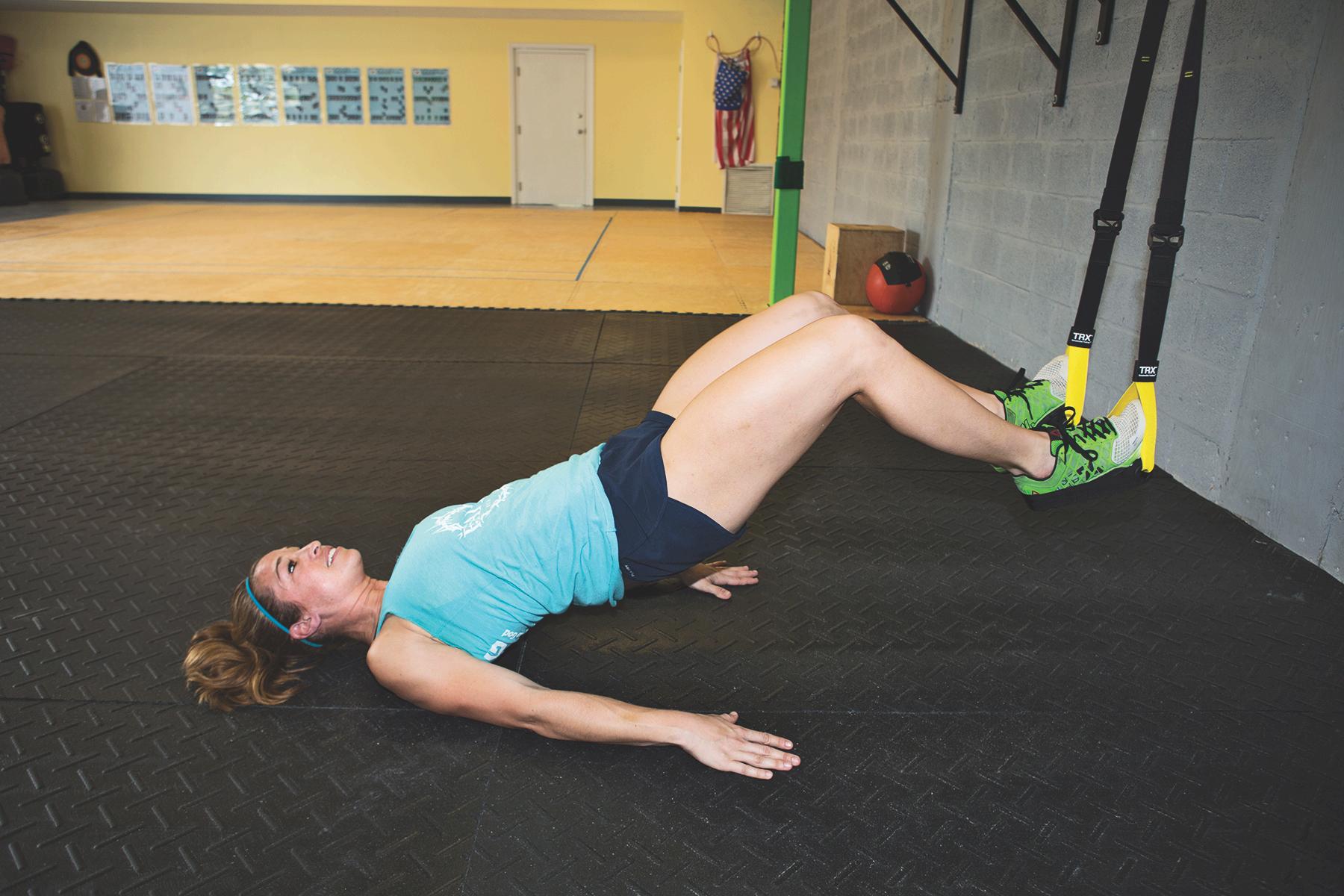

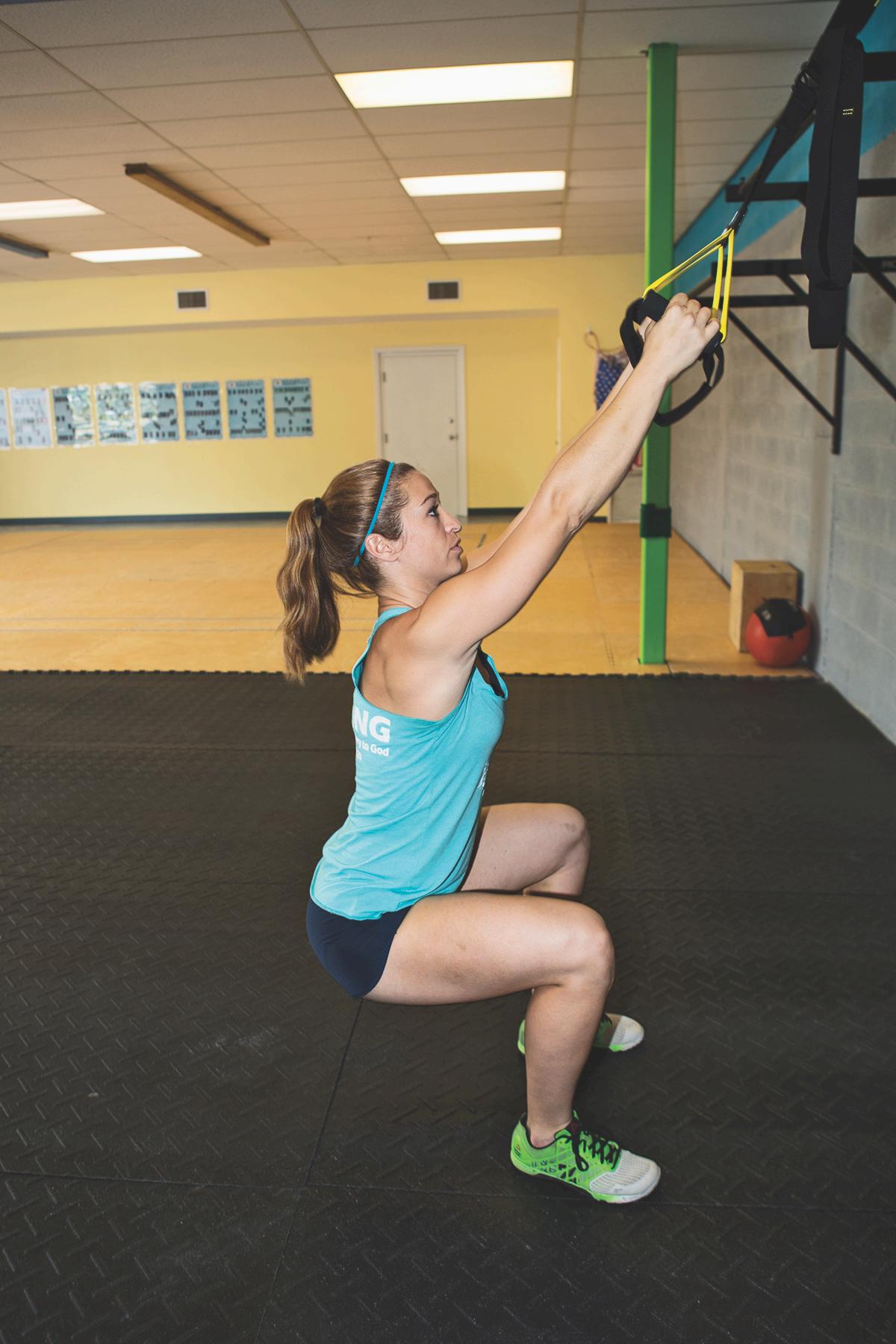
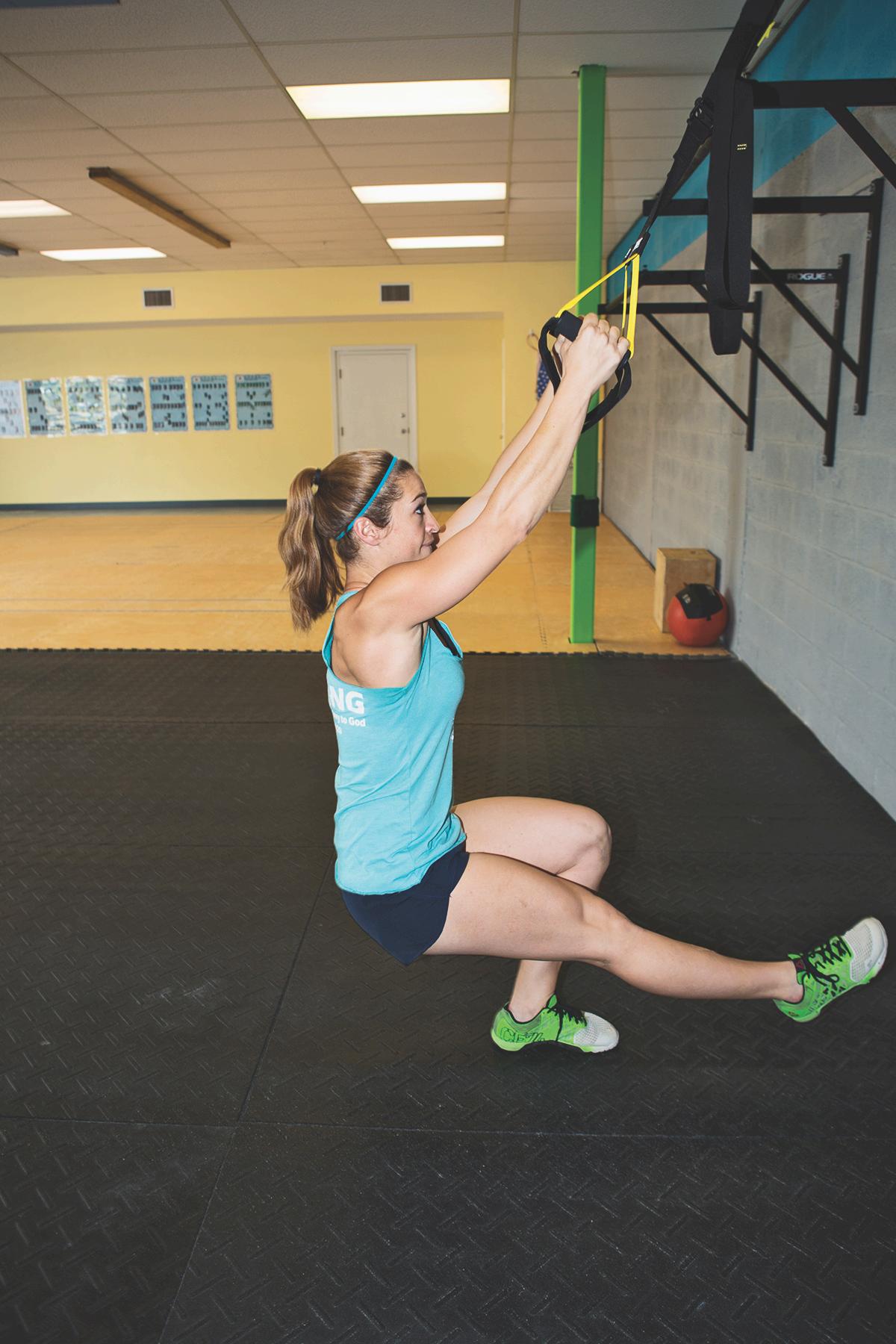
SUSPENSION SQUAT
EXERCISE 1
Squats are important for divers as they help develop muscles that facilitate standing up in scuba gear. The suspension squat is a versatile squat exercise because minor variations can be applied to either support or challenge you. Newbies benefit from the ability to truly sit back into the squat position, taking undue stress off the knees. Athletes can safely progress to a deeper squat with a greater range of motion and eventually to a one-legged (pistol) squat
1
Hold the handles at chest height with your arms at your sides and your elbows bent Your feet should be slightly wider than shoulder width and weight should be in the heels
2
Slowly sit back and down as if sitting into a chair, keeping your weight in your heels with your chest and head slightly up
3
Your knees should stay over your toes, but don’t look down to check
Ask someone, record yourself, or look in a mirror
4
Descend as low as is comfortable or until you feel your tailbone swing under Everyone has a different initial depth to their squat You will gradually be able to go deeper into your squat as you progress Thighs parallel to the floor is a good benchmark, but more or less is OK depending on your fitness level
CHALLENGES
Increase the depth of your squat and narrow your stance to challenge your balance Once you have reached the point where your feet are touching, perform the full squat with one leg raised in front of you
49


SUPPORTED PULL-UPS
EXERCISE 2
These exercises target the core as well as the upper-body musculature used when climbing a ladder in scuba gear.
1. Fully extend your arms while maintaining a stable core 2 Using your arms, pull yourself back to the starting position 3
Hold the handles close to your chest, and lean back as far as you feel comfortable. Move your feet to the appropriate location for your preferred resistance
TIPS
A stance slightly wider than your shoulders is easier than a narrow one The more vertical your body, the easier the exercise; the more horizontal your body, the more challenging the exercise If your core begins to sag, stop and reposition yourself You may need to adjust your foot position
49
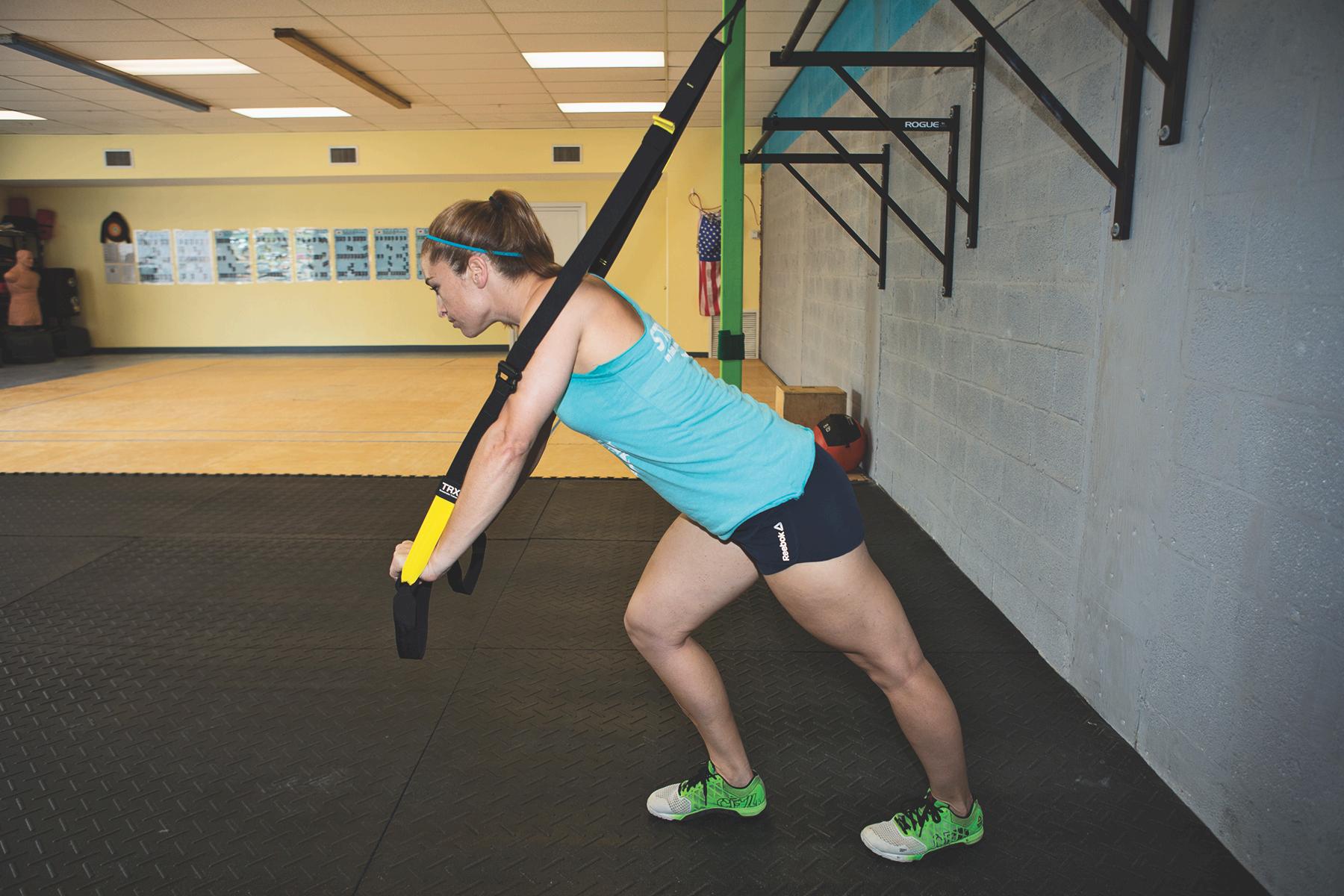
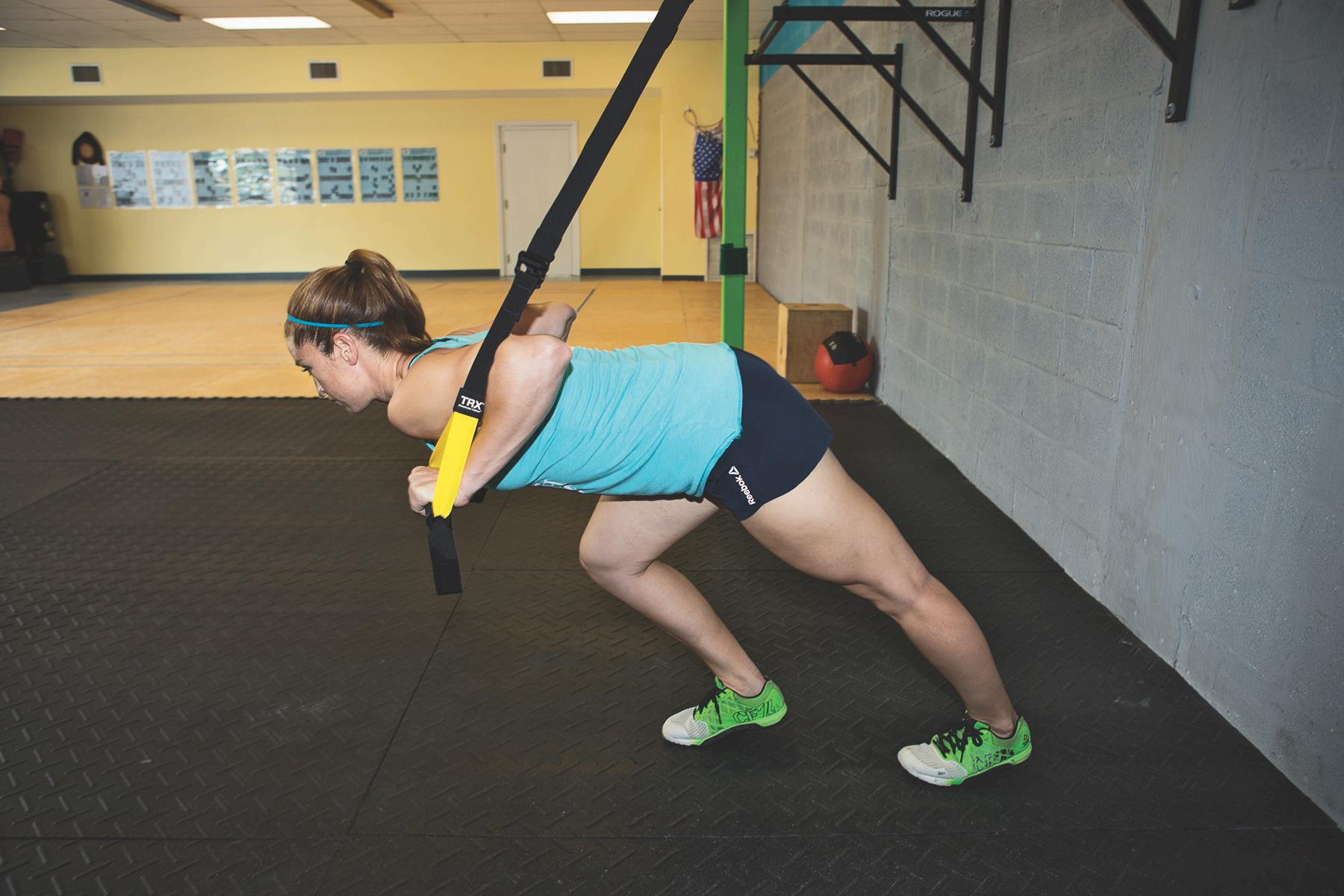
CHEST PRESS EXERCISE 3
Think of this exercise more as a moving plank than a chest press because core stability is the primary focus. The chest press component is important to balance the back muscles worked during the pull-ups.
Hold the handles below chest level, with your shoulders down. 1. Step one leg into a lunge position and lean forward, transitioning your weight to your front leg and hands As you progress, you will be able to put more weight on your hands and ultimately complete the movement in more of a push-up position than a lunge 2 Fully extend your arms while maintaining a stable core 3
TIPS
Keep your shoulders down (away from your ears), and hold in your ribs by keeping your abdominal muscles engaged throughout the movement
49


BRIDGE
EXERCISE 4
The bridge targets the posterior chain muscles (e.g., lower back, glutes, hamstring and calves). Strong hip and back extensors will help divers glide comfortably through the water. These areas are frequently neglected during training (not to mention in daily living).
Set up your suspension straps so the handles hang just below your knee caps 1 Sit down, and using your hands to help, place your heels into the straps with the soles of your feet on the handles 2
Lay back, and extend your legs 3
Extend through your hips, raising your lower back as high as possible 4
Relax, and lower your body to the ground 5
TIPS
The straps should hang directly below the anchor point if possible Maintain a tight core throughout
CHALLENGES
While your body is elevated, flex your knees to bring your heels toward your buttocks. This will increase the load on your hamstrings.
NOTE
To avoid an increased risk of decompression sickness, DAN recommends that divers avoid strenuous exercise for 24 hours after making a dive
During your annual physical exam or following any changes in your health status, consult your physician to ensure you have medical clearance to dive
49

DELIVEROXYGENFASTER
WHENEVERYSECONDCOUNTS
Respondtoadiveincidentfasterwith DANemergencyresponsegear.
WWW.DANSHOP.CO.ZA
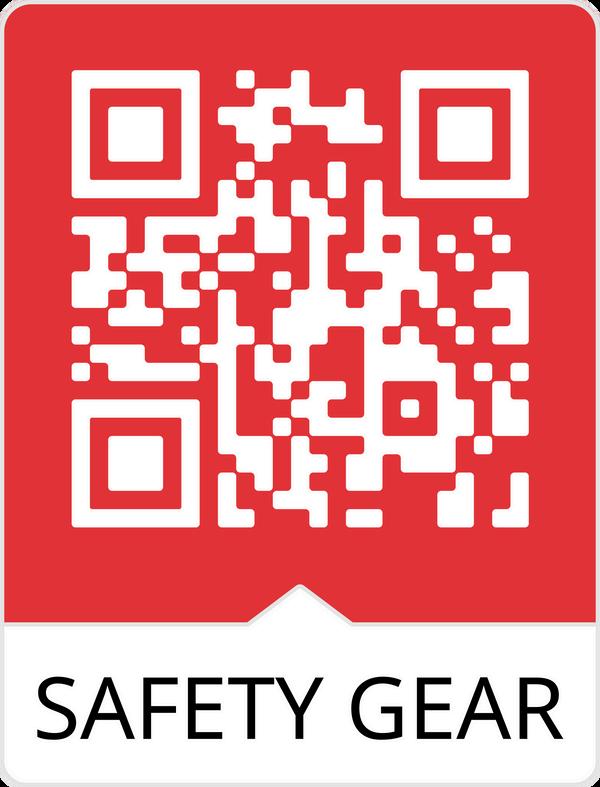
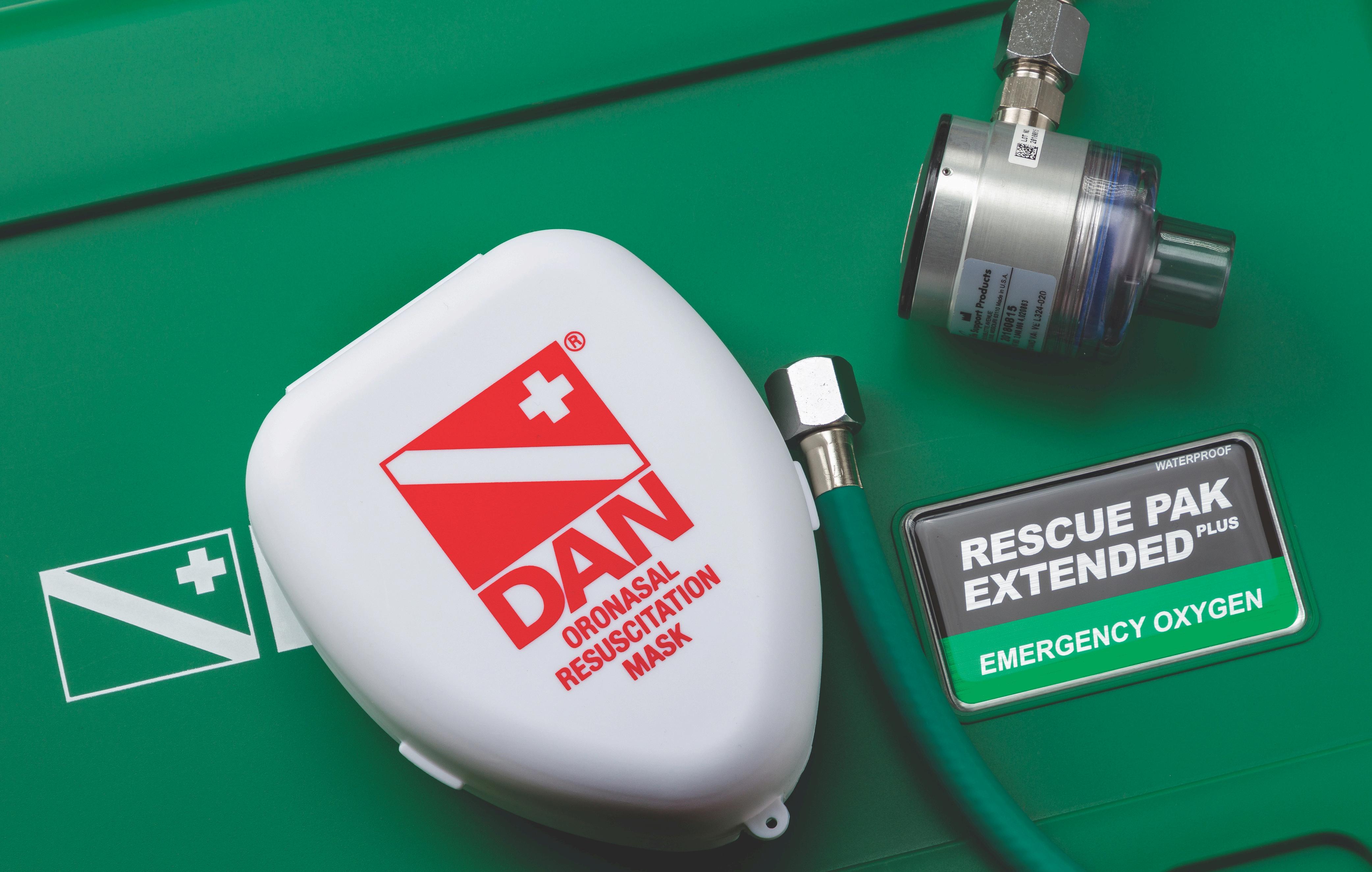
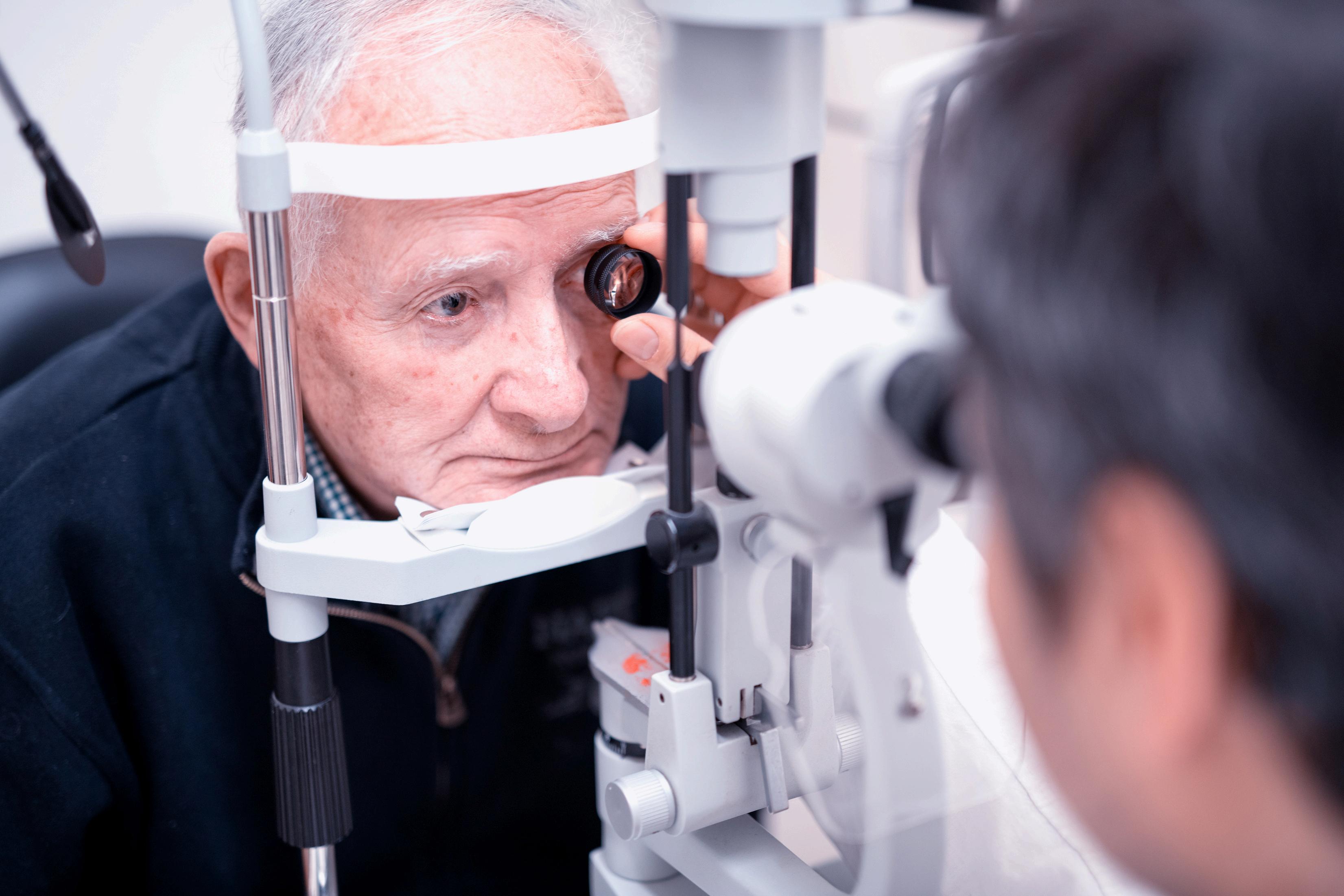
DIVING AFTER AN EYE STROKE
FROM THE MEDICAL LINE
DAN MEDICS & RESEARCHERS ANSWER YOUR DIVE MEDICINE QUESTIONS
Q | I recently had an eye stroke. Can I still dive after it has been resolved?
The main concerns with an eye stroke (central retinal artery occlusion, or CRAO) are the underlying cause and the medications your doctor prescribed for treatment. Before returning to diving, work with your ophthalmologist or physician to determine the root cause of the initial ocular stroke, the probability of recurrence, and your overall cardiovascular health You should have a physician’s release for unrestricted rigorous physical activity
Blood thinners and anticoagulants pose a danger for uncontrolled internal bleeding due to barotrauma caused by failure to equalise properly Equalisation techniques such as the Valsalva manoeuvre (pinching your nose and blowing) create elevated intracranial pressure Discuss equalisation with your physician to determine if it could contribute to a recurrence You should constantly think about mask squeeze and mask equalisation throughout your dive to avoid elevated pressure differentials within your mask
Any deficits the stroke created should be addressed appropriately. If you experience vision loss, floaters, blurriness, decreased contrast, etc., have a doctor assess all of these from a diving perspective and consider how they could affect your ability to dive safely. Can you read your gauges and computer, even in low visibility? Can you help your buddy in an emergency? Are you at risk for vision loss during the dive? Consider all these factors when deciding if returning to diving is within an acceptable risk threshold
Ryan Gan, NREMT
Q | I had a penile implant a year ago. Will this affect my diving?
Several things affect whether you can consider diving First, the reason for the implant is important For some, it can be due to prior instances of cancer; for others, it can be due to erectile dysfunction or other causes In some circumstances, the underlying cause and additional treatments may be contraindicated for diving or require further investigation by a physician
Most penile implants will not be problematic if you have had ample healing time and a physician has cleared you for full and unrestricted activity There are a few different types of implants, but the main distinction is whether yours is inflatable or noninflatable Inflatable implants are generally fluid-filled Since fluids are noncompressible, Boyle’s law will not affect this type, and therefore, they should not be an issue after proper healing Your gear configuration, however, may also affect your implant A crotch strap can potentially compress the pump bulb due to its location
Noninflatable implants are typically semirigid and made from solid materials The materials vary but are also noncompressible and usually unaffected by ambient pressure change We recommend checking with your physician and the implant manufacturer to see if it has a depth or pressure rating
There may be additional considerations if you have complications after the implant procedure Our DAN medical information line is available if your physicians have questions or desire a consultation
Ryan Gan, NREMT
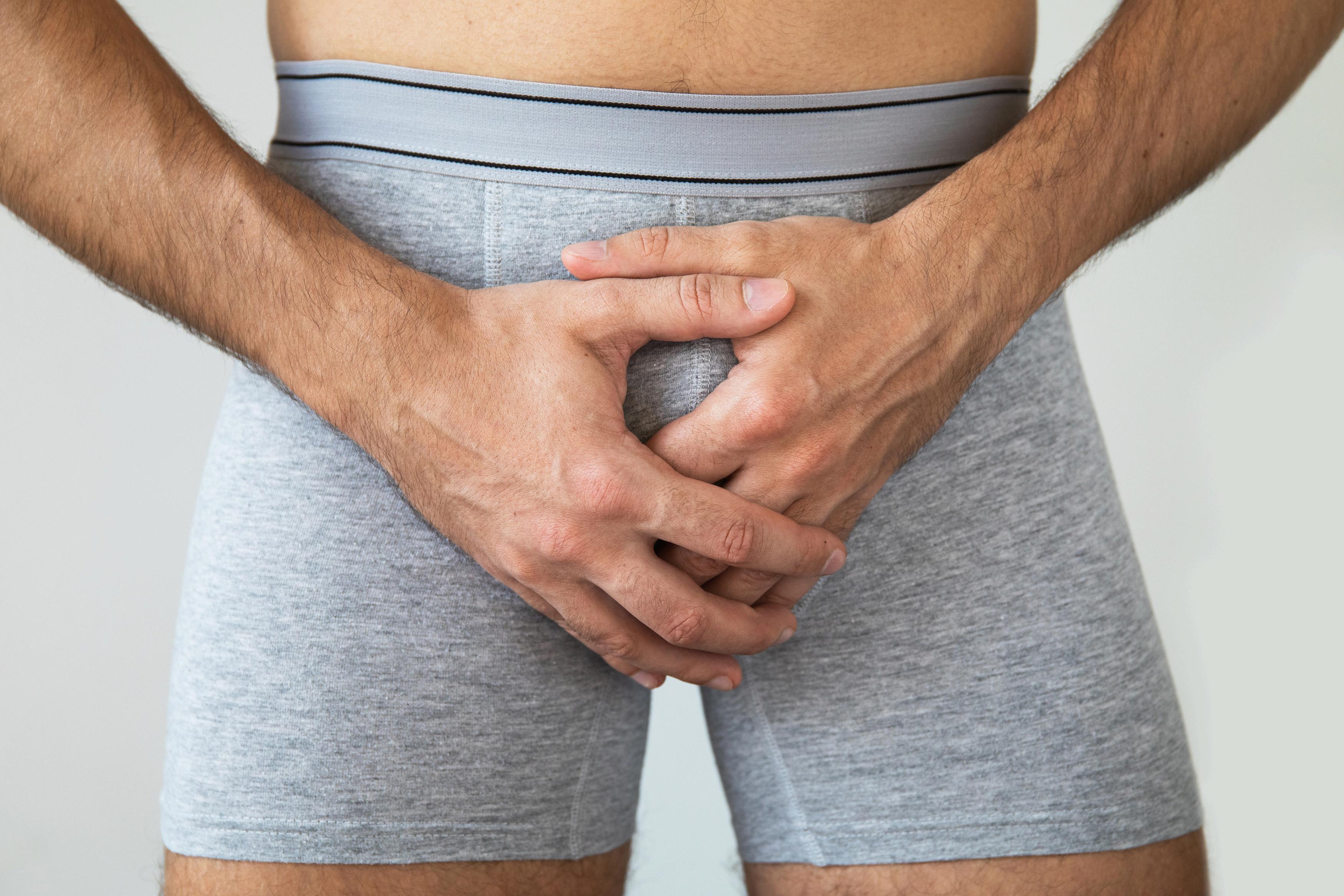
ProsChooseDAN TrustedWhenItMattersMost

Stephen Frink, Underwater Photographer President, Waterhouse Tours, Publisher, Alert Diver® Magazine, explains why he chooses DAN.
Dive Safety Alert Diver DIVERS ALERT NETWORK
W A T C H V I D E O

MELISSA IIARDO
RESEARCH PROFILE
STUDYING THE GENETICS AND PHYSIOLOGY OF INDIGENOUS FREEDIVING POPULATIONS
TEXT BY MADELINE COOMBS AND FRAUKE TILLMANS, PHD
Melissa Ilardo, PhD, is passionate about working in the distinct field of genetic analyses on individuals, primarily in Indigenous populations who have adapted to unique lifestyles or environments.
After finishing her undergraduate degree in 2011 and completing a master’s program at the NASA Astrobiology Institute at the University of Hawai‘i, she purchased a oneway ticket to India in 2013 to volunteer at a school while figuring out what she wanted to do for her doctorate There she met her PhD supervisor, Eske Willerslev, a champion of ethical engagement of Indigenous populations in research
Ilardo started her PhD in evolutionary genomics at the University of Copenhagen, Denmark, in late 2014 and graduated in 2018 She completed two simultaneous two-anda-half-year postdoctoral programs: One was at the University of California, Berkeley, with supervisor Rasmus Nielsen, PhD, who mentored her through her studies with the Bajau population in Indonesia; the other was
with Betty Leibold, PhD, in the University of Utah’s haematology department.
After spending the pandemic years working for genetics-based drug discovery startups, Ilardo wanted to return to research and an academic career at the University of Utah, where she is now an assistant professor in the biomedical informatics department.
What drew you to your field?
I was doing theoretical evolutionary biology at the NASA Astrobiology Institute, working on the origin of life and evolutionary biology, which is very abstract, theoretical, and computational I wanted to study evolution but connect it more to interacting with people
I joined a PhD program with Eske Willerslev, a renowned professor in Denmark who was the first to sequence an ancient human genome For the start of my PhD, I worked with 8,000-year-old human samples from Siberia on an ancient DNA project, which I really enjoyed
ILARDO, WITH COMMUNITY MEMBERS FROM THE BAJAU VILLAGE | ILARDO, WITH COMMUNITY MEMBERS FROM THE BAJAU VILLAGE | © PETER DAAMGAARD © PETER DAAMGAARD

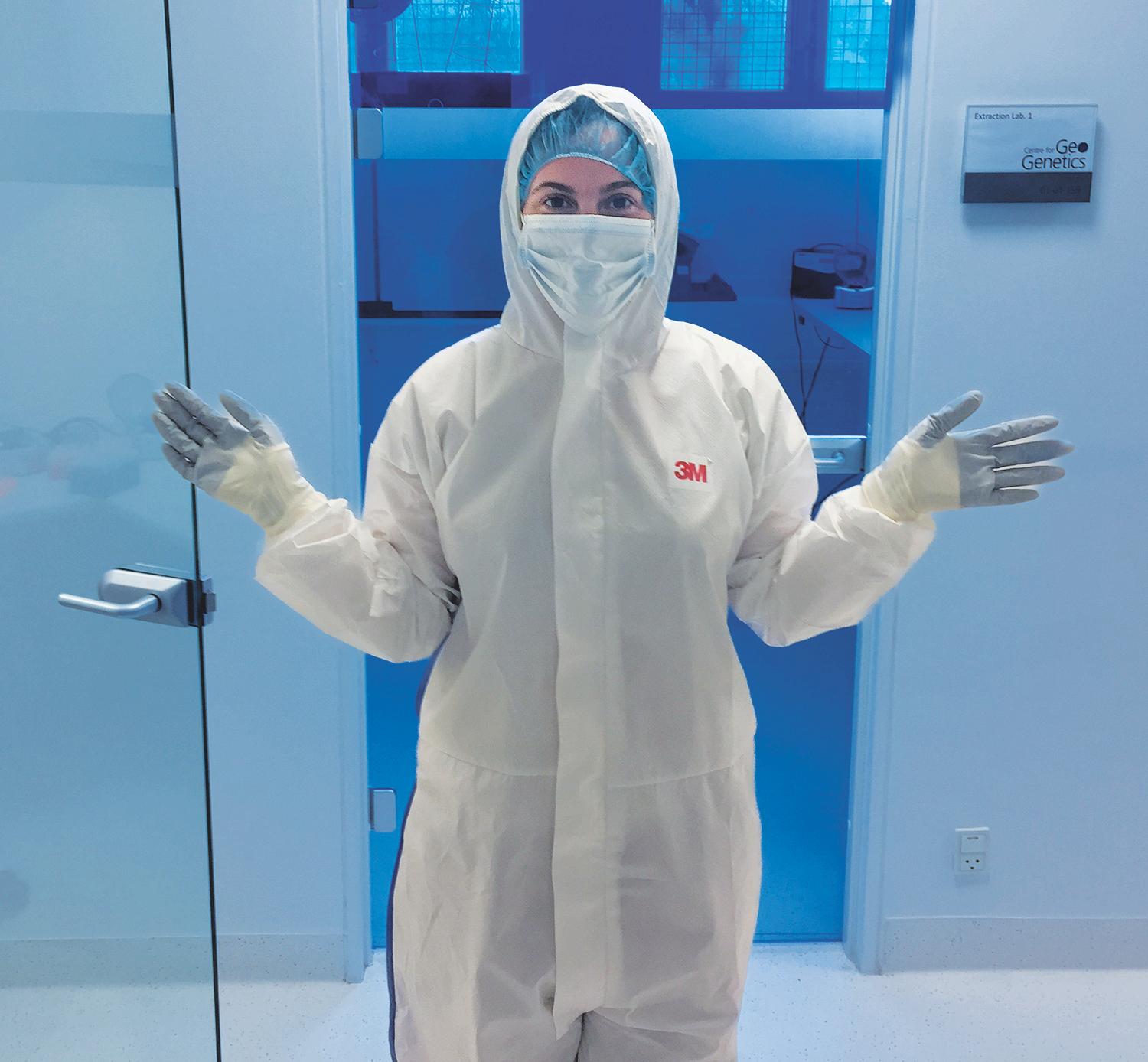 ILARDO PREPARES TO WORK WITH ANCIENT DNA IN THE CLEAN LAB FACILITIES AT THE
ILARDO PREPARES TO WORK WITH ANCIENT DNA IN THE CLEAN LAB FACILITIES AT THE
UNIVERSITY OF
| UNIVERSITY OF COPENHAGEN’S CENTER FOR GEOGENETICS |
ILARDO PREPARES TO WORK WITH ANCIENT DNA IN THE CLEAN LAB FACILITIES AT THE
COPENHAGEN’S CENTER FOR GEOGENETICS
© HUGH MCCOLL © HUGH MCCOLL
A BAJAU SEA NOMAD WITH HIS TRADITIONAL HOUSEBOAT |
A BAJAU SEA NOMAD WITH HIS TRADITIONAL HOUSEBOAT | © STEPHEN FRINK © STEPHEN FRINK
You are an avid and well-traveled diver. How did you get into the sport, and what is your favourite place to dive?
My dad has been diving since it was available to the public, so we would frequently fly to the Caribbean from our home in North Carolina I loved the water, so I got my dive certification as soon as I was old enough and got approval from my mom
My favourite dive site is hard to choose We often went to Grand Cayman when I was little, so it has a special place in my heart But the best site was near Komodo in Indonesia
How did you find your nichee area of research working with freediving Indigenous populations?
I was working on my PhD when a co-worker was preparing for a research trip to Thailand for a coral genomics project and mentioned that she might need a diver. That sounded like a once-in-a-lifetime opportunity, and I immediately volunteered to go.
While in Thailand, I heard about a community called the Moken. They are sea nomads, which means they get almost everything they need from the sea. They have had a history of subsistence diving for probably thousands of years I started reading and investigating what others had done and realised that no one had looked at the genetics of the Moken or other similar Indigenous populations
I pitched the idea to my PhD supervisor, who reached out to Rasmus Nielsen, who is renowned in the adaptation community and later supervised one of my postdocs He said it might be possible to look at adaptation in this population, but it was a long shot, meaning I would be betting my PhD on it I did not hesitate and said, “OK, I’ll do that”
Have Indigenous populations resisted participating in your studies?
There’s a bit of a misunderstanding among scientists that Indigenous communities don’t want to participate in research In my experience, Indigenous communities very much want to participate, especially because they might otherwise miss out on the benefits of that research They just want it done a certain way
I have not encountered any resistance in the communities I’ve worked with, but I’ve also gone into it without expectations and open to conversations If a community had said, “No, we’re not interested,” that would have ended that discussion It is about addressing their concerns, so among the questions I usually ask are, “What is important to you?”
“If we were to partner in a study, what would you want to know?” “What are your concerns about being involved in research?”
“Is this something you are interested in?” The answer to the last one is usually yes.
Another issue is how to explain the study. Informed consent forms have a lot of language about what participants will do, what researchers will measure, and what participants can expect. It is important to make that information as accessible as possible If you are speaking to someone who has never heard of DNA or the word genome, how do you make sure they understand what that means before agreeing to give their DNA? They need to know the implications, what you could do with the samples, and how you will protect their data
I spent a long time in the community doing workshops and lectures to make sure they understood what DNA is, what inheritance means, what could go wrong, and what happens when they spit in a tube and hand it to me

PERFORMS A SPLEEN SIZE ULTRASOUND ON A BAJAU DIVER IN HIS HOME | ILARDO PERFORMS A SPLEEN SIZE ULTRASOUND ON A BAJAU DIVER IN HIS HOME | ©

A LONE DIVER LEAVES THE VILLAGE IN HIS DUGOUT CANOE | A LONE DIVER LEAVES THE VILLAGE IN HIS DUGOUT CANOE | © MELISSA LLARDO © MELISSA LLARDO
ILARDO
PETER DAAMGAARD © PETER DAAMGAARD
Have any genetic differences been found between sea nomads and other populations?
Our study on the Bajau population in Indonesia found that their spleens are larger than those in surrounding populations When you hold your breath and submerge your face in water, several things happen One is spleen contraction, which researchers have observed in seals and humans
We know this spleen contraction increases the amount of circulating red blood cells Since red blood cells carry oxygen, more oxygen is available following splenic contraction, which may prolong dive time We were able to link that to a genetic variant that seems to increase thyroid hormone levels, which then increase spleen size
We do not know the exact cause and effect, however, and there may be some other mechanism involved that has increased
spleen size as a side effect of the variant The variant may also increase red blood cells, but that has not been tested
What would you like to see in your field in the future?
I would love to see more people from Indigenous communities involved in the research There’s a lot of room to build capacity in these communities, which would enable them to perform this research themselves, so it is no longer white European researchers like me working on Indigenous genomes A great example of work done in this area is at the Australian National University’s National Centre for Indigenous Genomics, a community-led centre with Aboriginal researchers
Scientifically, though, many communities have been overlooked in the past, which is detrimental to health research I would like to see more of these communities celebrated for what makes them so extraordinary.

MELISSA ILARDO STUDIED THE BAJAU POPULATION IN INDONESIA AS ONE OF HER POSTDOC PROGRAMS | MELISSA ILARDO STUDIED THE BAJAU POPULATION IN INDONESIA AS ONE OF HER POSTDOC PROGRAMS | © CORY PARRIS © CORY PARRIS



COVER THROUGH DAN WWW.DANSA.ORG LIFESAVINGBENEFITS-24/7EMERGENCYHOTLINE-ACCESSTODIVE MEDICALEXPERTS-DIVINGRESOURCESTOKEEPYOUSAFE Yourgatewaytodivesafetyservices&worldwidedive coverageatlowannualrates!

SAFETY DRILL, INCLUDING WHAT TO DO IN CASE OF FIRE OR ABANDONING SHIP, A SAFETY DRILL, INCLUDING WHAT TO DO IN CASE OF FIRE OR ABANDONING SHIP, SHOULD OCCUR AT THE BEGINNING OF EVERY CRUISE | SHOULD OCCUR AT THE BEGINNING OF EVERY CRUISE | ©
LEARNING FROM THE CONCEPTION
RISK MITIGATION
PREPAREDNESS FOR LIVEABOARD OPERATORS AND DIVERS
On Sept. 2, 2019, the small passenger vessel Conception burned to the waterline off Santa Cruz Island, California, killing 34 people. This wasn’t the first liveaboard fire, but the fearful reactions to this deadly tragedy echoed throughout the scuba industry. Liveaboard fires that have occurred since this incident have further fueled industry concerns.
Investigations following the Conception tragedy revealed several factors that likely contributed to the fire and the substantial number of fatalities, leading to an updated Code of Federal Regulations (CFR) and new fire safety rules from the US Coast Guard (USCG) to help liveaboard operators and divers be better prepared for a fire or evacuation
FINDINGS FROM CONCEPTION
The National Transportation Safety Board (NTSB) published a detailed review of the Conception incident in their Marine Accident Report (NTSB/MAR-20/03), which identified several causes for the severe loss of life
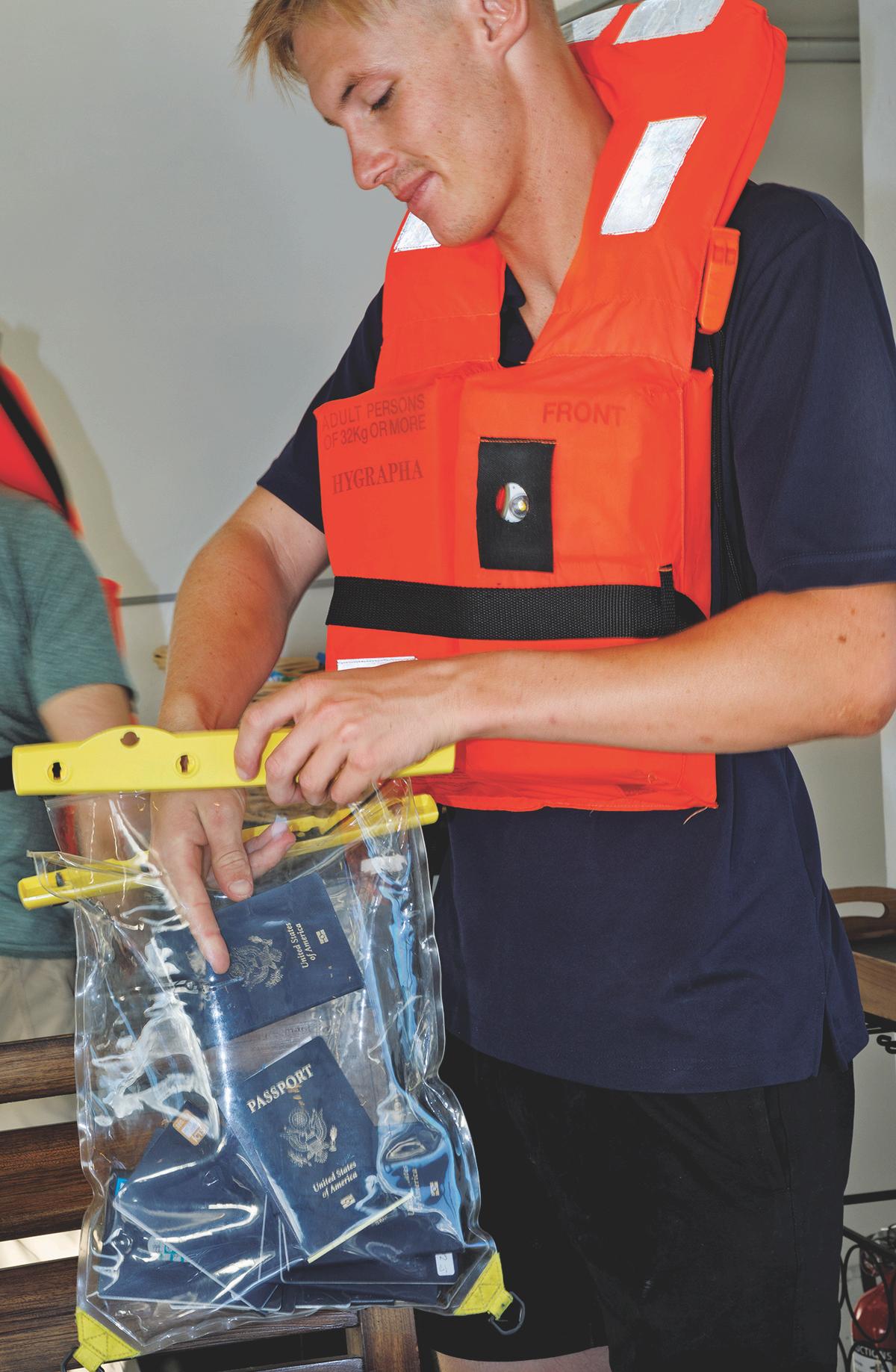
KEEP YOUR PASSPORT, INDISPENSABLE KEEP YOUR PASSPORT, INDISPENSABLE MEDICINES, AND VALUABLES IN A MEDICINES, AND VALUABLES IN A WATERPROOF GO BAG | WATERPROOF GO BAG | © STEPHEN FRINK © STEPHEN FRINK
A
TEXT BY JOANN HAACK, MSE, AND FRANCOIS BURMAN, PR ENG, MSC | PHOTOS BY STEPHEN FRINK
STEPHEN FRINK © STEPHEN FRINK
Investigators believe the fire started in the salon directly above the bunkroom where people were sleeping Both exits from the below-deck bunkroom led up to the salon
The bunkroom’s fire alarms would not have activated until the fire was well-developed, so both means of escape were likely inaccessible before the alarms awakened anyone
Fire detection: Only the bunkroom, as the only overnight accommodation space, was required to have smoke detectors
Means of escape: The two means of escape from the bunkroom both exited into the salon
Lack of roving patrol: No crew member was awake or patrolling when the accident occurred
Safe handling operations: The likely source of ignition was the battery charging stations in the salon, although a confidential report by the Bureau of Alcohol, Tobacco, Firearms and Explosives allegedly suggests the fire started in a plastic trash can in the salon.
Ineffective company oversight: Reports indicate a lack of crew training and emergency drills and procedures.
GUIDANCE FOR DIVERS
Lessons learned from the Conception and other dive boat fires can help guide actions you can take to ensure your own safety
Understand your means of escape
Make sure that the crew briefs you about how to exit living spaces There should be at least two unobstructed ways to get out While the crew may discuss the location of emergency exits, these exits are often not obvious or can be confusing to operate Go to the exits and, if allowed, open them to ensure they are working properly
Remember, fires produce black smoke and darkness
Follow the dive boat operator’s rechargeable battery protocols
Many boats have implemented new rules for where to charge batteries, so always learn and follow them
Bring your own chargers from the original equipment manufacturer
Before you leave home, ask about the boat’s power supply, including voltage, power/current, and frequency
Ask about the crew’s overnight fire watch protocols and observe the personnel in action
Take drills seriously and offer to help the crew perform them All vessels are required to conduct emergency drills, including fire, person overboard, missing diver, or abandon ship The crew may ask you to perform some basic functions to familiarise yourself with emergency gear
Check the location of life preservers and learn how to put them on Locate the fire extinguishers in the living areas of the boat.
If the operator does not perform a fire drill or at least a walk-around and briefing, be sure to ask about it.
Consider bringing a portable, economical carbon monoxide monitor for added assurance when your cabin is below deck. This device can also test suspect cylinder breathing gas
Keep the following items close to your pillow and ready to grab in an emergency:
waterproof flashlight
a “go bag,” which is a drybag no larger than 2 litres (so as not to impede your exit) containing your passport, daily medications, credit cards, phone, glasses, and any other important items fume (smoke) hood
In some cases, the boat operator may instruct you to leave everything behind, so check with them at the start of your trip

WHEN ON A LIVEABOARD, FAMILIARISE YOURSELF WITH THE
WHEN ON A LIVEABOARD, FAMILIARISE YOURSELF WITH THE SAFE EXITS FROM BELOW DECKS | SAFE EXITS FROM BELOW DECKS | © STEPHEN FRINK © STEPHEN FRINK
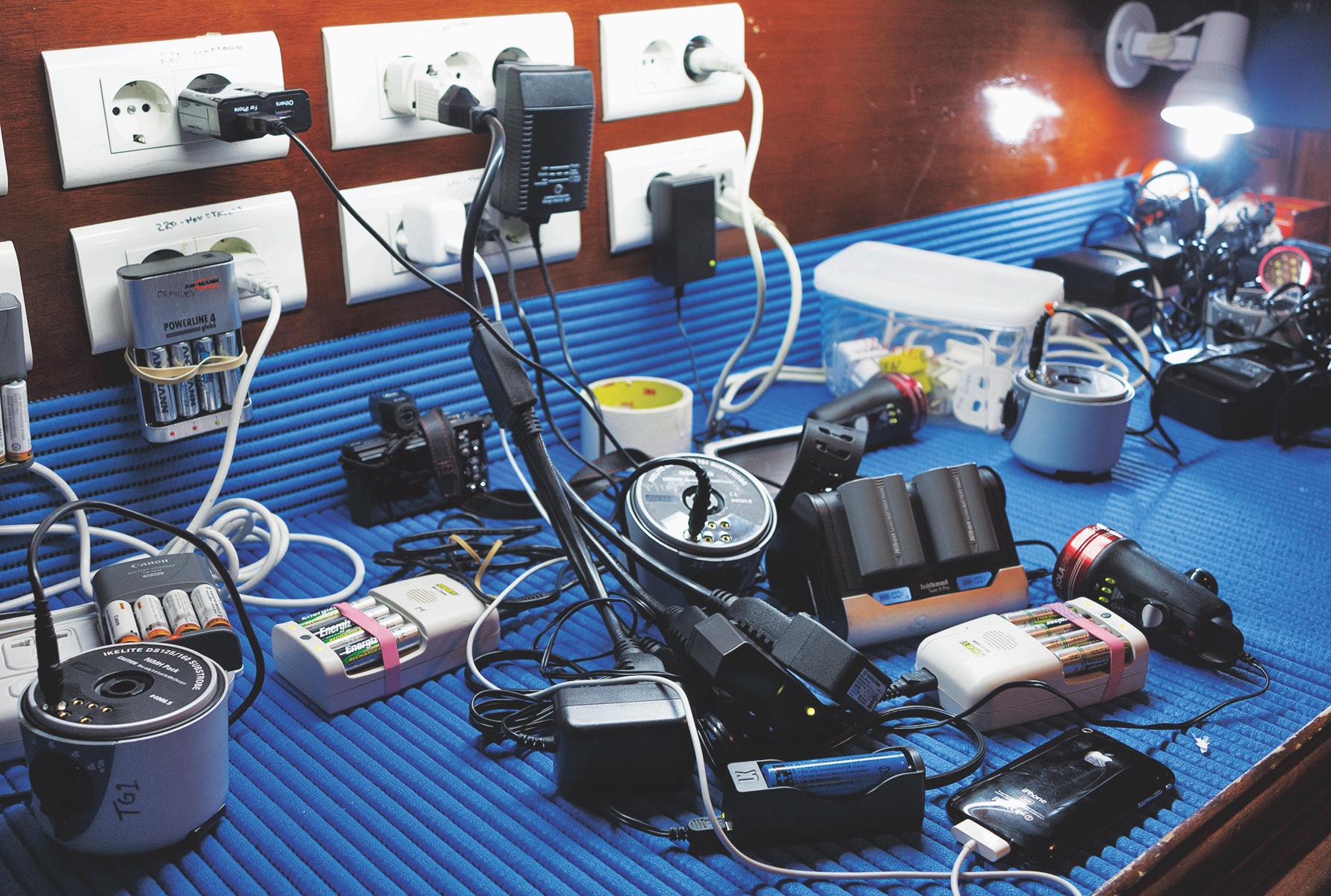
CHARGING STATIONS CAN BE A SERIOUS POTENTIAL HAZARD IF LEFT UNMONITORED. MOST CHARGING STATIONS CAN BE A SERIOUS POTENTIAL HAZARD IF LEFT UNMONITORED. MOST BOATS PROHIBIT CHARGING LITHIUM BATTERIES IN GUEST CABINS | BOATS PROHIBIT CHARGING LITHIUM BATTERIES IN GUEST CABINS | © STEPHEN FRINK © STEPHEN FRINK
GUIDANCE FOR LIVEABOARD OPERATORS
The NTSB Marine Accident Report of the Conception fire offered several recommendations that the USCG adopted as an interim rule (USCG-2021-0306) in December 2021 and that were later incorporated into the CFR (46 CFR: Chapter 1: Subchapters K and T)
Reading and understanding the CFR can be cumbersome The following summary can help operators understand the CFR changes, to whom they apply, and the deadlines for implementation, which were staggered because some changes were more extensive to fulfill
Implementation by March 28, 2022
Conduct passenger emergency egress drills
Post a passenger safety bill (including egress plans) in all accommodation spaces.
Develop handling procedures for the safe operation and storage of potentially hazardous items such as rechargeable batteries.
Develop and run crew firefighting and emergency egress drills.
Submit a plan for the installation of monitoring devices to ensure the wakefulness of the roving patrol The USCG will work with the operator to determine a reasonable implementation schedule
Implementation by Dec 27, 2022
Install interconnected fire detection systems in all spaces where passengers and crew have routine access
Implementation by Dec 27, 2023
Provide two unobstructed means of escape that are not located directly above or dependent on a berth The means of escape must be independent such that one incident will not block both exits
Prior to these CFR changes, the USCG had last implemented relevant safety regulations, including requirements for portable fire extinguishers, in March 1996, and they were applicable only to newly constructed vessels. Regulations from 1996 and those from 2021 now apply to all small passenger vessels that either operate on U.S. coastal or ocean routes or have overnight accommodations for passengers, irrespective of build date.
USCG regulations apply only to U.S.-registered vessels and those operating in U.S. territorial waters. All vessel operators, however, can refer to these regulations to avoid tragic incidents. We can make diving safer by learning the lessons from history.

ProsChooseDAN TrustedWhenItMattersMost

Richie Kohler, Professional diver, shipwreck researcher, and film-maker, explains why he chooses DAN.
DIVERS ALERT NETWORK
W A T C H V I D E O Dive Safety Alert Diver

BOATLADDERSAFETY
RISK MITIGATION
TEXT BY GUY THOMAS | PHOTOS BY MARCELLO DI FRANCESCO
Most divers who have dived from boats know that before they enter the water, they need to check that nobody is below them Also, while using a ladder to climb back on board after the dive, they make sure that nobody is below them if they should fall.
Divers are reminded frequently about these two safety precautions as part of the dive briefing. During the briefing, you should be told which pieces of equipment to remove prior to climbing back on board; this can differ from dive boat to dive boat and location to location. Not all ladders nor dive conditions are the same everywhere You may find, for example, that H-ladders require you to remove your fins, while T-ladders, which are much more common and userfriendly, allow you to keep your fins on
What is less known amongst divers and rarely mentioned during briefings is how to avoid hand/finger injuries when climbing the boat ladder Sea conditions may make climbing up ladders more difficult, and although some boats have fixed boat
ladders, most of the time, divers will have to deal with moving foldable ladders
This type of ladder need not be a problem if you know how they work First, be aware that these ladders are usually attached to the boat by a hinge. This allows the ladder to move up and down with the swell. Many of these hinges cannot be locked, so the ladder will move with or without a diver on the ladder. Think of the ladder as a ‘nutcracker’. Imagine one handle of the nutcracker being fixed, while you push on the other handle. The nut will crack open without having to apply much force The boat ladder works in the same way
One “handle” is the boat, the other is the ladder When the ladder goes upwards (your legs go backwards when standing on the ladder) in effect opening the nutcracker But when the ladder goes downwards again, you don’t want your hands or fingers caught between the two moving parts Should this happen, you will not be able to release the pressure as all your weight is on
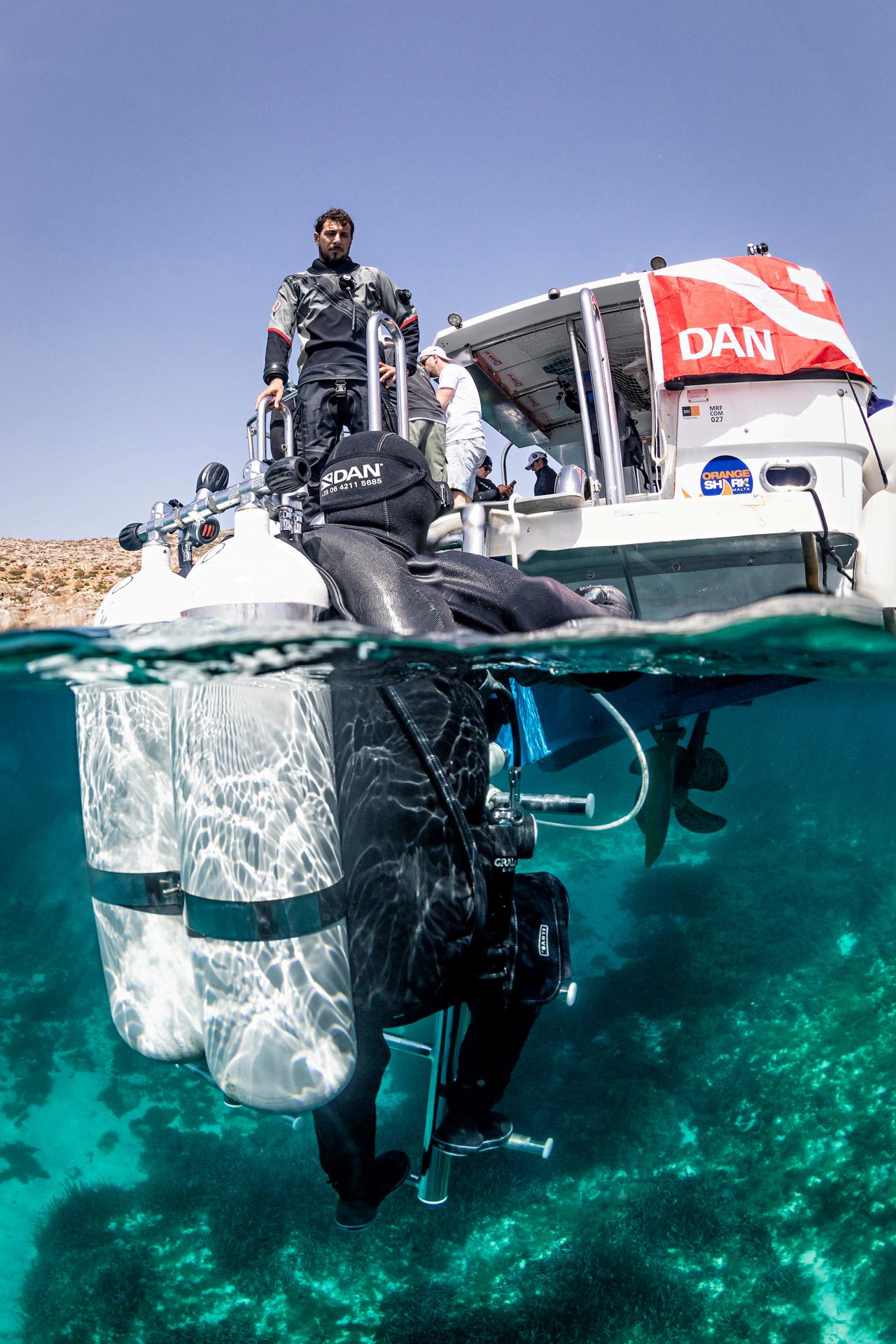
the ladder, and consequently, you will end up with crushed or lacerated hands or fingers perhaps even an amputation! The same applies to any other moving parts of ladders These injuries can be avoided: just look carefully where you place your hands Sometimes it is easier said than done, as the swell might make climbing on board challenging, and you might not pay much attention to where your hands are placed Ladder design can mitigate the risk of hand and finger injuries, and dive centres are encouraged to do a thorough risk assessment and ensure their ladders are as safe as possible
Finally, a word on head injuries It rarely happens, but just be aware that when there is a large swell, the ladder will rise up pretty far and will then crash into the water on the down swell Make sure you are not under the ladder at that moment This can also be challenging where strong undercurrents push you towards the ladder Though you might think it will make it easier to grab onto, never surface too close to the ladder it could ruin your whole day
ABOUT THE AUTHOR
Guy Thomas is an expert Diving and First Aid Instructor Trainer and works fulltime as Director of Safety Programs at DAN Europe, where he is responsible for developing and implementing the DAN Europe Safety Initiatives He is also a member of the Special Rescue Team of the Italian Red Cross He operates as a Helicopter Rescue Swimmer/Diver Medic onboard a SAR helicopter of the Italian State Police.


G R E A T W H I T E S H A R K
Great White Shark South Australia’s Adventures
TextByStephenFrink
Great white sharks are capricious fish They are iconic, impressive, photogenic, and awe-inspiring but also frustrating. That frustration is not all about the animal part of it is how few places in the world you can go to see them.
Divers used to visit Guadalupe Island, off the coast of Baja California, Mexico, but the Mexican government closed the area to shark-related tourism activities in January 2023. Some people speculate the ban is due to overzealous producers seeking ever-more salacious encounters, while others suggest the background motivation was something more nefarious. No matter the reason, Guadalupe is no longer an option for Carcharodon carcharias encounters
South Africa likewise used to be a great white shark destination. Consistent populations of great white sharks were off Gansbaai and False Bay, drawn there by the extensive seal colonies that provided ample food A fleet of shark adventure outfitters evolved to deliver tourists for in-water cage opportunities and the spectacular breaches that defined the Air Jaws documentaries But great whites are not the apex predators when orcas are around. On a single day, three shark carcasses washed up on shore with only their livers ripped out, an alarm that signalled the demise of the enclave due to orca attacks.
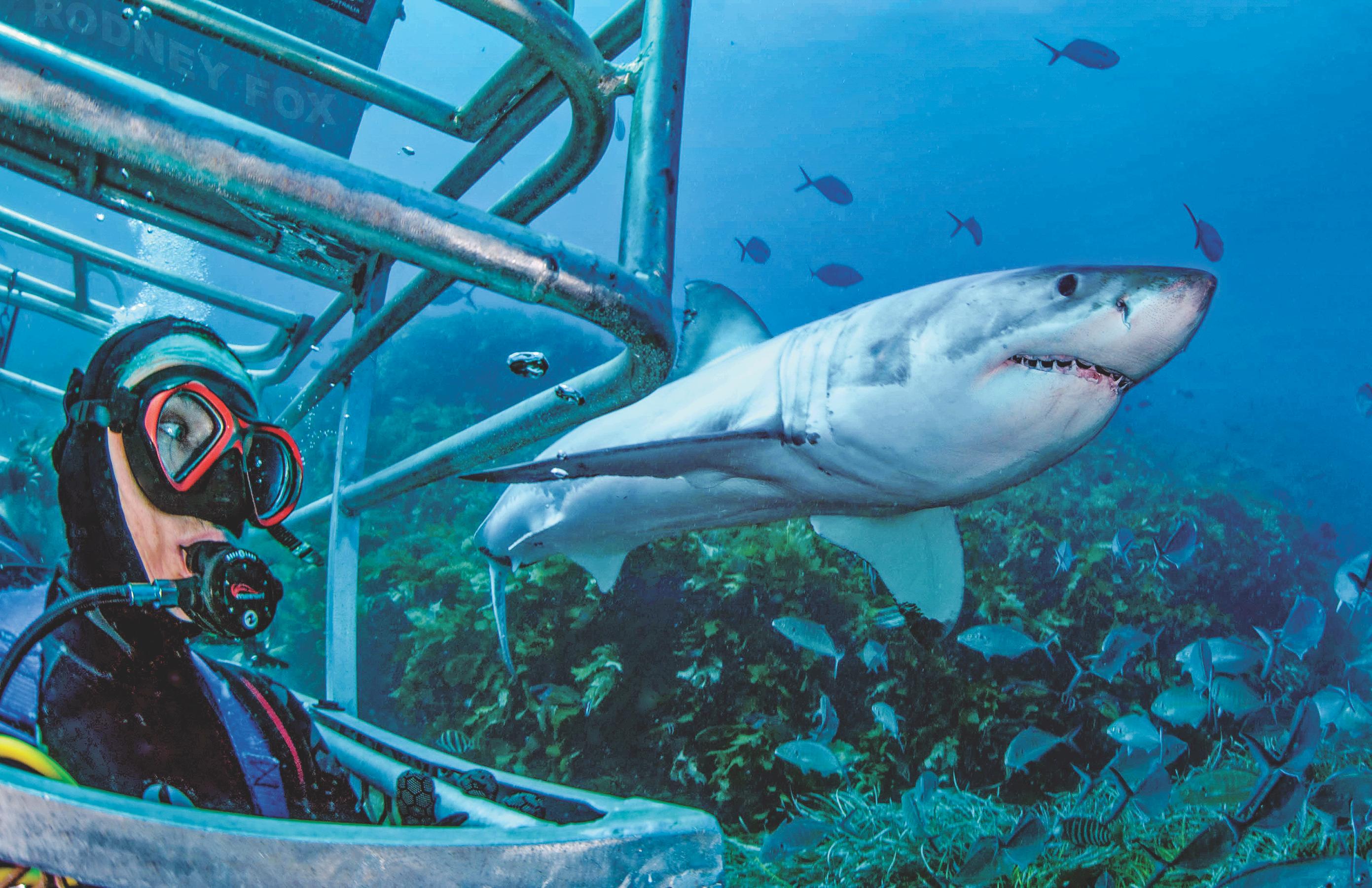
THE
SEAFLOOR IN APPROXIMATELY 70 FEET (21.3 METERS) OF WATER, PROVIDING LOWERED TO THE KELP-COVERED SEAFLOOR IN APPROXIMATELY 70 FEET (21.3 METERS) OF WATER, PROVIDING UNIQUE BACKGROUNDS AND PROXIMITY TO OTHER SUBTROPICAL FISH | UNIQUE BACKGROUNDS AND PROXIMITY TO OTHER SUBTROPICAL FISH |
Later research confirmed the sharks weren’t totally decimated but had shifted east to more hospitable places such as Algoa Bay and the KwaZulu-Natal coastline. While the sharks are there, like we know them to be off the northeastern U.S. and the Farallon Islands off California, you can’t consistently or predictably encounter them in any one place. In addition, there aren’t reliably favourable sea conditions or regulations supportive of in-water viewing operations
That leaves South Australia as the last shark standing in terms of a destination for great white shark cage diving but it is not a slam dunk I’ve made the trek seven times now, including a couple of trips back in the slide film era, and have had productive encounters on five On my most recent trip in October 2023, we had shark encounters from the moment we arrived in the Neptune Islands until we left five days later
The best shot I got from that trip maybe from any trip was on the final bait toss The captain said we had to pull anchor and
head back to port, but we could have another chance. As I sat on the swim platform with my shark wrangler and my topside camera at water level, prefocused on where I hoped the shark might emerge, I pondered the rare privilege of being in the presence of these majestic predators again.
When the shark popped up in precisely the right place, my camera’s rapid motor drive clicked away to nail the shot that now appears on the cover of this magazine The dopamine coursing through my brain at that moment guaranteed I would return for an eighth shark expedition
That’s how the trip ended, but it began with a long aeroplane ride from Miami, Florida, to Doha, Qatar, to Adelaide, Australia, and then to Port Lincoln, South Australia The time and expense required for a South Australia great white shark expedition is a dealbreaker for many travellers from North America, but for those who go, there are two options for operators licensed for cage diving activities within the Neptune Islands
A GREAT WHITE SHARK SWIMS NEAR THE SUBSURFACE CAGE DEPLOYED FROM MV RODNEY FOX. THE CAGE IS
A GREAT WHITE SHARK SWIMS NEAR THE SUBSURFACE CAGE DEPLOYED FROM MV RODNEY FOX. THE CAGE IS LOWERED TO
KELP-COVERED
© ANDREW FOX © ANDREW FOX

Conservation Park: The liveaboard MV Rodney Fox books multiday expeditions, and Calypso Star Charters does day trips.
The Neptune Islands are two island groups the North Neptune Islands and South Neptune Islands in the Great Australian Bight, a large, open oceanic bay off Australia’s southern coast. Given the distance and vagaries of the sea, the trip requires big, stable, seaworthy boats to make the trip, even though there are protected anchorages once you get there It is a three-hour run between Port Lincoln and the Neptune Islands, so be aware that six hours of day excursions will be spent in transit rather than cage diving
AUSTRALIAN SEA LIONS
A great differentiator for South Australia shark adventures is that there is more to seeing than sharks Most tours can include a visit to Hopkins or Grindal Island to see Australian sea lions (Neophoca cinerea) They are one of the most charismatic and rarest pinnipeds, with an estimated population of 10,000 to 12,000 worldwide
We visited twice, arriving in the morning on our way to the Neptune Islands and then in the afternoon on our return to the mainland. The morning encounter was amazing we kept our distance according to the regulations, but the sea lions eagerly swam right up to us. By the afternoon, they were warm and cosy on the beach and totally indifferent to our presence.
As we dropped anchor from our small tender that morning, the sea lions immediately swam out to greet us, doing barrel rolls and spy hops, fully ready to engage with us in the water Close encounters were a given as they swam directly to our dome ports and zoomed around the kelp-covered seafloor in only 15 feet (46 meters) of water
The greatest challenge to this encounter is not proximity if the sea lions are in the water, they will get close but rather buoyancy issues You might be wearing a drysuit or more neoprene than you are used to, and you may be using rental dive gear since you don’t need your own buoyancy
THE FRIENDLY AND CHARISMATIC AUSTRALIAN SEA LIONS AT HOPKINS ISLAND ARE
THE FRIENDLY AND CHARISMATIC AUSTRALIAN SEA LIONS AT HOPKINS ISLAND ARE A HIGHLIGHT OF AN EXPEDITION TO THE NEPTUNE ISLANDS | A HIGHLIGHT OF AN EXPEDITION TO THE NEPTUNE ISLANDS | © STEPHEN FRINK © STEPHEN FRINK
compensator, regulator, or fins for cage diving Working out how much weight we needed cost some of us significant opportunities with the sea lions But if you get past the initial gear tweaks, it is a glorious experience You might not leave a productive day of shark diving to backtrack a couple of hours to dive with Australian sea lions, but as a splash on the way out during your first day, it is a South Australia must-do
GREAT WHITE SHARKS
After our time with the sea lions, we were ready for the main event: great white sharks Your boat will arrive at either North Neptune or South Neptune North Neptune is closer to Port Lincoln, the mainland hub for South Australia shark diving, so day trips typically go there, while liveaboards can visit either island group Our tour primarily concentrated on South Neptune, but we motored to North Neptune for one day midweek to avoid leaving any opportunity untested.
We had good luck at both places, but the legacy of consistently chumming the water at North Neptune has had the unintended consequence of attracting large schools of trevally jacks around the cages. It is challenging to compose a photo of a distant great white through a wall of highly reflective silver fish surrounding the cage
We retreated to South Neptune after a day of frustration and minimal significant photos We would have been happy to stay around the northern islands if only the sharks were there, which sometimes happens On this trip, we had better luck photographically at South Neptune, where I took all the photos for this article
A DAY IN THE LIFE OF A CAGE DIVER
The crew is busy with the task of attracting sharks from the moment the anchor sets A large tub of frozen, minced fish entrails (the chumsickle) goes into a tub on the dive platform As seawater constantly flows into the tub, the crew chips at the slowly
defrosting mass so the blood and bits of flesh create a slick that advertises our presence to any great whites in the area This activity continues in the background throughout the shark dive
A bit of tuna, usually the head and gills, is typically the main attractant The shark wrangler attaches it to a line, repeatedly throws it in the water, and then drags it back to the swim platform The bait is rigged with a biodegradable sisal line, so there is no possibility of harming a shark that gets the bait The goal is not to feed the shark but to attract it near the cage while ideally never impacting it The conservation park has clear rules of engagement, and the operators know their permits depend on compliance
The most relevant rules affecting cage divers are to not harm or deliberately feed the sharks, avoid leaving any fish-based attractant in the water unattended or disposing of it in the park, and stop any form of shark attraction for 15 minutes if a shark “bites, takes, or ingests any unminced fishbased attractant or makes forceful contact with the underwater enclosure, equipment, or vessel.”
The wranglers do their best not to allow the sharks to take the bait, although it does happen The sharks would become satiated or bored if they got the bait every time; if they never got it, they would give up Getting bait occasionally and randomly keeps them highly engaged
While the shark wranglers are perpetual motion machines on the back deck, shark inactivity might lull guests into torpor Just because we don’t see sharks on the surface doesn’t mean they aren’t there Great whites are stealth predators and often surprise everyone with a massive breach in pursuit of the bait The activity accelerates with the frenetic shout of “shark” from the stern Whoever has their scheduled turn in the cages needs to be in their wetsuits and ready with their cameras prepped for action
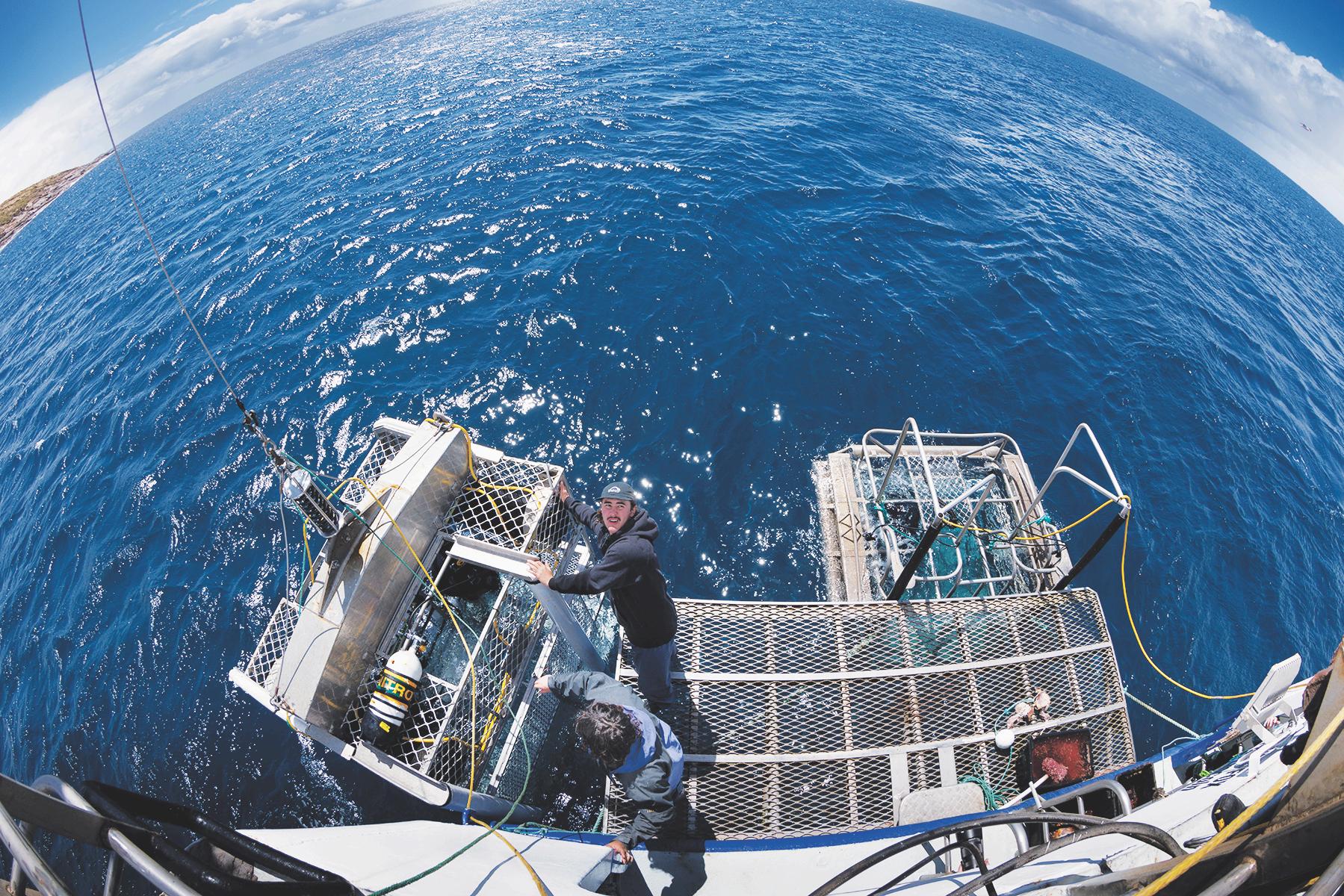
THE SURFACE CAGE IS TETHERED DIRECTLY TO THE REAR OF THE SWIM
THE SURFACE CAGE IS TETHERED DIRECTLY TO THE REAR OF THE SWIM PLATFORM, WHILE THE SUBSURFACE CAGE IS LOWERED VIA CABLE PLATFORM, WHILE THE SUBSURFACE CAGE IS LOWERED VIA CABLE AND WINCH TO THE SEAFLOOR | AND WINCH TO THE SEAFLOOR | © STEPHEN FRINK © STEPHEN FRINK
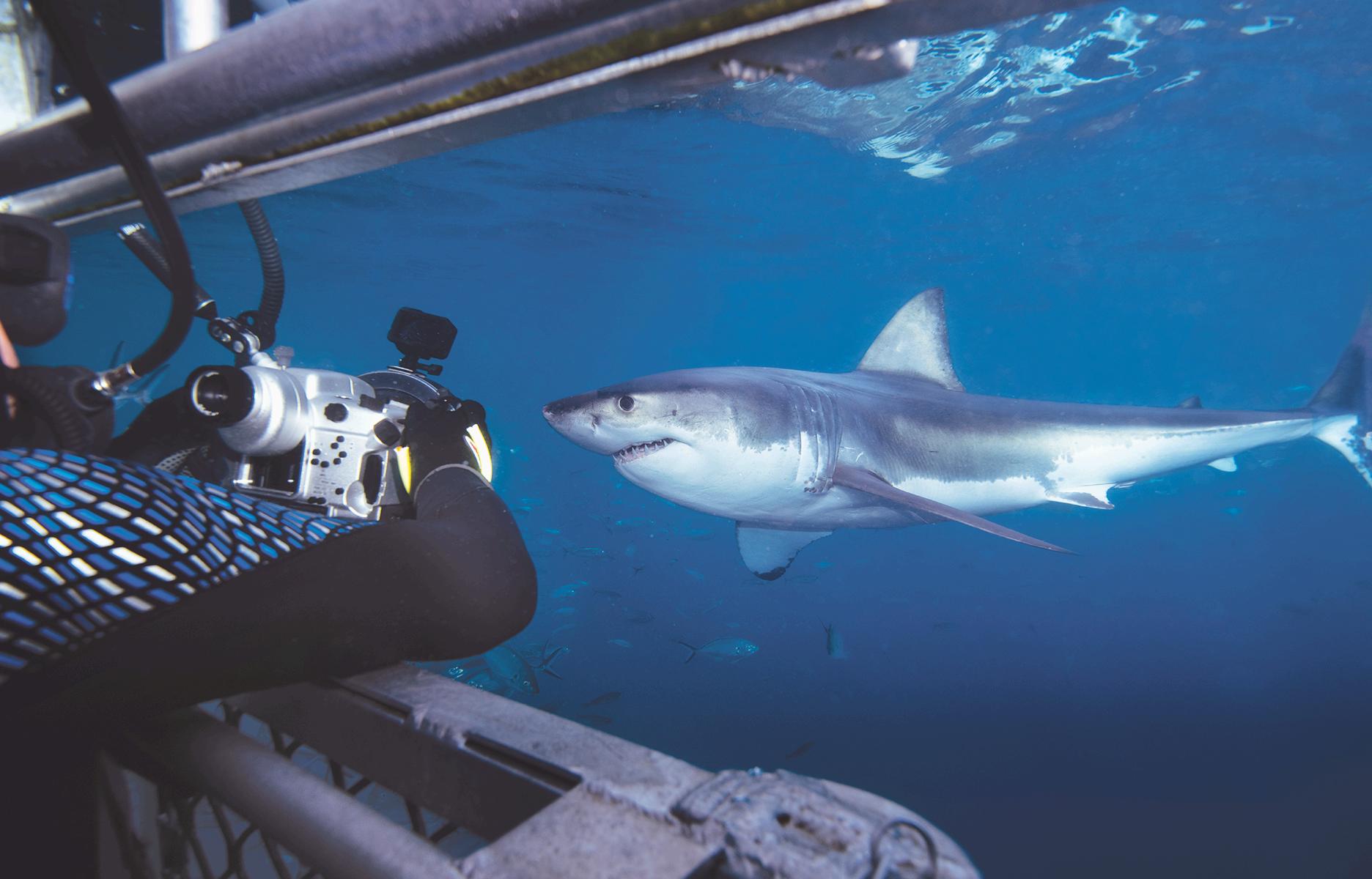 STEPHEN FRINK PLACES HIS HOUSED CAMERA WITHIN THE VIEWING SLOT OF THE SURFACE CAGE
STEPHEN FRINK PLACES HIS HOUSED CAMERA WITHIN THE VIEWING SLOT OF THE SURFACE CAGE
AS A GREAT WHITE SHARK SWIMS
| AS A GREAT WHITE SHARK SWIMS NEARBY | © JEFF SAMUEL/SUBSURFACE VETERANS © JEFF SAMUEL/SUBSURFACE VETERANS
STEPHEN FRINK PLACES HIS HOUSED CAMERA WITHIN THE VIEWING SLOT OF THE SURFACE CAGE
NEARBY
Our boat for this trip, the MV Rodney Fox, has two cages One is a surface cage tethered to the port stern, while a crane lowers the starboard submersible cage to the kelp-covered seafloor 70 feet (21 meters) below This dual-cage system can accommodate four to six cage divers at a time A long hose and regulator feed compressed air to the surface cage, so no scuba certification is necessary Submersible cage divers use traditional scuba tanks, BCs, and regulators, so they must be certified and comfortable diving a flat 70-foot profile, typically on air Nitrox tanks are available for an additional charge if divers book them in advance
A bin in the bottom cage contains bait The cage captain stomps it to smithereens, and the bait floats into the water column to attract sharks and other colourful subtropical seafloor inhabitants There isn’t a tethered bait to lure a shark near the cage, but the cage becomes an ecosystem of its own, and the sharks are often curious.
I didn’t have a super close encounter while in the submerged cage, but others in our group did. You need to invest a fair bit of time in the bottom cage to make your own luck. It is a more random experience than the surface cage, but South Australia is the only place in the world to experience being in a cage on the seafloor Even in Guadalupe, where most boats offered a subsurface cage, the water was so deep that the cage was still tethered amid the featureless blue The bays in South Australia are shallow enough to place the cage on the bottom, revealing a seagrass and kelp background and different marine life from what you would encounter at the surface
The surface cage was a happening place during our time at South Neptune With only nine cage divers we intentionally booked the charter at half capacity to maximise cage time and two cages, plus all the topside photography opportunities from the shark action at the surface, no one
suffered from shark deprivation We were lucky to have active sharks each day, but that isn’t always the reality
Every time I get amped up talking about stellar shark encounters, I recall the trips where the action was slow and even the ones where we were totally skunked These situations happen for various reasons A whale carcass in the Spencer Gulf might attract the great white sharks away from the Neptunes, or tuna fishing boats from Port Lincoln could entice them away from the islands with their large nets of live tuna towed behind them
The great whites are mostly there for the long-nosed fur seals that inhabit the craggy shorelines along the Neptune Islands, and the little bit of minced bait that occasionally washes into the sea along with some tuna gills from our throw lines isn’t going to sustain a 16-foot shark Yet, as long as they find it a good game, this remains one of the truly great adventures for any marine megafauna lover.
HOW TO DIVE IT
When to go: The Australian summer (North American winter) offers the warmest water and a good chance to see sharks. February to May is cooler, and August to October has the coldest water temperatures The highest recorded numbers of sharks per day in recent years peaked from September to November
Getting there: Port Lincoln is accessible through Adelaide via QantasLink and other regional carriers They fly smaller aircraft and have restrictions on your carry-on’s size and weight You’ll need to be creative with how you pack for South Australia: Two checked bags at 50 pounds each and a small handcarry at 15 pounds are their published limitations
Cage diving: You’ll need a good wetsuit (7 mm recommended) or drysuit for water in
the 60s°F (about 15°C to 20°C), plus booties, a hood, and gloves Bring a comfortable mask, but you don’t need a BC or fins unless you want your own gear for diving with the sea lions It’s a good idea to have a snorkel even if you don’t use it The surface cage uses surface-supplied air The bottom cage divers will use a conventional tank and scuba gear without fins You will need a dedicated dive computer for the submersion to 70 feet with a flat profile, and if you do it twice a day, monitor your bottom time and no-decompression limits
Hyperbaric treatment: While surface cage divers can’t get into bubble trouble, staying too long in the bottom cage can be a hazard The hyperbaric medicine unit at the Royal Adelaide Hospital is the South Australian state referral service for hyperbaric and dive medicine They offer a hyperbaric oxygen treatment facility with a state-of-the-art triple-lock recompression chamber that can treat up to 20 patients
across two compartments
Water clarity: Visibility is typically 60 to 100 feet (18 to 30 meters) The baiting process can create particulate matter from the chumming and the sharks biting through the attractant
Topside lens choice: The athleticism of these sharks will impress even the most ardent underwater photographer, and breaches are not unusual An 80-200mm zoom lens was a good focal length to capture the moments when teeth, eyes, and fins were above the water at the stern
Shark activity: A database of shark encounters by Calypso Star Charters from 2011 to the present is at tinyurlcom/calypsostar It can help you plan well in advance which months are best for shark encounters so you can try to avoid the dreaded shark drought during your South Australia great white shark adventure.
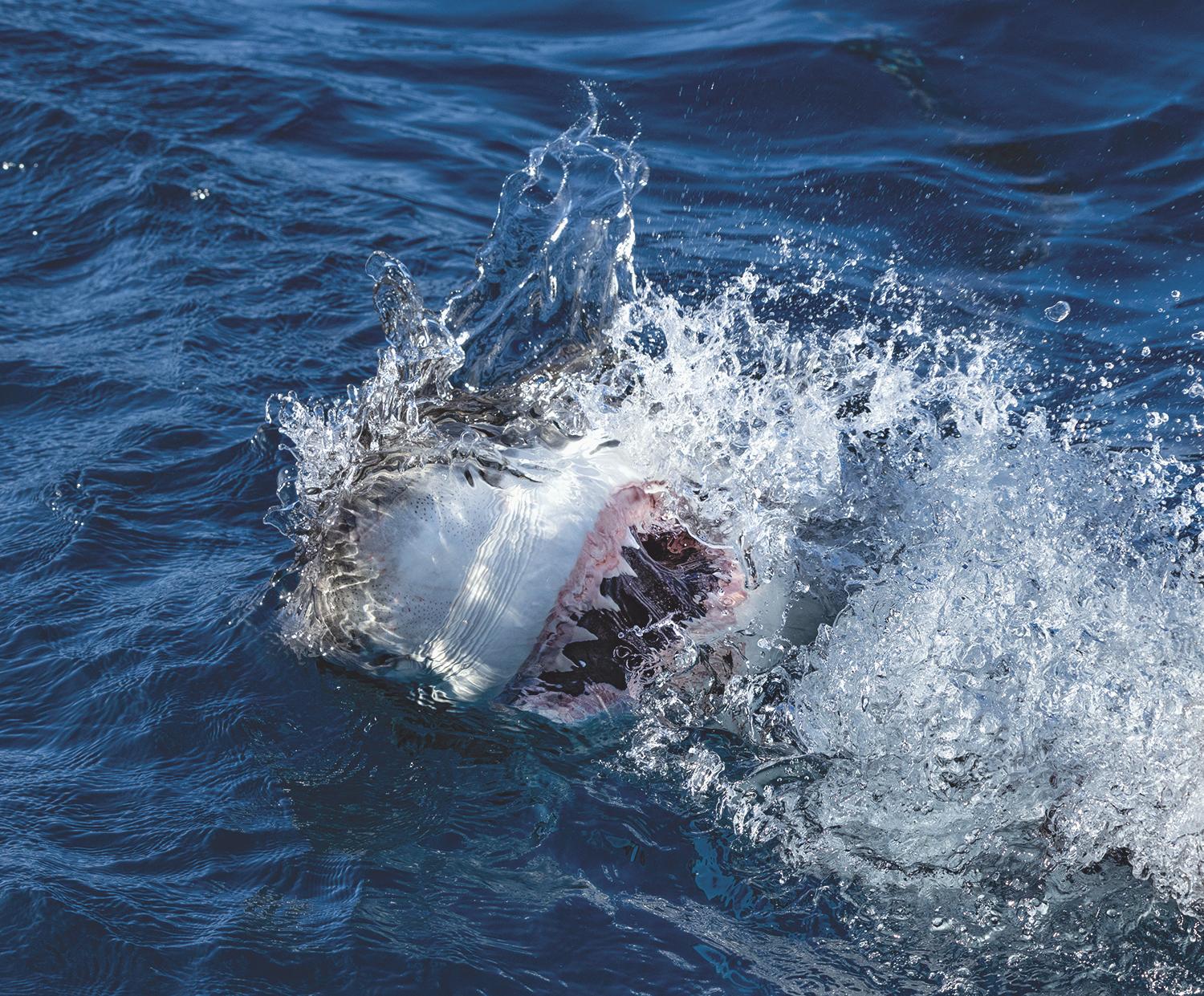
THERE ARE AMPLE TOPSIDE PHOTO OPPORTUNITIES WITH SHARKS THERE ARE AMPLE TOPSIDE PHOTO OPPORTUNITIES WITH SHARKS BREACHING AND SPY-HOPPING | BREACHING AND SPY-HOPPING | © STEPHEN FRINK © STEPHEN FRINK
ProsChooseDAN TrustedWhenItMattersMost

Michael Clarke, Group Director, Watersport & Marine Division, Sandals and Beaches Resorts, PADI® Course Director, explains why he chooses DAN
Dive Safety Alert Diver
DIVERS ALERT NETWORK
W A T C H V I D E O

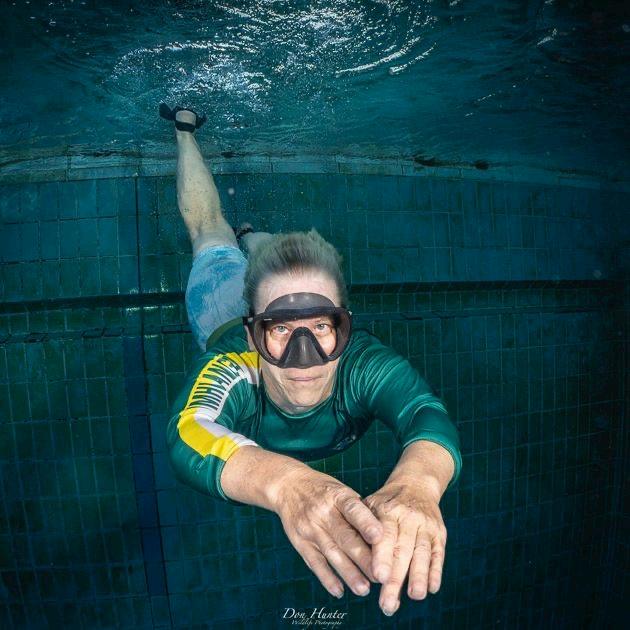
LINDANESS SPECIAL INTEREST
SOUTH AFRICAN PHOTOGRAPHER OF THE YEAR WINNER 2023
INTERVIEWEDBYTHEDIVEACTIONTEAM
Linda Ness has recently been awarded the title of South African Photographer of the Year 2023 She lives in Umhlanga and likes to focus on freediving and surf photography whilst using natural light With her breathtaking underwater photography, Linda’s mission is to promote a greater care and deeper knowledge of the ocean
PHOTO BY DON HUNTER OF LINDA NESS TRAINING PHOTO BY DON HUNTER OF LINDA NESS TRAINING
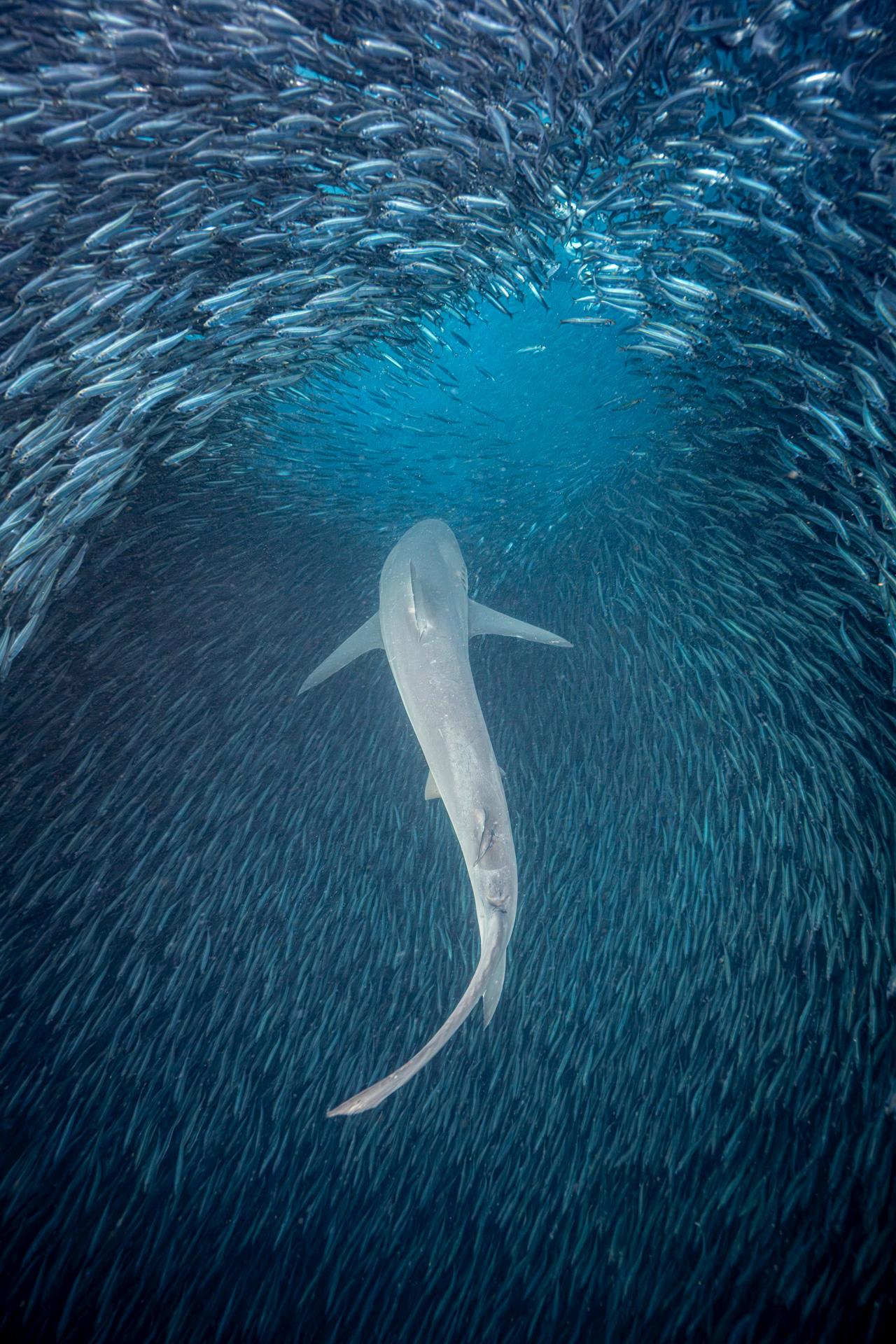
YEAR 2023 WINNING PHOTO
PHOTO BY LINDA NESS. SA PHOTOGRAPHER OF THE
SA
THE YEAR 2023 WINNING PHOTO AMATEUR WATER CLASS & OVERALL WINNER FOR ALL CLASSES AMATEUR WATER CLASS & OVERALL WINNER FOR ALL CLASSES
PHOTO BY LINDA NESS
PHOTOGRAPHER OF
Who is Linda Ness, and how did her underwater journey begin?
Linda first started scuba diving in 1984 in Sodwana, sparked by her love for the ocean while snorkelling as a child She has PADI Advanced Open Water and a RAID Deep 40 certification, in addition to being an avid freediver She trains with a group called the “Hurricane Squad” in Durban The group uses hypoxic swim drills to improve their breath hold This is of great benefit when Linda does her big wave surf photography, which she is passionate about
The first camera she owned was in varsity in Durban during the early 1980s She travelled the world with her camera, backpacking in the 1980s and 1990s to places like China
While white water kayaking, Linda became interested in water photography In those days, a camera housing was a simple box with an O-ring to help make the camera '’splashproof’! A favourite now is to freedive in the deep blue with pelagic marine life. The anticipation is a thrill and successfully capturing fast moving underwater action is a serious challenge.
Who is Linda inspired by?
Despite being highly technical and qualified as a structural engineer, Linda has laughed for a long time at the underwater photographers with their mass of camera equipment She used to call them “Strobiologists” with their protruding gadgets and huge lights Linda has preferred to keep it small and simple, rather using the ambient light available However, today she has ventured into the “Strobiologist” school of thought and uses INON Z330s, whilst doing wide angle shots with her Sony mirrorless camera
Warren Keelan, Brooke Pyke, Christa Funk, Helene Walne, and Don Hunter are some of
the people who inspire Linda She likes to rub shoulders with like-minded people and go where her underwater passion takes her In 2012, she travelled to the whale-rich waters of Tonga and did an underwater photography course with Craig Parry This was an incredible experience and deepened her love for the ocean
How does it feel to win the South African Photographer of The Year competition?
Linda was delighted to make it into the final process with four of her shark photos in the water section All photos come from her amazing Sardine Run in June 2023 with Steve Benjamin from Animal Ocean It was only in April 2024, when she found out that she was the overall winner of the competition It was a big shock!
Linda is particularly stoked that her winning photo is of a shark She believes that there is a lot of work to do to help demystify sharks. She remarks that there are so many land photos taken, but the sea is relatively unexplored, and there is little publicity given to its beauty. A prime problem, she says, is that many underwater photos are ‘lost’ and only seen on Facebook. She believes photos need to be shown on walls and printed in books to be enjoyed and shared more! Too much of marine photography is internalised and ring-fenced by others Come on folks dig them out!
In an effort to encourage public awareness and a greater appreciation for marine life, Linda has written a children’s book, The Extraordinary Adventures of Ramsamy the Sardine Check It out!
Linda’s advice to other budding photographers?
Linda‘s advice is, “Don’t overthink it!”


BY
FREEDIVING PHOTO BY DON HUNTER OF LINDA NESS FREEDIVING
PHOTO
DON HUNTER OF LINDA
NESS
PHOTO BY LINDA NESS SARDINE RUN 2023
PHOTO BY LINDA NESS SARDINE RUN 2023
She says you must simply enjoy the ocean and love photography to succeed in taking great photos “It takes hours and hours of water time Enjoy the journey!” Linda told us that "you have to wait for nature to lift it's curtain to get the shot" and to stay positive Also do not focus only on the outcome; "Hang around with people who are doing underwater photography and learn!" Lastly, Linda believes that watching animal behaviour is a key aspect and being able to predict where to be in the action is essential
What underwater camera system does Linda use?
A Sony A7RIV mirrorless camera with a Sony Vario-Tessar T* FE 16-35mm F4 ZA OSS lens in a Nauticam housing for underwater photography and an AquaTech housing for surf photography
Any future plans?
Linda’s next focus is to do a collaboration with other underwater photographers and host an exhibition with prints for sale, raising money for charities like The Litterboom Project and other worthy charities

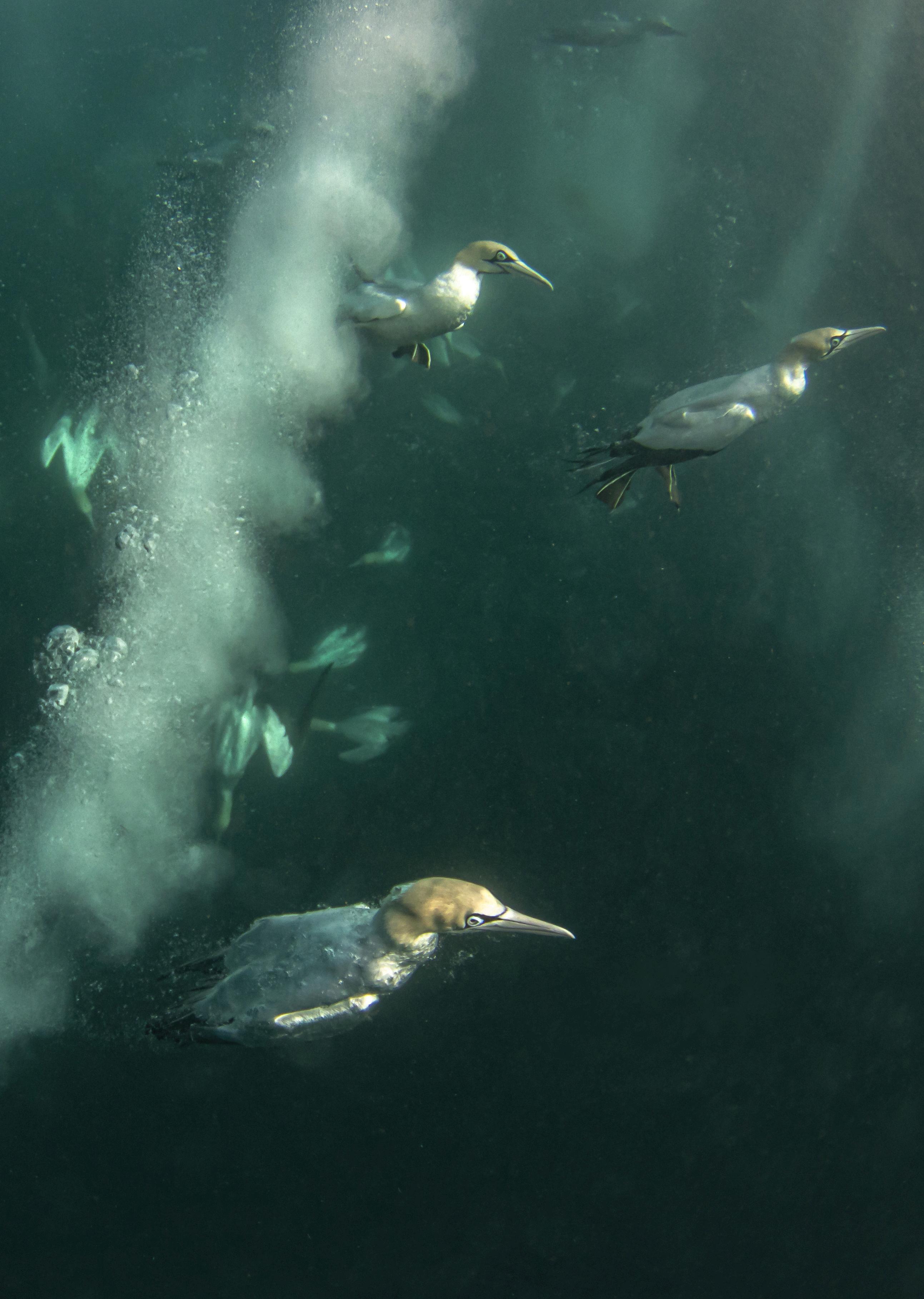
2023
BY
2023
PHOTO
BY
LINDA NESS SARDINE RUN
PHOTO
LINDA NESS SARDINE RUN
DAN is all about safety, what are your tips for keeping your diving safe:
“Know your surroundings, if it’s big surf, make sure that there is someone aware that you are out there” (Get to know your beach break!)
Be it freediving or scuba diving, know your limitations
Dive with professional operators and divers you trust
Be prepared to spend the time, don’t rush it!
Learn to understand animal behaviour to capture the best photos!
For more about Linda Ness, you can follow her on social media or visit her website.
Facebook: @Linda Ness
Instagram: @lindanesspix
Website: https://lindanesscoza/
The Extraordinary Adventures of Ramsamy the Sardine Book Sales: https://giftsbylocalscoza/
SA Photographer of the Year: https://southafricanpotycom/2023-winners/





COVER THROUGH DAN WWW.DANSA.ORG LIFESAVINGBENEFITS-24/7EMERGENCYHOTLINE-ACCESSTODIVE MEDICALEXPERTS-DIVINGRESOURCESTOKEEPYOUSAFE Yourgatewaytodivesafetyservices&worldwidedive coverageatlowannualrates!

DR JANNES LANDSCHOFF EXAMINING AN AMPHIPOD CRUSTACEAN UNDER THE DR JANNES LANDSCHOFF EXAMINING AN AMPHIPOD CRUSTACEAN UNDER THE MICROSCOPE IN OUR MAKESHIFT FIELD LABORATORY | @ NASREEN PEER
MICROSCOPE IN OUR MAKESHIFT FIELD LABORATORY | @ NASREEN PEER
HOLDFAST SPECIAL INTEREST
THE SWAY OF THE GREAT AFRICAN SEAFOREST
TEXTBYNICOLENEOLCKERS

The biodiverse coastline of South Africa spans two oceans and harbours more than 130 distinct habitat types. This marine environment is sustained by the confluence of the Benguela and Agulhas currents. It faces increasing threats from climate change, pollution and other activities such as unsustainable fishing practices, overexploitation of resources, and coastal development
Researchers studying one specific organism in this marine environment in False Bay are faced with numerous challenges Negotiating adverse ocean conditions and unpredictable weather makes it more challenging and also rewarding to conduct marine research
Scuba and freedivers from around the world have the Great African Seaforest on their todive wish list Most visitors to the bay will more likely only explore the graceful swaying top of the kelp fronds Some grab onto the sturdy stalks to pull themselves
underwater or to hold onto while filming a brief glimpse of this magical underwater world.
Dr Nasreen Peer is a marine scientist and lecturer in the Department of Botany and Zoology at Stellenbosch University. Along with co-PI Dr Jannes Landschoff, the lead scientist at the Sea Change Project and other marine scientists (Dr Koebraa Peters, Prof Carol Simon, Prof Charles Griffiths, and postgraduate students), this collaboration between Stellenbosch University and Sea Change Project focuses on the invertebrate diversity and ecology of kelp forests “We are all avid SCUBA and freedivers, so aside from being professionally invested in the work, we all hold a deep fascination and connection to the kelp forest habitat”, says Peer
More specifically, they are focussing their study on the microhabitat that is found between the ‘toes’ of the foot of the kelp, called the Holdfast They hope to categorise the biodiversity of invertebrates (crustaceans, polychaete worms, echinoderms, molluscs, amongst others)
A JUVENILE AMPHIPOD CRUSTACEAN IS NOT ALWAYS POSSIBLE TO IDENTIFY A JUVENILE AMPHIPOD CRUSTACEAN IS NOT ALWAYS POSSIBLE TO IDENTIFY TO SPECIES LEVEL | @ JANNES LANDSCHOFF, SEA CHANGE PROJECT TO SPECIES LEVEL | @ JANNES LANDSCHOFF, SEA CHANGE PROJECT
THE KELP HOLDFAST, A ROOT-LIKE STRUCTURE, ANCHORS THE THE KELP HOLDFAST, A ROOT-LIKE STRUCTURE, ANCHORS THE KELP TO THE SUBSTRATE. ITS COMPLEX CONSTRUCTION PROVIDES KELP TO THE SUBSTRATE. ITS COMPLEX CONSTRUCTION PROVIDES A REFUGE FOR A DIVERSE RANGE OF SMALL ORGANISMS | @ A REFUGE FOR A DIVERSE RANGE OF SMALL ORGANISMS | @ NASREEN PEER NASREEN PEER

OUR WESTERN CAPE KELP SYSTEMS CONSIST LARGELY OF OUR WESTERN CAPE KELP SYSTEMS CONSIST LARGELY OF THE GIANT BAMBOO KELP (ECKLONIA MAXIMA) WHICH FORM THE GIANT BAMBOO KELP (ECKLONIA MAXIMA) WHICH FORM TOWERING UNDERSEA FORESTS WITH CANOPIES. THE TOWERING UNDERSEA FORESTS WITH CANOPIES. THE UNDERGROWTH IS TEEMING WITH LIFE AND HIDDEN UNDERGROWTH IS TEEMING WITH LIFE AND HIDDEN DIVERSITY | DIVERSITY | @ NASREEN PEER @ NASREEN PEER
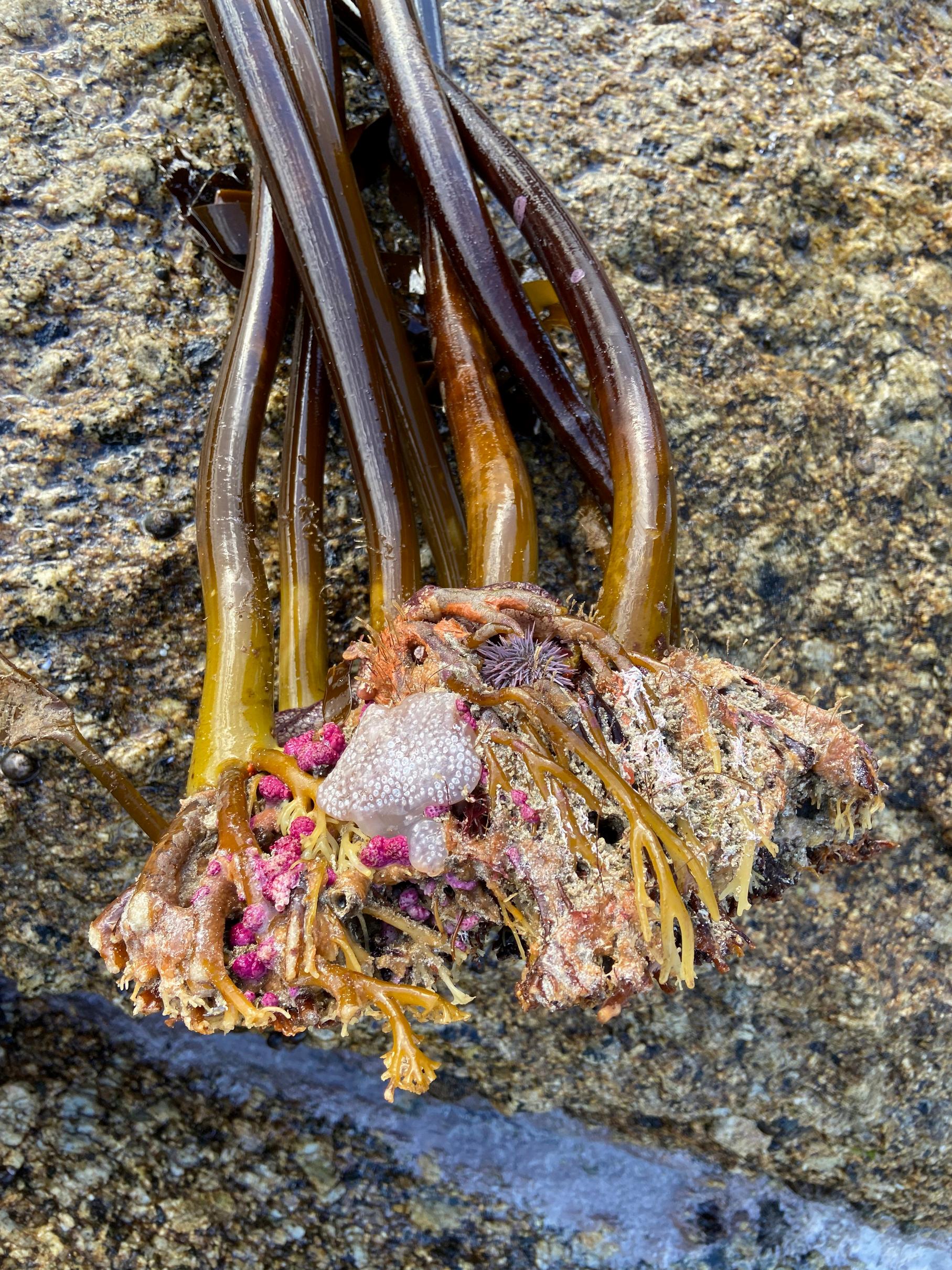

A WASHED UP TANGLE OF HOLDFASTS. ALTHOUGH THE MORE A WASHED UP TANGLE OF HOLDFASTS. ALTHOUGH THE MORE MOBILE SPECIES HAVE LONG SINCE LEFT, THE EPIFAUNA MOBILE SPECIES HAVE LONG SINCE LEFT, THE EPIFAUNA (INCLUDING SPONGES, ASCIDIANS, HYDROIDS, AND BRYOZOANS) (INCLUDING SPONGES, ASCIDIANS, HYDROIDS, AND BRYOZOANS) AS WELL AS A SMALL URCHIN STILL REMAIN | @ NASREEN PEER AS WELL AS A SMALL URCHIN STILL REMAIN | @ NASREEN PEER
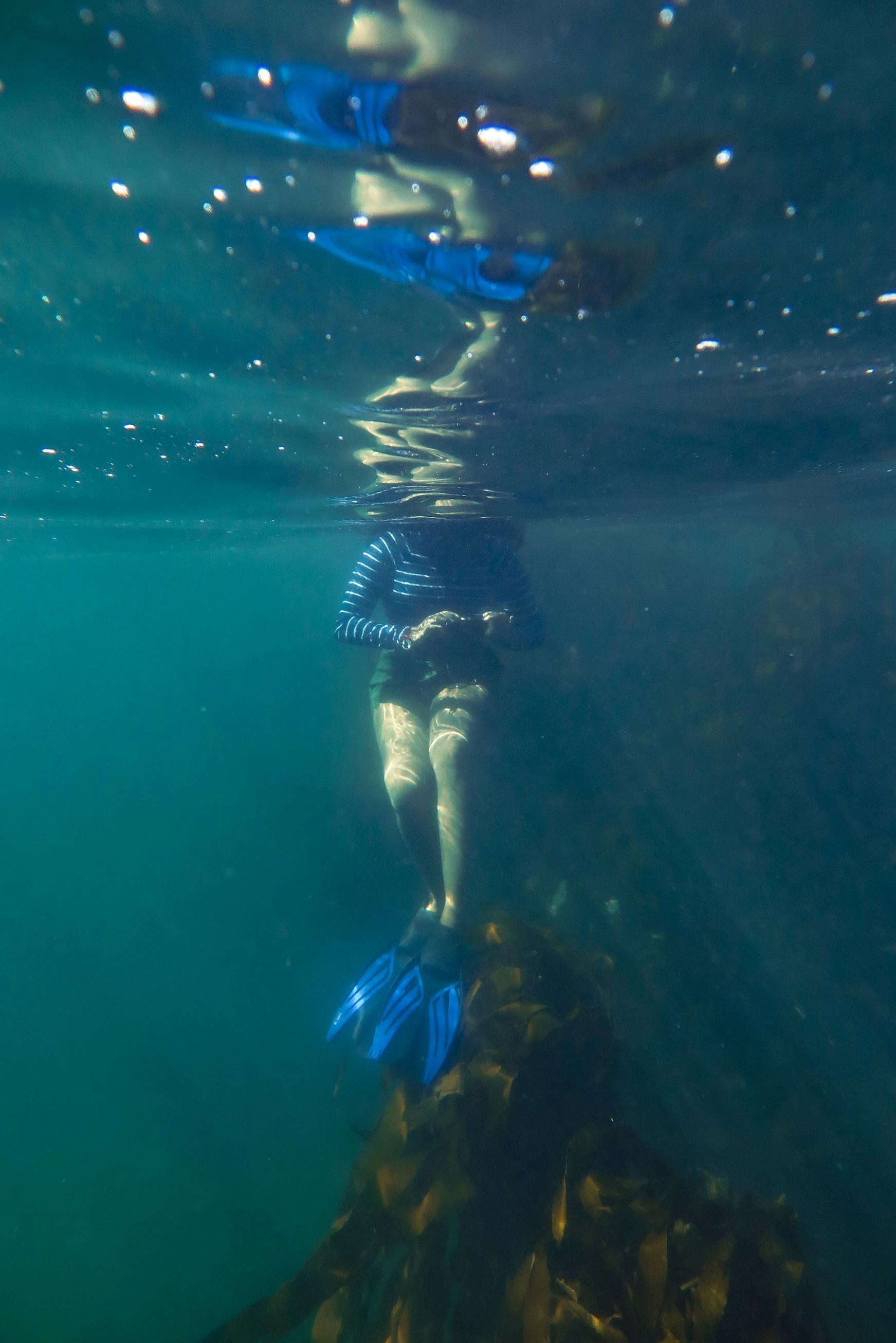
ALL THE RESEARCHERS INVOLVED IN THIS PROJECT ARE AVID
SCUBA AND FREEDIVERS. POSTGRADUATE STUDENT CHAITANYA
ALL THE RESEARCHERS INVOLVED IN THIS PROJECT ARE AVID SCUBA AND FREEDIVERS. POSTGRADUATE STUDENT CHAITANYA
KATHAROYAN ENJOYS FREEDIVING RECREATIONALLY AND USES
THESE SKILLS DURING SAMPLE COLLECTION | @ NASREEN PEER
KATHAROYAN ENJOYS FREEDIVING RECREATIONALLY AND USES THESE SKILLS DURING SAMPLE COLLECTION | @ NASREEN PEER

living in this microhabitat “We also want to understand whether with this biodiversity varies across geographic locations There are several marine ecoregions in South Africa, and the Great African Sea-forest spans at least 3 of these marine ecoregions”
THE GREAT AFRICAN SEAFOREST
Four species of kelp can be found along the South African coast On the west coast, the native giant bamboo kelp (Ecklonia maxima) seems to dominate This is the kelp that is seen mostly from shore and can grow up to 15 m tall Laminaria pallida, or split-fan kelp, often occurs as an understorey closer to shore and also found predominately at greater depths Macrocystis porifera, the giant bladder kelp, has a very small distribution off the Cape Peninsula On the east and south coast Ecklonia radiata, aka spiny kelp is generally found. It doesn’t grow tall (< 1m) and is generally confined to rock pools and the sublittoral zone. The bamboo kelp forest (nicknamed the Great African Sea
Forest) really is one of a kind in that it forms tall undersea “forests” the structure of which is very different to other kelp forests and has inspired the basis of coastal technology (eg Dr Sara Andreotti’s SharkSafe Barrier) Of course, our kelp forests have their own unique biodiversity, which remains understudied compared to other kelp forests globally
STUDYING KELP
By studying the kelp holdfast, the anchor that attaches the kelp to the rocky reefs, researchers want to find what lives in the kelp holdfast microhabitat It is a biodiverse little habitat, and very few studies have been conducted on this section of the kelp in South Africa It is challenging to study the whole marine system To focus their research on the holdfast and identifying the species found there will form a baseline. Without a well-studied baseline, it will be difficult to conduct other biological research in this system. From their first pilot project in
A NUDIBRANCH, PLACIDA CAPENSIS, COLLECTED FROM A HOLDFAST A NUDIBRANCH, PLACIDA CAPENSIS, COLLECTED FROM A HOLDFAST IN GANSBAAI | @ JANNES LANDSCHOFF, SEA CHANGE PROJECT IN GANSBAAI | @ JANNES LANDSCHOFF, SEA CHANGE PROJECT
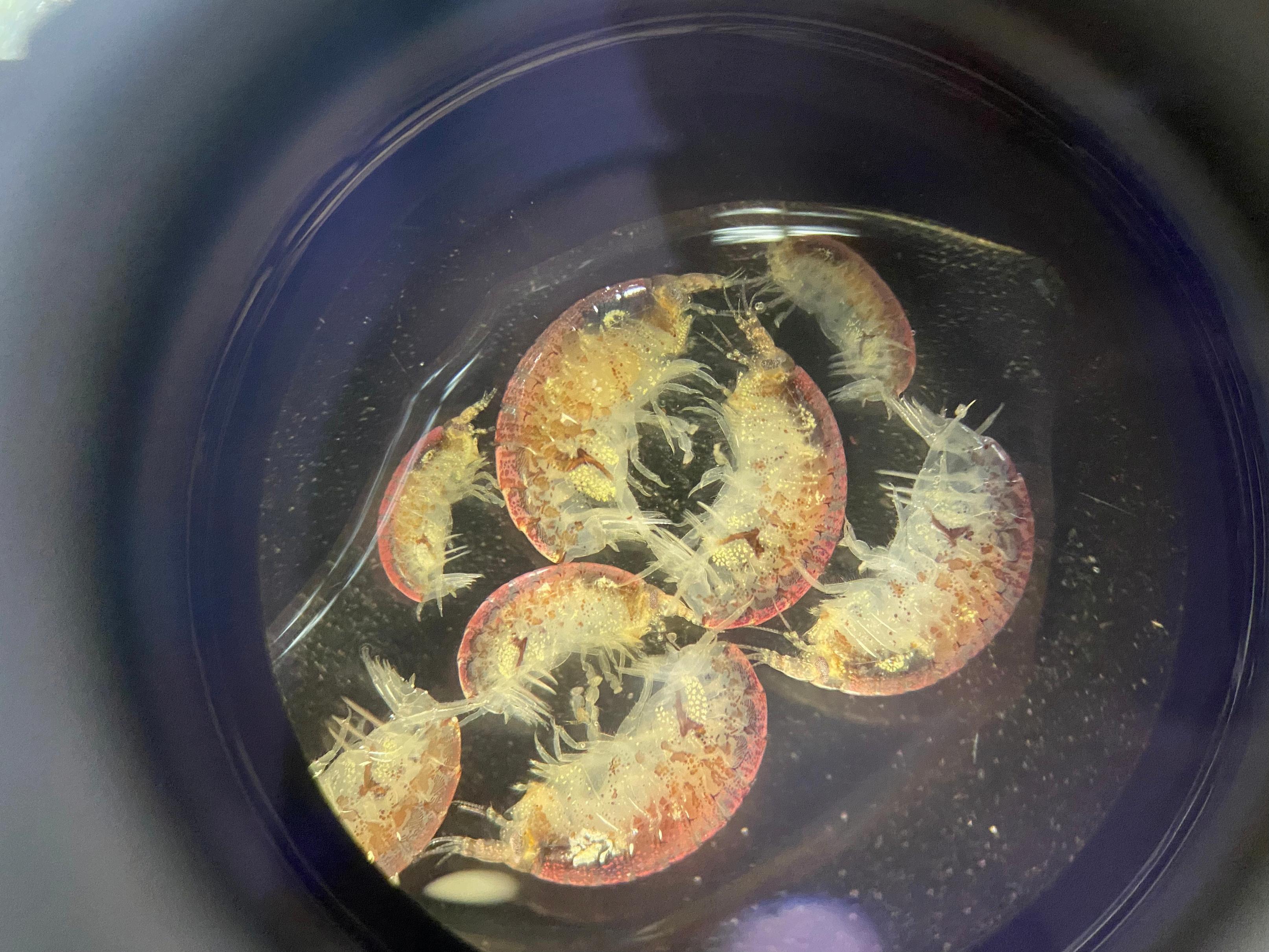
SORTING INVOLVES GROUPING TOGETHER SIMILAR-LOOKING SPECIMENS BEFORE EXAMINING THEM
SORTING INVOLVES GROUPING TOGETHER SIMILAR-LOOKING SPECIMENS BEFORE EXAMINING THEM UNDER A MICROSCOPE TO IDENTIFY CHARACTERISTIC FEATURES. A COLLECTION OF AMPHIPOD UNDER A MICROSCOPE TO IDENTIFY CHARACTERISTIC FEATURES. A COLLECTION OF AMPHIPOD CRUSTACEANS UNDER THE MICROSCOPE | @ NASREEN PEER CRUSTACEANS UNDER THE MICROSCOPE | @ NASREEN PEER
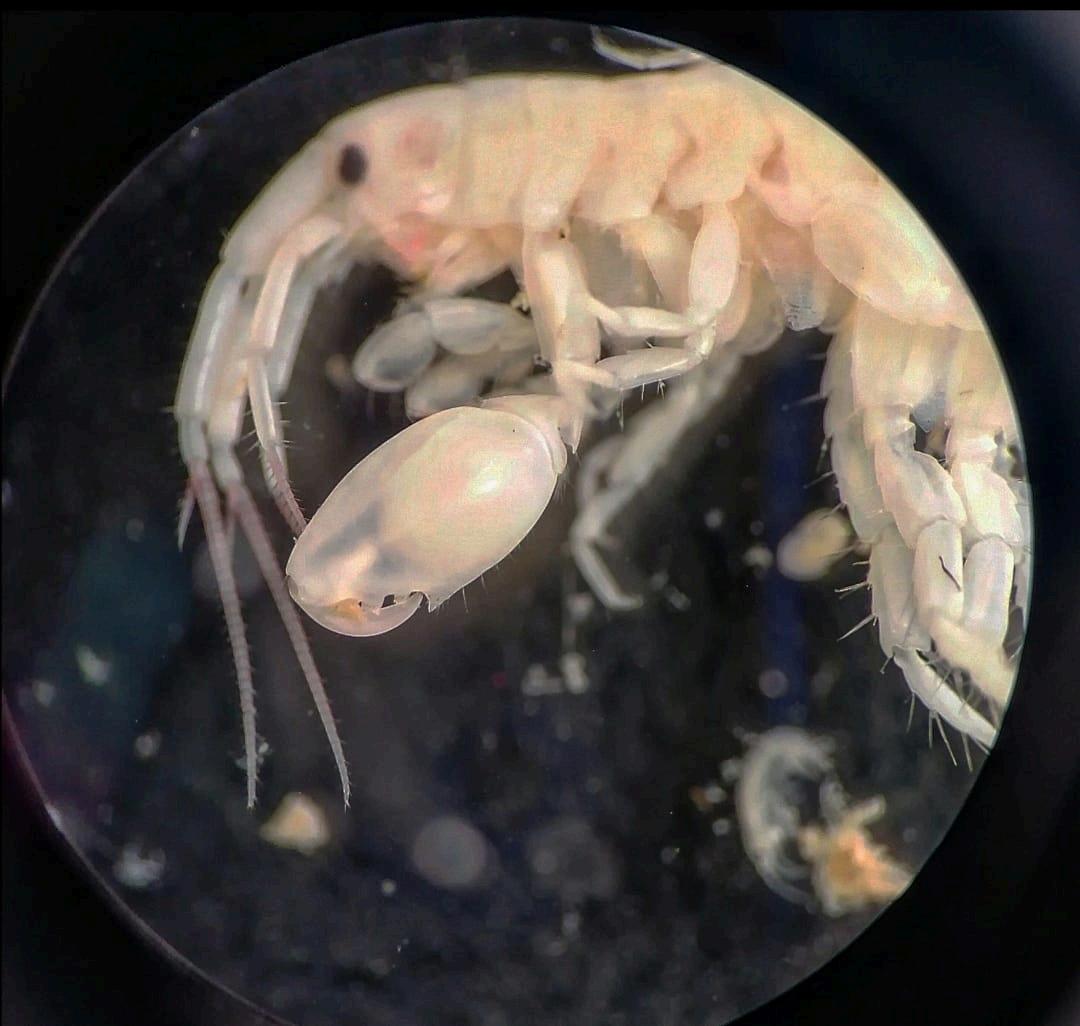
EXAMINATION OF SPECIMENS UNDER THE MICROSCOPE ALLOW US TO IDENTIFY EXAMINATION OF SPECIMENS UNDER THE MICROSCOPE ALLOW US TO IDENTIFY ORGANISMS TO SPECIES LEVEL. THE SHAPE AND SPINES OF THIS SEGMENT BELONG TO ORGANISMS TO SPECIES LEVEL. THE SHAPE AND SPINES OF THIS SEGMENT BELONG TO THE AMPHIPOD AUSTROMAERA MASTERSII | @ CHAITANYA KATHAROYAN THE AMPHIPOD AUSTROMAERA MASTERSII | @ CHAITANYA KATHAROYAN
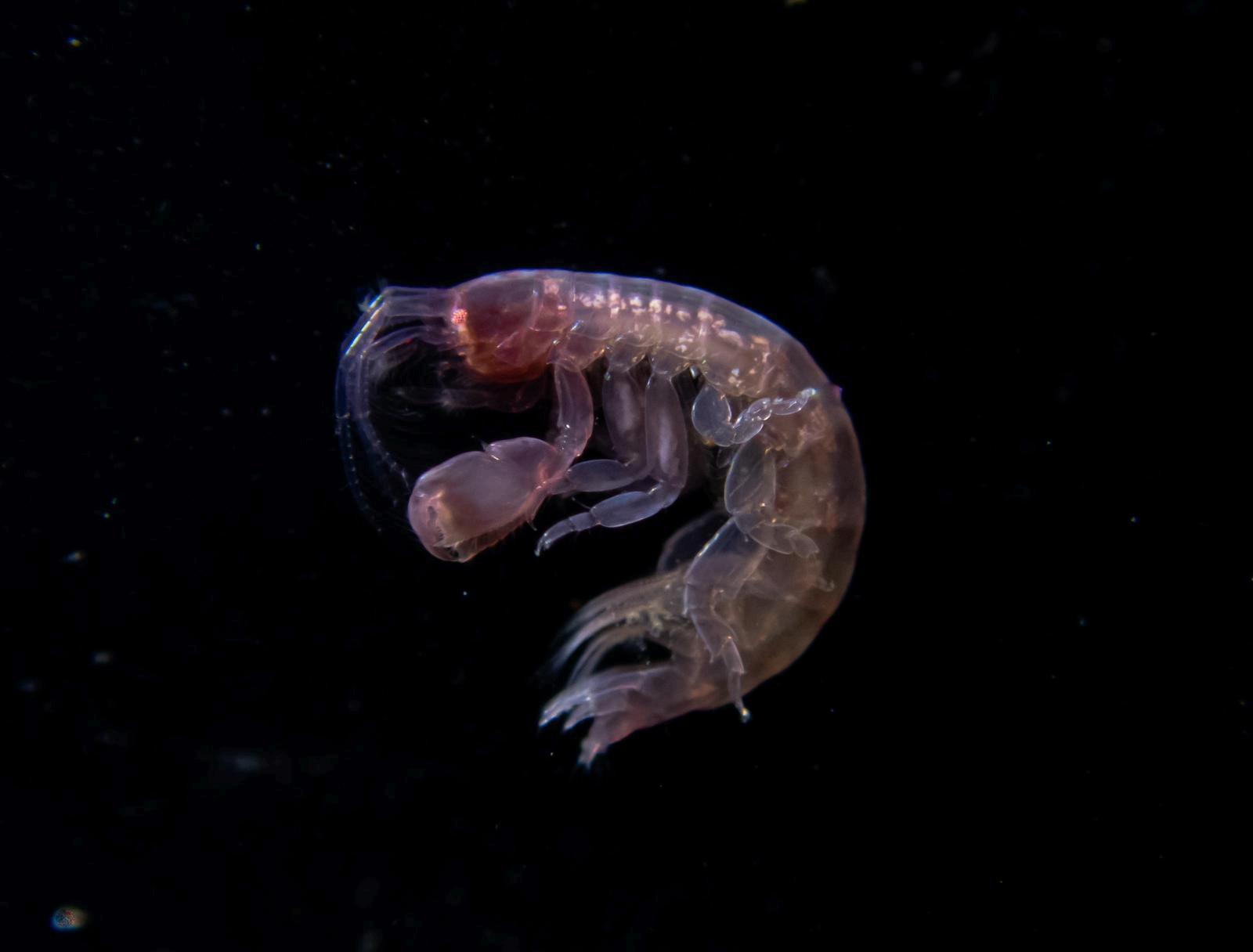
2022, results have revealed alien isopods, sea stars, mussels, and urchins in their juvenile stage inside the holdfast. “We hope to update taxonomic guides for many of these invertebrate groups. Currently, our guides are underpopulated and outdated despite the excellent efforts of earlier researchers. We also want to highlight the importance and wonder of ‘hidden life’: a life that occurs on a macro scale and life that exists in crevices under the sea” says Nasreen Thus far, Dr Peer and her team of scientists have found at least 150 species within a total of 40 holdfasts from 4 different locations A narrower look at just the crustaceans from just one site in Simonstown has revealed at least 92 crustacean species from just 10 holdfasts The levels of biodiversity are astounding They found that the most diverse site was St Helena Bay, which was unexpected as the site experiences high pollution loads “There are also several unique species, some that we are convinced have not yet been described”, says Nasreen
ENVIRONMENTAL FACTORS
There are several environmental factors that influence the distribution and abundance of South African kelp. Temperature predominantly affects the distribution of kelp. On the West Coast the occurrence of localised off shore cooling has allowed kelp populations to expand eastwards where a new population of E maxima was found at De Hoop about 10 years ago Other factors, such as wave exposure and nutrients, also play a role in shaping kelp morphology and determining which species are dominant
These kelp forests are an incredible biogenic habitat, a habitat structure created by living things eg kelp forests, coral reefs, mangrove prop roots, etc It is a complex, productive and protective habitat that facilitates high levels of biodiversity and abundance of life Within this diversity, researchers have found several other ecosystem services, including things like recycling nutrients and water filtration
THE AMPHIPOD CHEVALIA AVICULAE WHICH WAS FOUND FROM HOLDFASTS IN
THE AMPHIPOD CHEVALIA AVICULAE WHICH WAS FOUND FROM HOLDFASTS IN SIMONSTOWN AND ST HELENA BAY | @ JANNES LANDSCHOFF, SEA CHANGE PROJECT
SIMONSTOWN AND ST HELENA BAY | @ JANNES LANDSCHOFF, SEA CHANGE PROJECT
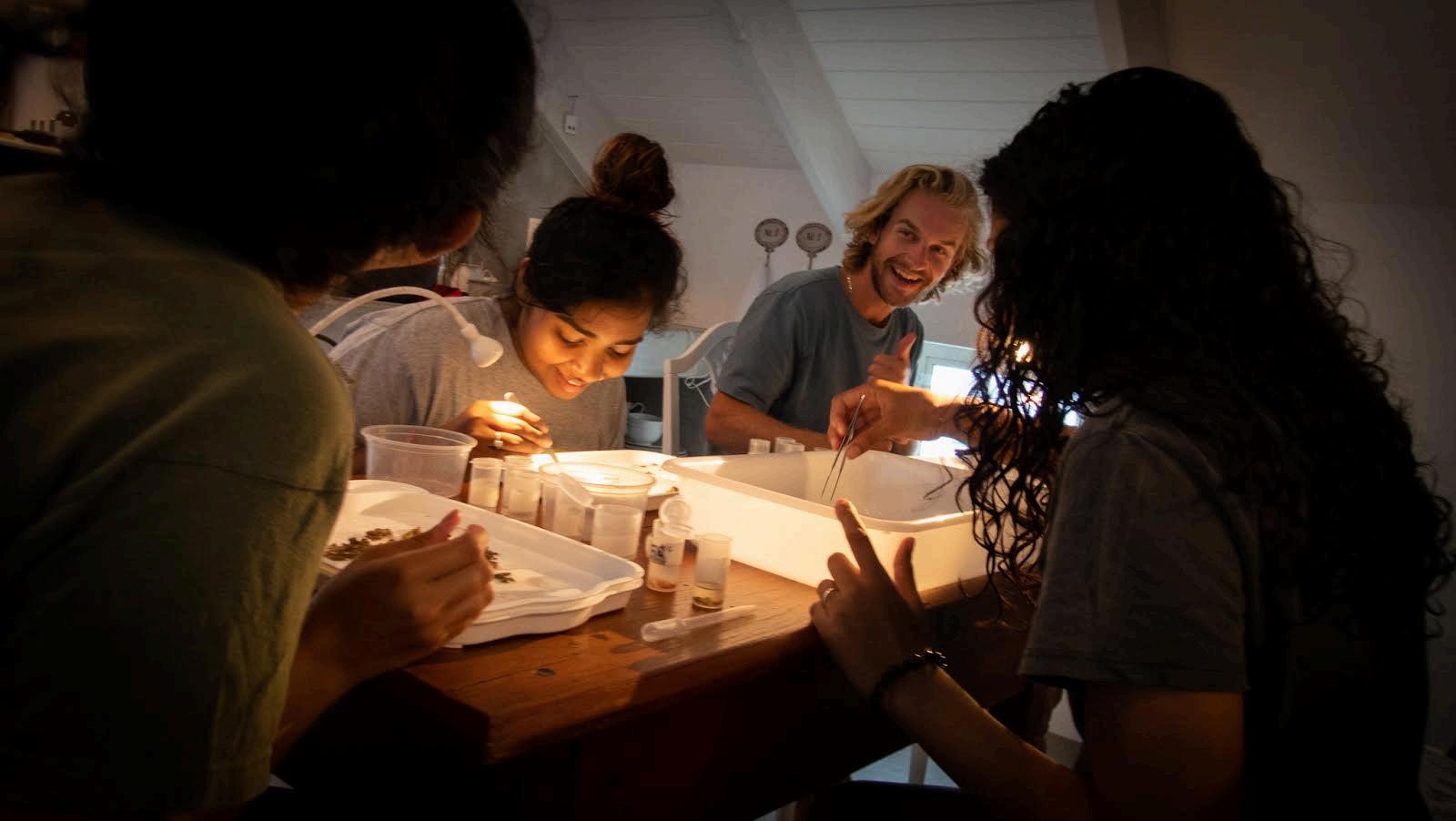
THE TEAM IS SORTING A HOLDFAST SAMPLE INTO BROAD SIMILAR-LOOKING GROUPS. FROM LEFT TO RIGHT, ZARA PREW, 2022 SEA CHANGE INTERN; CHAITANYA
THE TEAM IS SORTING A HOLDFAST SAMPLE INTO BROAD SIMILAR-LOOKING GROUPS. FROM LEFT TO RIGHT, ZARA PREW, 2022 SEA CHANGE INTERN; CHAITANYA
KATHAROYAN, POSTGRADUATE STUDENT WORKING ON HOLDFAST BIODIVERSITY; GARETH FEE, POSTGRADUATE STUDENT ASSISTING IN THE FIELD; NASREEN PEER, MARINE KATHAROYAN, POSTGRADUATE STUDENT WORKING ON HOLDFAST BIODIVERSITY; GARETH FEE, POSTGRADUATE STUDENT ASSISTING IN THE FIELD; NASREEN PEER, MARINE SCIENTIST AND HOLDFAST PROJECT LEAD | @ JANNES LANDSCHOFF, SEA CHANGE PROJECT SCIENTIST AND HOLDFAST PROJECT LEAD | @ JANNES LANDSCHOFF, SEA CHANGE PROJECT
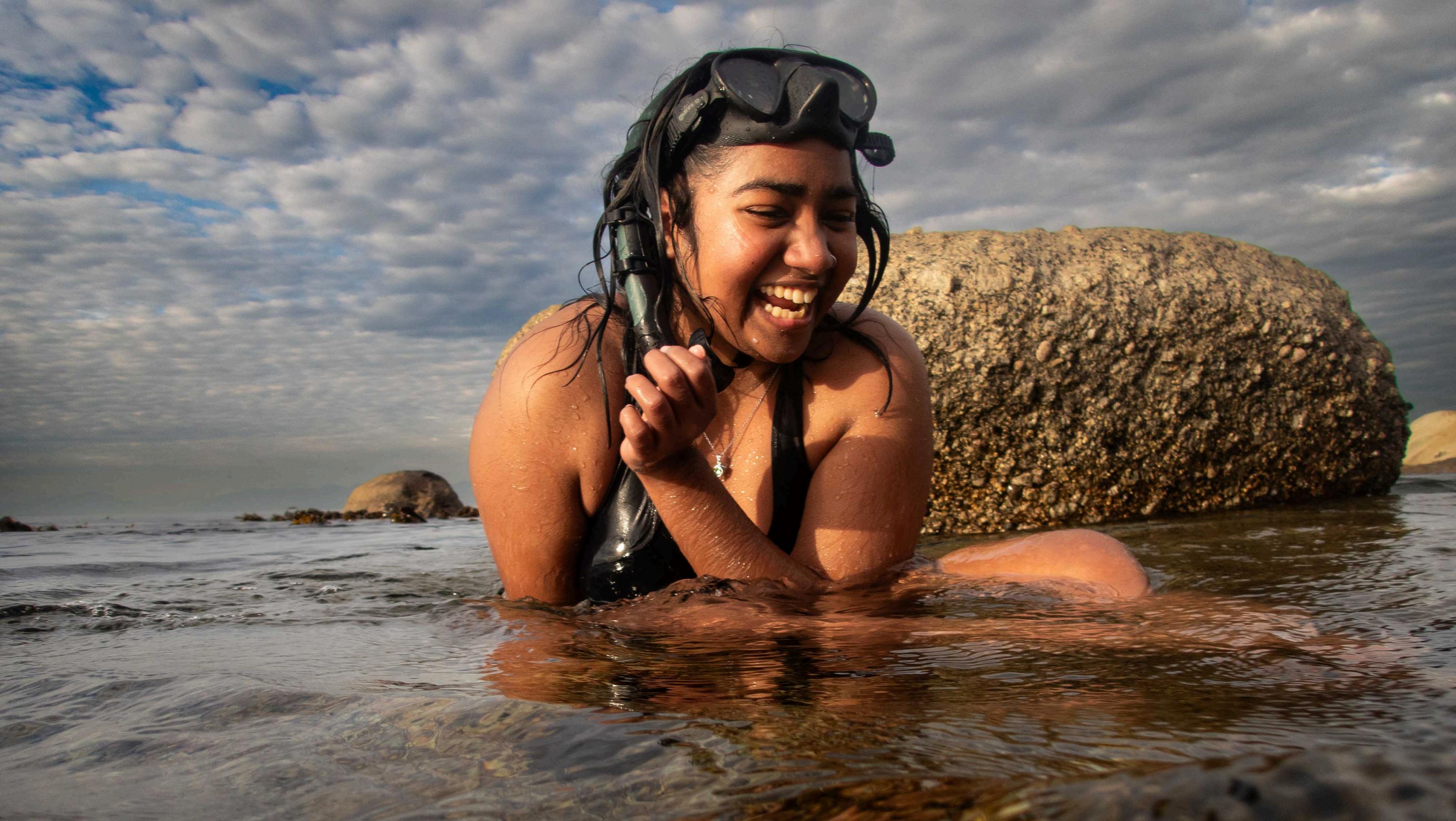
ALL THE RESEARCHERS INVOLVED IN THIS PROJECT ARE AVID SCUBA AND FREEDIVERS. POSTGRADUATE STUDENT CHAITANYA KATHAROYAN ENJOYS FREEDIVING ALL THE RESEARCHERS INVOLVED IN THIS PROJECT ARE AVID SCUBA AND FREEDIVERS. POSTGRADUATE STUDENT CHAITANYA KATHAROYAN ENJOYS FREEDIVING RECREATIONALLY AND USES THESE SKILLS DURING SAMPLE COLLECTION | @ JANNES LANDSCHOFF, SEA CHANGE PROJECT RECREATIONALLY AND USES THESE SKILLS DURING SAMPLE COLLECTION | @ JANNES LANDSCHOFF, SEA CHANGE PROJECT

Kelp forests are known to be great primary producers - meaning that food and energy is produced through photosynthesis of the kelp and other photosynthesising organisms that the kelp habitat supports. This primary productivity fuels complex food webs locally and in adjacent habitats. In turn, this supports the productivity of commercial and recreational fisheries, contributing to livelihoods and food security Even as detritus, kelp continues to support food webs Think of the sandy beach ecosystem, which appears to be so sparse and unpopulated; as soon as kelp detritus is washed up, there is a flurry of life as decomposers break down the detritus and continue to recycle these nutrients
Kelp offers a great coastal protection service
Take notice of how these large sub-surface kelp structures interfere with incoming swell, dissipating the wave energy so that by the time it reaches the shoreline, there is a much lower force pushing onto the beach This, in turn, influences coastal erosion
CONSERVATION
The threats facing South African kelp ecosystems include water temperature shifts, nutrient inflow, and storm surges, which all influence kelp population health. To fully understand and manage our kelp as a biological and commercial resource, we need to have knowledge of all the ecosystem processes and diversity within this habitat “ Our project sheds light on the hidden biodiversity, complex community interactions, and ecosystem functions that exist in these holdfasts”, says Peer
“We want to continue to disentangle the biodiversity of all invertebrate inhabitants of these holdfasts, group by group, site by site, until we have a much more complete picture Then we want to start asking bigger questions, eg how do temperature, kelp species, depth, etc, influence these communities? We want to begin to understand the ecological interactions between these species, and eventually, we’ll be able to ask whether global change has any effect on holdfast communities”
A SEGMENTED POLYCHAETE WORM |
@
A SEGMENTED POLYCHAETE WORM |
@
JANNES LANDSCHOFF, SEA CHANGE
PROJECT
JANNES LANDSCHOFF, SEA CHANGE PROJECT
ProsChooseDAN TrustedWhenItMattersMost

Tec Clark, Associate Director, Scuba Diving Nova Southeastern University, explains why he chooses DAN.
DIVERS ALERT NETWORK
W A T C H V I D E O Dive Safety Alert Diver

RAOUL COSCIA
SPECIAL INTEREST
INTERVIEWED BY THE
Underwater photography is a small niche market where few can afford to buy the best gear from well-established industry leaders. At the lower end it's mostly GoPros and Compact cameras with very little in between. Nowadays most divers venture underwater with some type of imaging device, from cellphones to the latest and greatest Mirrorless camera - but it’s a market rapidly growing in popularity.
Nothing conveys the incredible beauty, sense of scale and drama of ocean life as a full frame, wide angle shot of an underwater reefscape, a huge shoal of fish, or big animals up close - or a supermacro shot of the tiniest invertebrate that is barely visible to the naked eye
One Cape Town based underwater photographer that continually endeavours to inspire and achieve that underwater masterful image is Raoul Coscia
THE JOURNEY
Raoul’s interest in photography was sparked by a high school maths and science teacher who recognized his creative talent. With his encouragement, Raoul studied graphic design but soon found that it was not his truth and went on to complete a three-year Diploma in Photography at the University of Technology.
During his career as a professional commercial photographer, he has worked with diverse subjects including people, products, food, architecture, travel and events but is relatively new to photographing underwater: “I have been privileged to be able to do what I love most: photography and sharing the vision of my world around me with others, and my connection with the natural environment above and underwater, through my passion for diving,” said Raoul
DAN TEAM | PHOTOS BY RAOUL COSCIA

Raoul’s interest in diving began 12 years ago after a company team-building weekend in Sodwana Bay. After completing his Open Water Certification at the age of 50, a year later he acquired his first underwater housing for his compact camera but had limited diving opportunities while living in Johannesburg. It was only after moving back to his birthplace of Cape Town in mid-2014 that the real diving adventures began For another year he used his Canon S95 with its built-in flash and no other external lighting, in an Ikelite underwater housing He was unhappy and frustrated with the results and by the end of 2015, he invested in underwater strobes and upgraded to a DSLR set-up
He acknowledged the challenges of using the bigger equipment underwater but felt it was necessary to improve his photography “Looking back at those early dives, I had no idea what I was doing, nobody showed me how to do it, and I had to navigate my own way,” he says
WIDE-ANGLE OR MACRO?
“No preference, I love them both.” His happy place is the underwater world with his camera and he is comfortable with either setup. “In Cape Town, based on the weather and wind forecast, you prepare as best you can for conditions on the day, which can either be spectacularly clear visibility or dirty and surgy, not to mention the cold water temperature!”
Raoul and other photographers that he dives with have often made the wrong call about which setup to bring Their standing joke is: “Macro or wide?”
"Some days it’s difficult to predict what conditions will be like despite the forecast, and once out onthe boat you have to live with your choice for the day,” he said He is known to bring two lenses and different ports onto the boat and change them between dives, but does not recommend this
PUFFADDER SHY SHARK, FALSE BAY, CAPE PENINSULA PUFFADDER SHY SHARK, FALSE BAY, CAPE PENINSULA
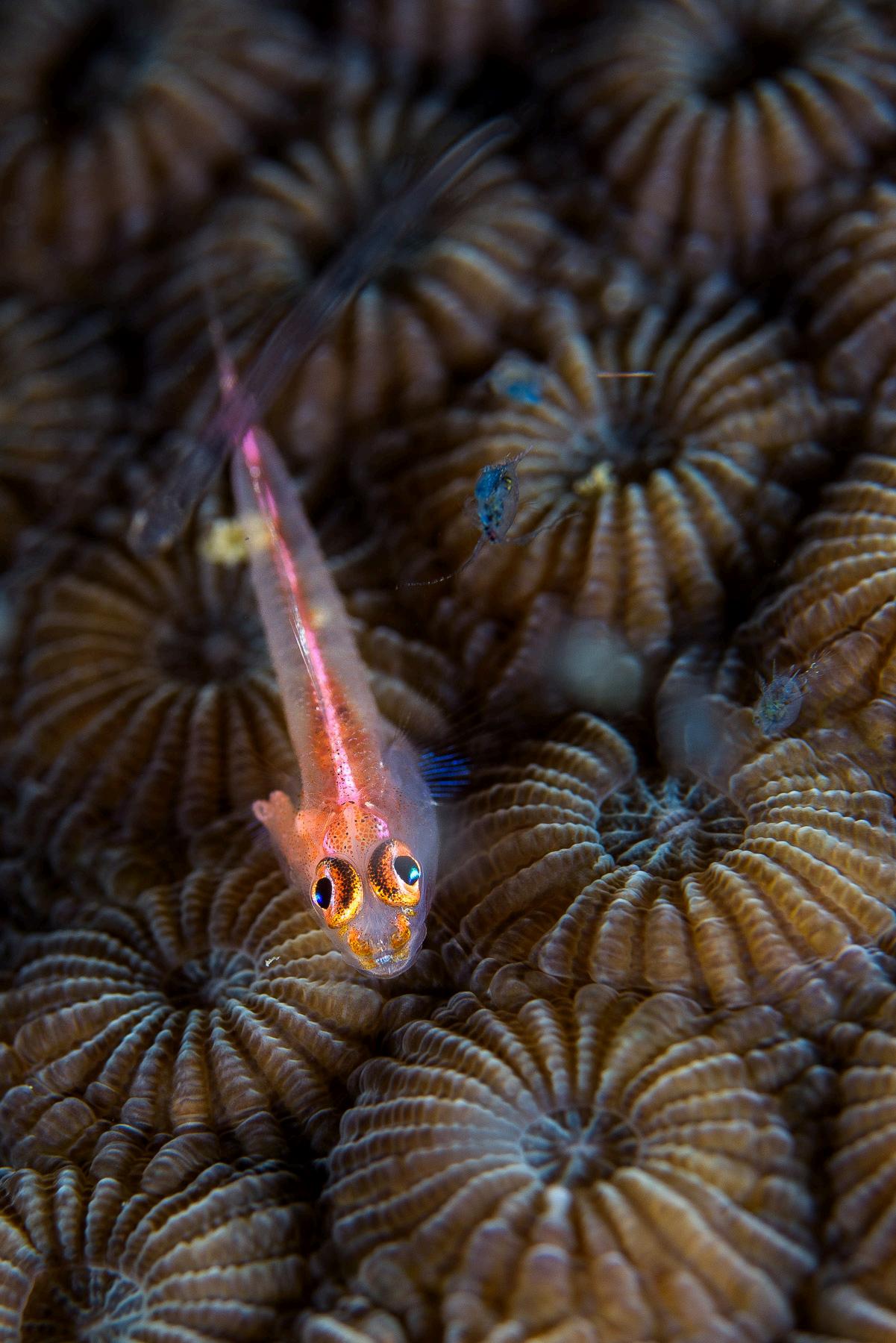
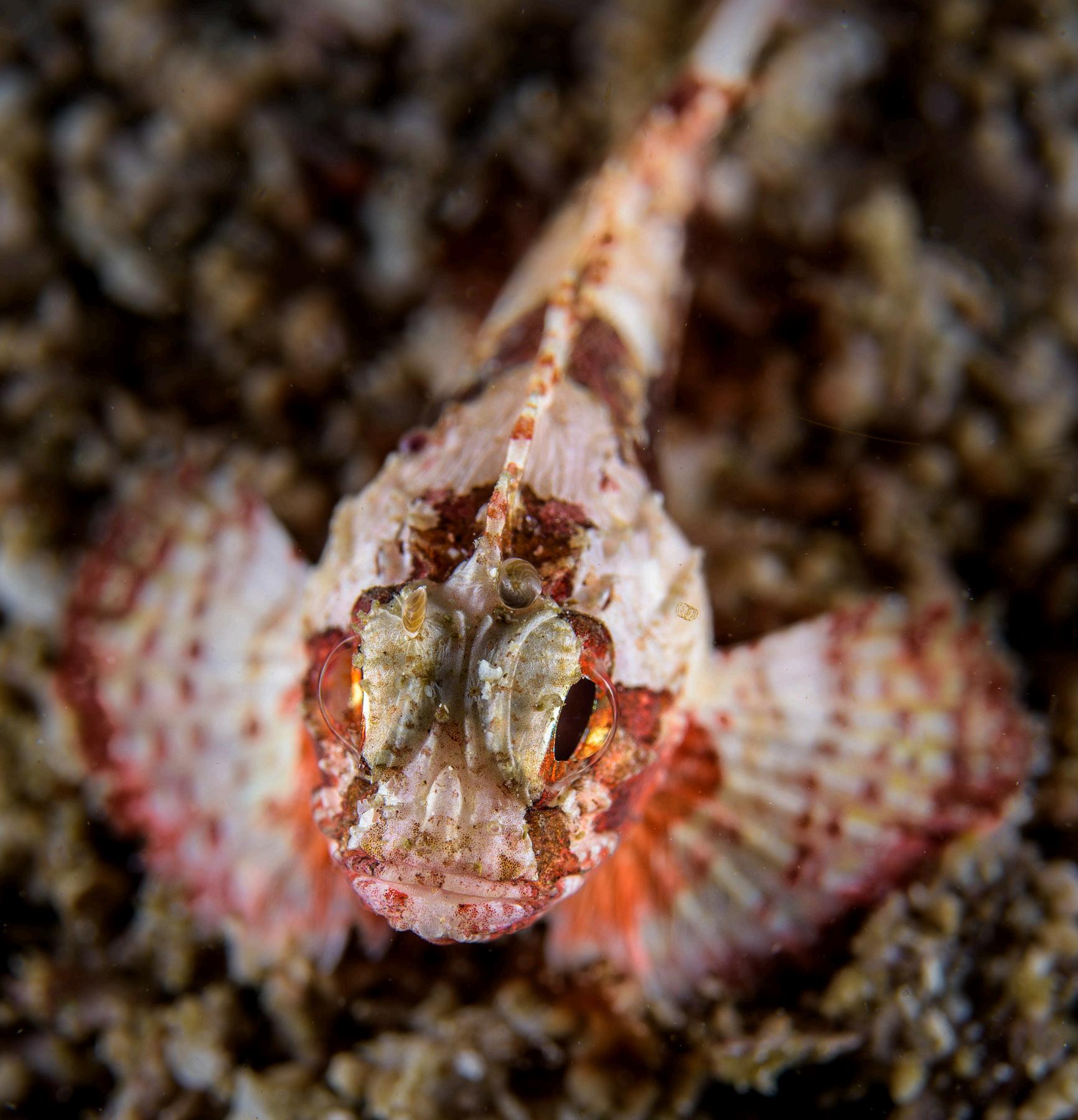 GHOST GOBY, YILLIET CORNER, RAJA AMPAT, WEST PAPUA GHOST GOBY, YILLIET CORNER, RAJA AMPAT, WEST PAPUA
JUVENILE SCORPION FISH, SAPORKREN SURPRISE, RAJA AMPAT, WEST PAPUA JUVENILE SCORPION FISH, SAPORKREN SURPRISE, RAJA AMPAT, WEST PAPUA
GHOST GOBY, YILLIET CORNER, RAJA AMPAT, WEST PAPUA GHOST GOBY, YILLIET CORNER, RAJA AMPAT, WEST PAPUA
JUVENILE SCORPION FISH, SAPORKREN SURPRISE, RAJA AMPAT, WEST PAPUA JUVENILE SCORPION FISH, SAPORKREN SURPRISE, RAJA AMPAT, WEST PAPUA
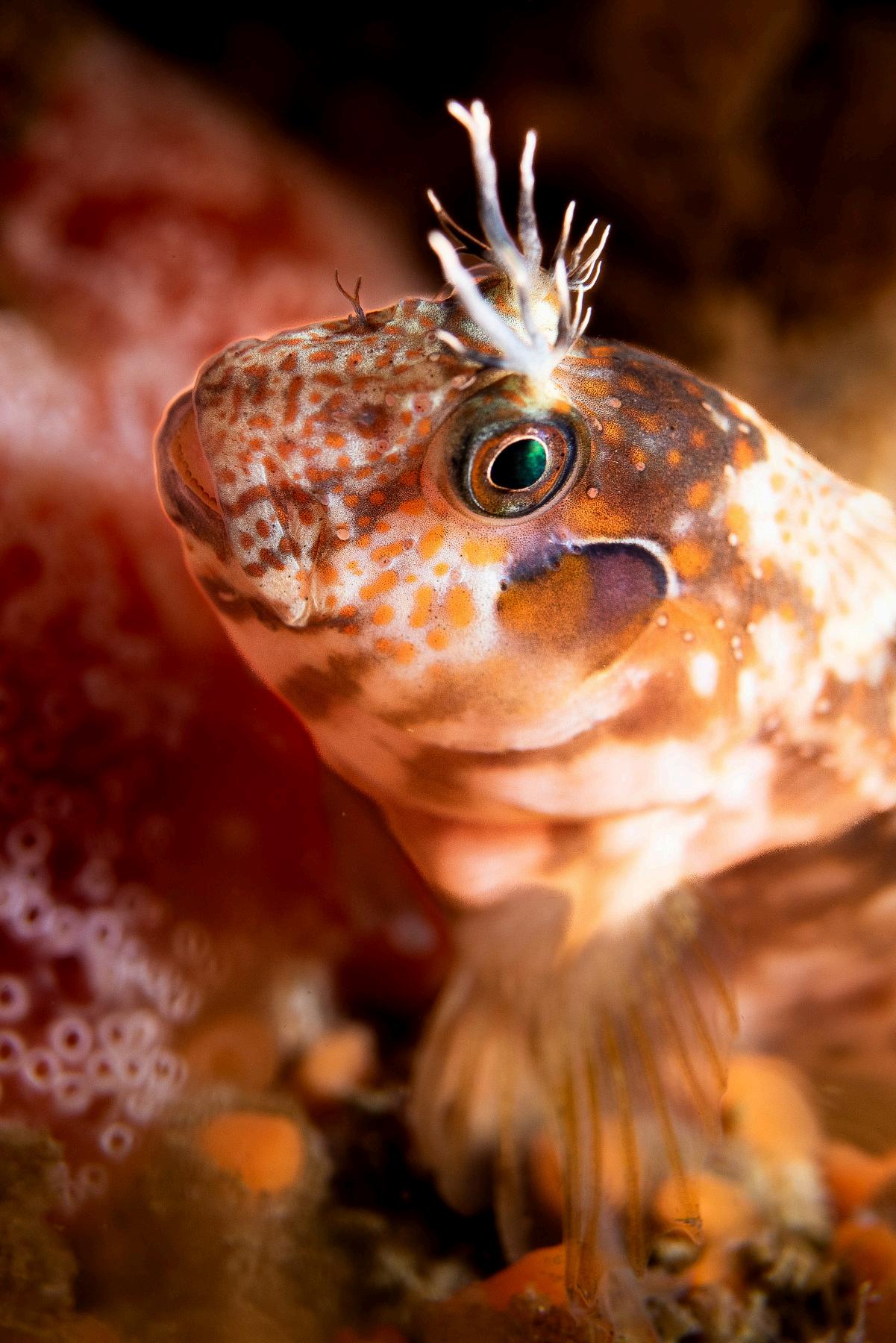 BLENNY, SMITSWINKEL BAY WRECK, CAPE PENINSULA BLENNY, SMITSWINKEL BAY WRECK, CAPE PENINSULA
BLENNY, SMITSWINKEL BAY WRECK, CAPE PENINSULA BLENNY, SMITSWINKEL BAY WRECK, CAPE PENINSULA
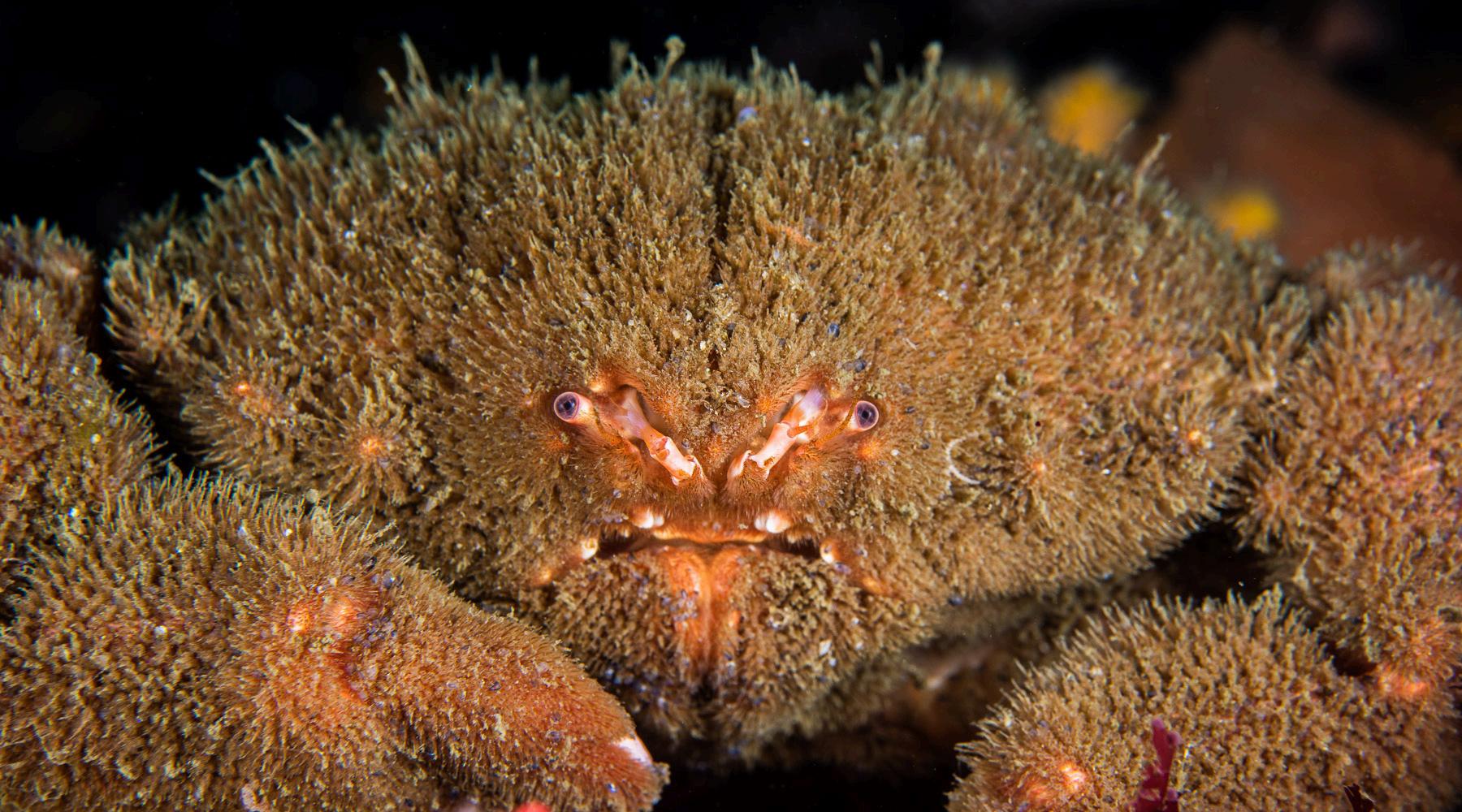
Both disciplines have their merits and challenges but serve the same purposecreating beautiful pictures to illustrate not only the incredible variety and aesthetic natural beauty of the underwater world, but the fragility and life-and-death struggle of its inhabitants.
Underwater photographers are privileged to participate in the underwater realm, interacting with its inhabitants, observing and recording their behaviour They constantly challenge themselves and their peers for the closest, sharpest macro shot of the tiniest critter, or wide angle shots of the awesome size and grace of a whale, the spectacular topography of a reefscape or a wreck teeming with thousands of fish, adorned with colourful corals and fans; or a kelp forest with ‘God rays’ of light beaming through the fronds down to the depths below “The ocean always has something new, different and amazing to offer and teach us, no matter how many times we enter into it,” said Raoul
Macro photography gives him opportunities to see the ocean’s smaller creatures up close, using his focus light to catch the movement or glint in the eye of a tiny, transparent and often barely visible Goby. “These amazing, fascinating fish are among the smallest vertebrates on the planet and some of my favourite macro subjects.”
Macro challenges include shallow depth-offield due to close proximity to the subject, and even more so with a diopter lens The photographer needs to be skilled at keeping still while composing the shot, framing and maintaining focus on a skittish subject and avoiding unwanted, distracting elements While positioning your strobes to light and expose your subject correctly and avoid backscatter, a diver should ensure good buoyancy so as not to make contact with the surrounding environment
Underwater photography with a wide-angle lens can capture the stunning beauty, scale, and drama of a reefscape, a vast school of fish, or a close-up of a large marine animal,
SUMO CRAB, HOUT BAY, CAPE PENINSULA SUMO CRAB, HOUT BAY, CAPE PENINSULA

 RED SEA SAILFIN TANGS, RAS UM SID, EGYPT
RED SEA SAILFIN TANGS, RAS UM SID, EGYPT
SWEETLIPS, SAWANDAREK JETTY, RAJA AMPAT, WEST PAPUA
SWEETLIPS, SAWANDAREK JETTY, RAJA AMPAT, WEST PAPUA
RED SEA SAILFIN TANGS, RAS UM SID, EGYPT
RED SEA SAILFIN TANGS, RAS UM SID, EGYPT
SWEETLIPS, SAWANDAREK JETTY, RAJA AMPAT, WEST PAPUA
SWEETLIPS, SAWANDAREK JETTY, RAJA AMPAT, WEST PAPUA

EGYPT
SEA, EGYPT
GLASSFISH ON CARNATIC WRECK, RED SEA,
GLASSFISH ON CARNATIC WRECK, RED
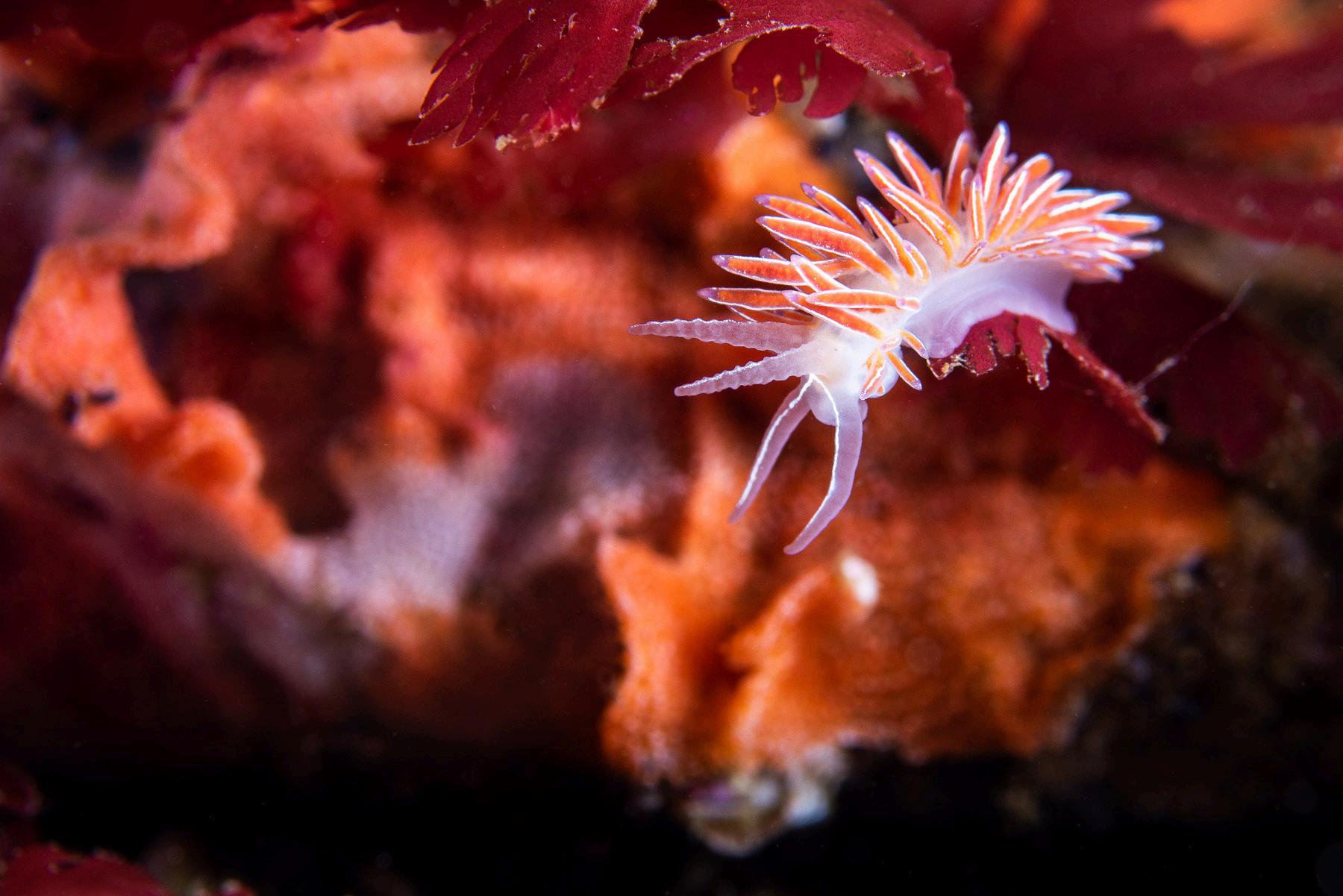
which presents its own challenges: “Exposing your subject properly with artificial flash lighting correctly positioned relative to the subject and balancing the ambient light of the surrounding environment whilst controlling and reducing backscatter is essential to the success of your shot.”
“When shooting into available light, with or without flash, you have to be aware of your position relative to the sun, and it’s extremely rewarding when it all comes together and you get it right”
“Irrespective of what you shoot, the shot should be technically flawless or as close as possible” His background as a pro photographer is ingrained: “I am my own harshest critic and my minimum criterion is that it should be in sharp focus, whether it’s overall or selective; how you frame the subject and light it, the story you are trying to convey, your skill in controlling the lighting and image brightness, whether with ambient, artificial lighting or a combination of both
But it’s not only about technical perfection, you have to go above and beyond merely a ‘record’ shot to find your own style and voice. Anyone can point a camera at a reef, animal or critter and press the shutter button.”
“I’ve seen divers with cameras, both novice and experienced, charging in towards an animal or fish with no consideration for the subject’s behaviour and body language and how it will react, in pursuit of ‘getting the shot’ for social media Likes and their egos, without empathy or respect for that animal (some underwater photographers, myself included, at some stage in their journey might be guilty of this!)”
On a 9-day trip I went on to Raja Ampat last year, we had not seen a Walking ‘epaulette’ shark until our very last night dive, when one finally appeared A diver in our group, quite a good photographer, charged in towards the little shy creature with his dazzling video lights lighting up the darkness like stadium floodlights
NUDIBRANCH (WHITE TIP?) VULCAN ROCK, HOUT BAY, CAPE PENINSULA
NUDIBRANCH (WHITE TIP?) VULCAN ROCK, HOUT BAY, CAPE PENINSULA

The undeniably terrified and unhappy shark dashed away, trying to hide in the alcoves of the reef and he just chased it in every direction it went, trying to anticipate where it might pop out next. The result: no-one else got a chance at a shot, and I don’t think he got his shot either, because I’ve never seen it on his social media feed.”
POST-PRODUCTION
He shoots only RAW format which allows full control of his image editing and his software of choice is Adobe Lightroom Classic AItechnology is advancing at a lightning-fast exponential pace but he is not a big fan “I only really use it for noise reduction and occasionally, image enhancement,” he said He tries to capture the shot properly in camera in order to keep his photo editing to a minimum, doing only the basic and necessary edits and strongly believes that the purer and truer the image, the better and more credible it will be
FUTURE IMAGING ENDEAVOURS
“I love photographing just about everything underwater.” He uses his technical knowledge and skill to create beautiful images and share his experiences whilst pushing himself beyond his comfort zone. “Motivation and passion for what you do is essential but above all, you need emotional connection I don’t want my relationships to be superficial and I certainly don’t want my images to be superficial, and you have to allow yourself to have an emotional, empathetic connection with what you’re photographing; if you don’t, everything is superficial and it comes across in your photography I am always learning and striving to improve, and each adventure, both above and underwater, teaches me new, different lessons”
As underwater photographers we should be flexible, think on the fly, always be ready and environmentally aware of a subject that is
BASKET STAR, TAFELBERG REEF, HOUT BAY, CAPE PENINSULA BASKET STAR, TAFELBERG REEF, HOUT BAY, CAPE PENINSULA
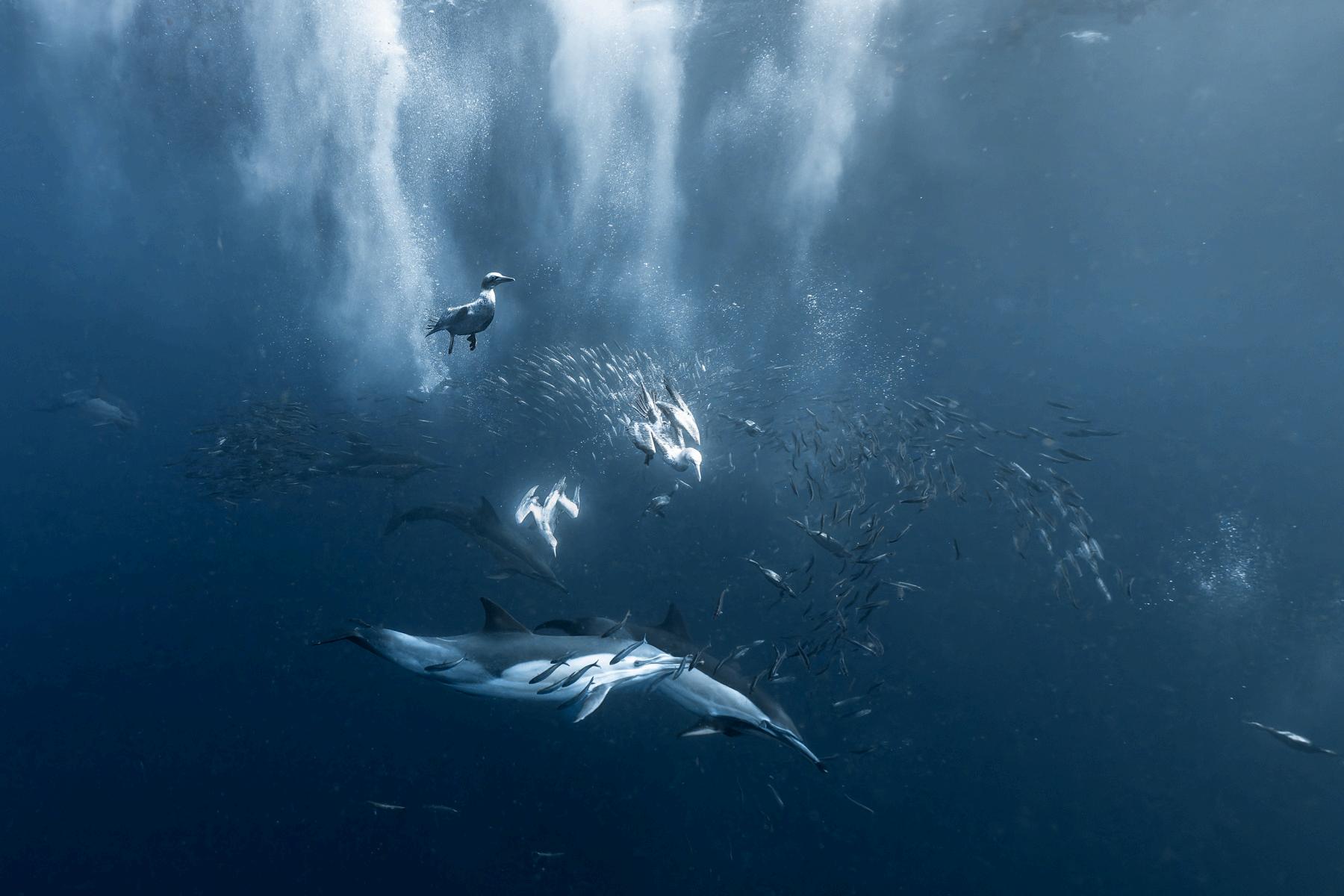

BLUE SHARK, OPEN OCEAN 25KM OFF CAPE OF GOOD HOPE BLUE SHARK, OPEN OCEAN 25KM OFF CAPE OF GOOD HOPE
SARDINE RUN, WILD COAST, EASTERN CAPE SARDINE RUN, WILD COAST, EASTERN CAPE
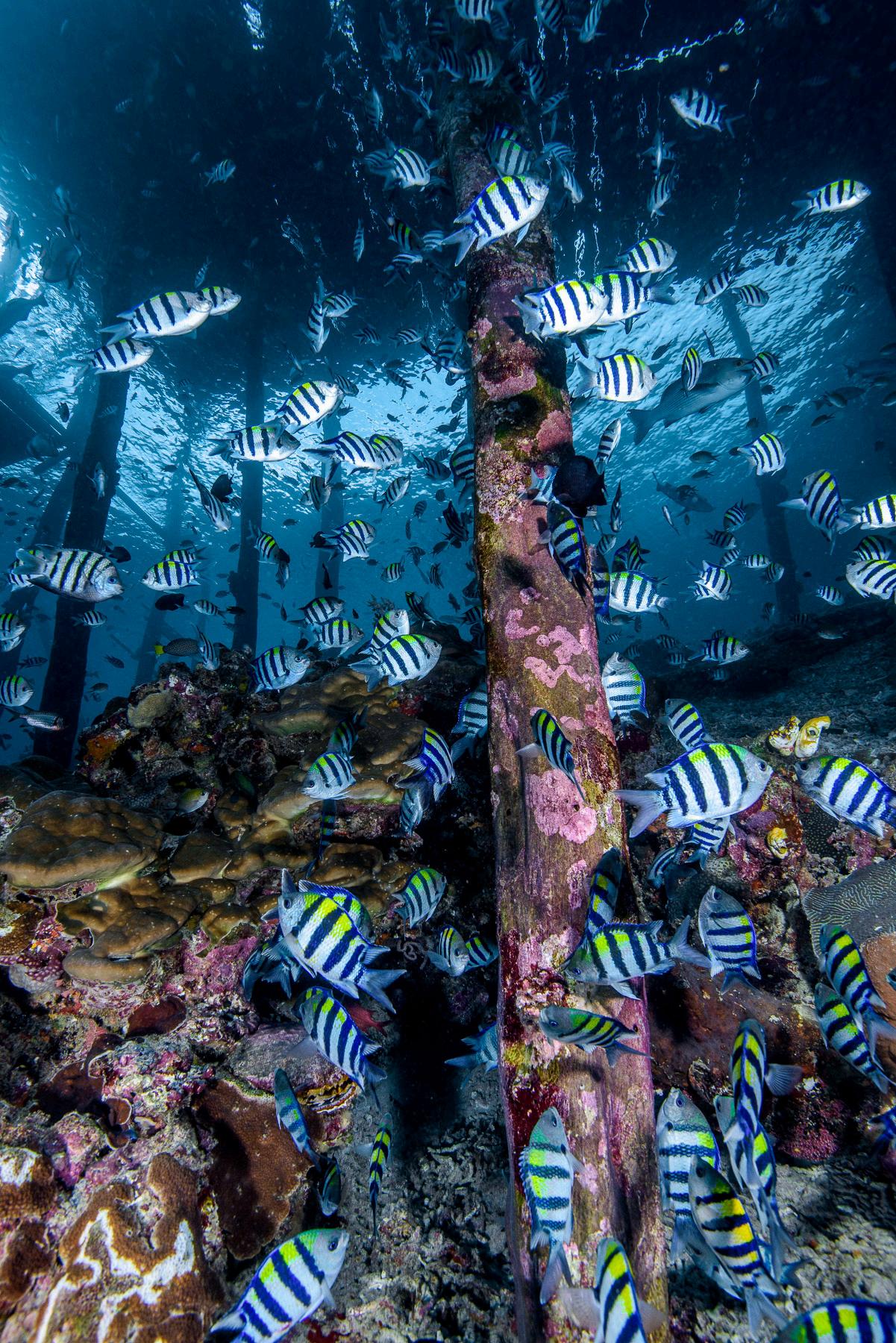
RAJA AMPAT, WEST PAPUA ARBOREK JETTY, RAJA AMPAT, WEST PAPUA
ARBOREK JETTY,
often changing or moving - but there are also many marine animals that will spend their entire lives in one spot “I love the spectacle of an enormous shoal of fish, especially tiny Glassfish, Sardines or big Trevallies swirling around I want to experience and photograph massive pods of Dolphins, migrating Humpback whales or huge aggregations of Mobula rays or Hammerhead sharks - my next adventures maybe?”
He loves travelling to exotic and remote locations and his bucket list of places he would love to see underwater includes Norway for encounters with Orcas and whales; Antarctica, Madagascar, Reunion Island and Seychelles, Maldives, Azores & Canary Islands, Philippines, Palau, Polynesia, Indonesia, to name a few; Raoul’s future dive travels might just include an around-theworld expedition resulting in more spectacular underwater images
“Mastering Underwater Photography”

ProsChooseDAN TrustedWhenItMattersMost

Captain Breezy Grenier, Owner, Breezy SEAS, explains why she chooses DAN.
DIVERS ALERT NETWORK
W A T C H V I D E O Dive Safety Alert Diver

REVIEW
FROM A DAN MEMBER
CHANTELLE BEESLAAR
I can call DAN anywhere, anytime for anything. They always assist and make sure you get the advise and help that you need No matter how big or small your problem or question might seem



COVER THROUGH
WWW.DANSA.ORG LIFESAVINGBENEFITS-24/7EMERGENCYHOTLINE-ACCESSTODIVE MEDICALEXPERTS-DIVINGRESOURCESTOKEEPYOUSAFE Yourgatewaytodivesafetyservices&worldwidedive coverageatlowannualrates!
DAN
CALLING THE DAN HOTLINE
WHEN SHOULD I PHONE THE DAN HOTLINE?
All diving emergencies
Non-diving medical emergencies
Diving medical information, such as fitness to dive, medication, and travel medical advice and enquiries
Travel notifications and advice
Diving medical examiner contact details
International medical centres or doctors who want to confirm DAN memberships
WHAT DO I NEED TO HAVE READY?
The caller and/or patient’s name and contact number
The nature of the emergency
The patient’s DAN membership number, if applicable or known
The patient’s medical aid information, if the incident occurred within South Africa
The patient’s travel insurance information, if applicable
If the caller is not at the scene, at least one local contact number should be provided in order to reach the person that is in need of assistance, or those who are in charge of their care
WHAT HAPPENS AFTER I HAVE LOGGED THE EMERGENCY?
DAN makes a conference call to one of the on-call diving medical officers (DMOs) when an emergency call is received and the nature of the event has been established The DMO will provide specialist diving medical advice regarding how and what should be done immediately and will also make decisions concerning the further management of each case, depending on the situation
WILL I GET EVACUATION BY AIR?
Aeromedical resources, such as helicopters and air ambulances, cannot be dispatched unless authorised by the DMO It may take longer to activate an air ambulance than it would take to mobilise emergency medical services via a ground ambulance Several factors, aside from costs, will determine aeromedical evacuation
The DAN hotline provides emergency medical assistance to injured divers We encourage you to call early, even when you are uncertain, rather than wait until the situation has become critical as the opportunity to assist becomes more restricted.
DIVE ESSENTIALS
IMPORTANT FACTORS TRANSPORT
THE AVAILABILITY OF TRANSPORT
Is an air ambulance or a helicopter available?
THE INJURY
THE NATURE OF THE INJURY
How urgently does the patient need advanced life support and should they be moved to intensive care?
THE LOCATION
THE LOCATION OF THE PATIENT
What are the optimal logistical considerations for efficiently and safely moving the patient to a place where they can receive medical assessment and appropriate medical care, with appropriate medical support, during the transfer?
LANDING ZONE
VARIOUS ASPECTS REGARDING THE LANDING ZONE OR AIRPORT
Are these appropriate for a helicopter or a fixed-wing air ambulance? Are these open, particularly at night? What are the customs or immigration requirements? What are the implications of getting the patient to the landing zone or airport, or the crew to the patient?
INTERNATIONAL CALLS +27 82 810 6010
HOTLINE
ProsChooseDAN TrustedWhenItMattersMost

Ivana Inglesina & Victoria Cole, PADI® Platinum Course
Directors, Pro Dive Vibes, Curacao, explain why they choose DAN.
DIVERS ALERT NETWORK
W A T C H V I D E O Dive Safety Alert Diver
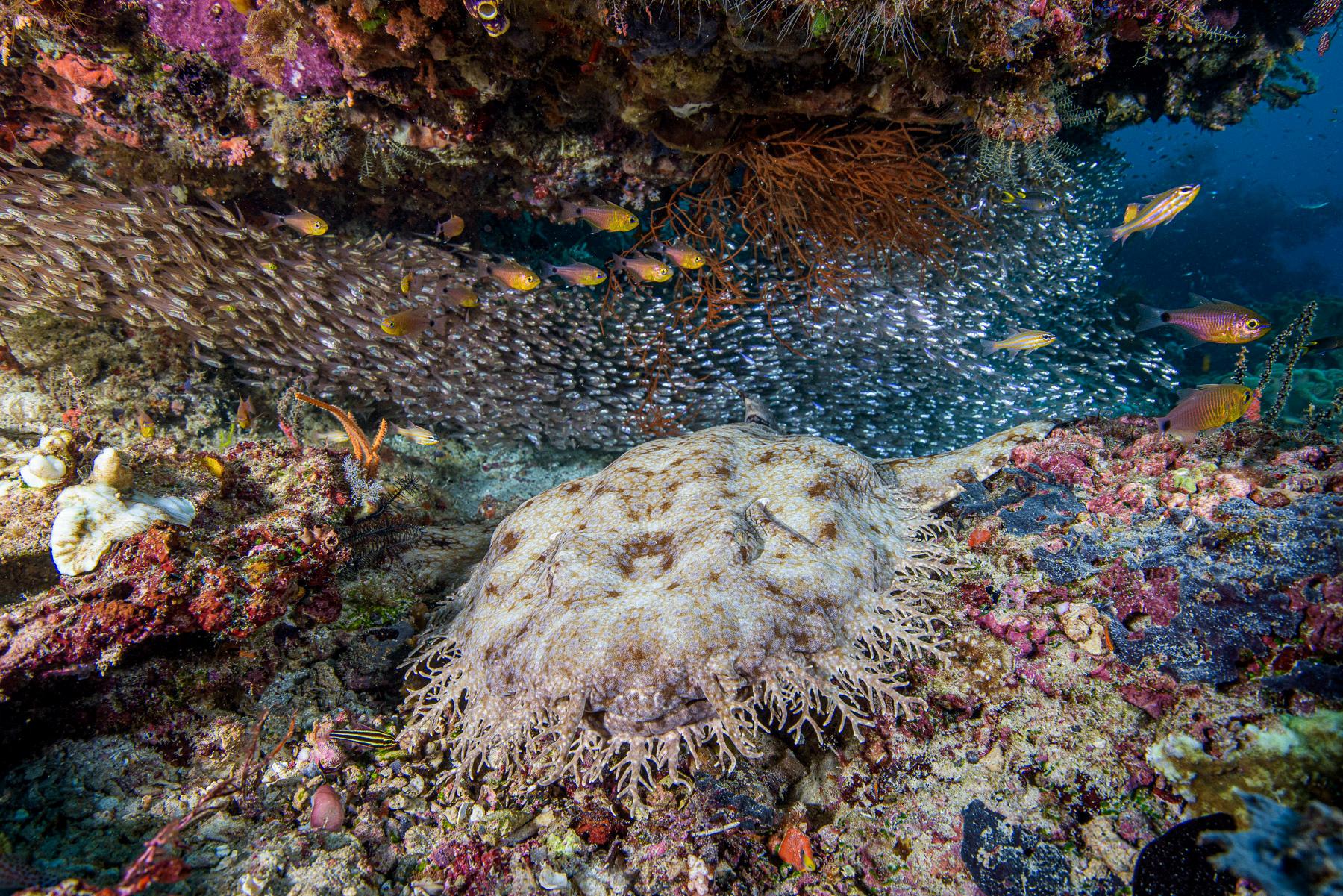
PARTING SHOT
RAOUL COSCIA | ASIATIC GLASSFISH
Mayhem Reef, Raja Ampat | Tasselled Wobbegong - Eucrossorhinus dasypogon | Asiatic Glassfish –Ambassidae, also Chandidae
My dive guide and I became separated from the group by a strong current at the start of the dive and we eventually drifted to an area where it slowed down completely After not seeing anything particularly interesting for most of the dive, aside from a turtle munching on some coral, these schooling glassfish congregating around a rocky ledge caught our attention Moving in closer, my guide spotted this perfectly camouflaged Tasselled Wobbegong shark resting motionless on the seabed, with its blotchy colouration and branched skin flaps disguising its mouth and head, blended perfectly into the surroundings This member of the carpet shark family is nocturnal and only active at night, resting in caves or under ledges during the day with its tail curled up It’s a supreme ambush predator, and when unsuspecting prey strays close enough, it lunges up at lightning speed, causing a pressure difference in the water which creates suction and engulfs its catch whole into its mouth This was one of my favourite photo-ops on the trip because it was my best chance to photograph this very chilled Wobbegong without the presence of other divers in a small area which could potentially disturb the shark, and also because these cute schooling Glassfish are one of my favourite underwater subjects due to the amazing patterns and shapes they create as they swirl around
Equipment: Nikon D810 + Nikkor 16-35mm f/40, Isotta Housing | 1/200 sec f/11 ISO 500 | Lighting: 2x Inon Z-330 with diffusers

































 ORTINS’ LIGHT POINTS TO THE 76 MM CALIBRE BOW GUN OF THE TUGBOAT URSUS, A HIGHLIGHT OF THE
ORTINS’ LIGHT POINTS TO THE 76 MM CALIBRE BOW GUN OF THE TUGBOAT URSUS, A HIGHLIGHT OF THE WRECK OFF VIS, CROATIA | WRECK OFF VIS, CROATIA. | © BECKY KAGAN SCHOTT © BECKY KAGAN SCHOTT
ORTINS DIVES A STEEPLY SLOPING WALL IN CROATIA.
ORTINS DIVES A STEEPLY SLOPING WALL IN CROATIA. || © BECKY KAGAN SCHOTT © BECKY KAGAN SCHOTT
ORTINS’ LIGHT POINTS TO THE 76 MM CALIBRE BOW GUN OF THE TUGBOAT URSUS, A HIGHLIGHT OF THE
ORTINS’ LIGHT POINTS TO THE 76 MM CALIBRE BOW GUN OF THE TUGBOAT URSUS, A HIGHLIGHT OF THE WRECK OFF VIS, CROATIA | WRECK OFF VIS, CROATIA. | © BECKY KAGAN SCHOTT © BECKY KAGAN SCHOTT
ORTINS DIVES A STEEPLY SLOPING WALL IN CROATIA.
ORTINS DIVES A STEEPLY SLOPING WALL IN CROATIA. || © BECKY KAGAN SCHOTT © BECKY KAGAN SCHOTT









































































 ILARDO PREPARES TO WORK WITH ANCIENT DNA IN THE CLEAN LAB FACILITIES AT THE
ILARDO PREPARES TO WORK WITH ANCIENT DNA IN THE CLEAN LAB FACILITIES AT THE

















 STEPHEN FRINK PLACES HIS HOUSED CAMERA WITHIN THE VIEWING SLOT OF THE SURFACE CAGE
STEPHEN FRINK PLACES HIS HOUSED CAMERA WITHIN THE VIEWING SLOT OF THE SURFACE CAGE


























 GHOST GOBY, YILLIET CORNER, RAJA AMPAT, WEST PAPUA GHOST GOBY, YILLIET CORNER, RAJA AMPAT, WEST PAPUA
JUVENILE SCORPION FISH, SAPORKREN SURPRISE, RAJA AMPAT, WEST PAPUA JUVENILE SCORPION FISH, SAPORKREN SURPRISE, RAJA AMPAT, WEST PAPUA
GHOST GOBY, YILLIET CORNER, RAJA AMPAT, WEST PAPUA GHOST GOBY, YILLIET CORNER, RAJA AMPAT, WEST PAPUA
JUVENILE SCORPION FISH, SAPORKREN SURPRISE, RAJA AMPAT, WEST PAPUA JUVENILE SCORPION FISH, SAPORKREN SURPRISE, RAJA AMPAT, WEST PAPUA
 BLENNY, SMITSWINKEL BAY WRECK, CAPE PENINSULA BLENNY, SMITSWINKEL BAY WRECK, CAPE PENINSULA
BLENNY, SMITSWINKEL BAY WRECK, CAPE PENINSULA BLENNY, SMITSWINKEL BAY WRECK, CAPE PENINSULA


 RED SEA SAILFIN TANGS, RAS UM SID, EGYPT
RED SEA SAILFIN TANGS, RAS UM SID, EGYPT
SWEETLIPS, SAWANDAREK JETTY, RAJA AMPAT, WEST PAPUA
SWEETLIPS, SAWANDAREK JETTY, RAJA AMPAT, WEST PAPUA
RED SEA SAILFIN TANGS, RAS UM SID, EGYPT
RED SEA SAILFIN TANGS, RAS UM SID, EGYPT
SWEETLIPS, SAWANDAREK JETTY, RAJA AMPAT, WEST PAPUA
SWEETLIPS, SAWANDAREK JETTY, RAJA AMPAT, WEST PAPUA













